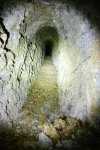You are using an out of date browser. It may not display this or other websites correctly.
You should upgrade or use an alternative browser.
You should upgrade or use an alternative browser.
AdventureTaco - turbodb's build and adventures
- Thread starter turbodb
- Start date
turbodb
Well-known member
Thanks! Most of the time, I don't even use my flash - I find that it adds an unnatural light, so I just try to use long exposures. But, sometimes I have to use a flash if there's not enough light around... which is going to be an issue with a new flashless camera I just picked up. Better remember to bring a flashlight now to light paint!The lighting on your mine pictures is excellent.
Did you use anything other than the flash on your camera?
Thanks for all your postings.
I use a cordless Rigid light for some of my AZ mine pics
View attachment 637467
turbodb
Well-known member
Unfinished Business #2 - Highest Truck in Oregon
Hoping to catch the stars as they danced through the sky, you may recall that I'd setup the camera to take as many 30 second exposures as it could, until its battery ran out, through the cold night. As morning rolled around, I grabbed a second camera battery and popped out of the tent into the 21°F weather to take a look.
...Only to discover that my second battery was also dead - I'd forgotten to charge it before the trip! ? So I plugged in the my little 175W inverter and let a battery charge for an hour. As a side note, I should say that I really like this inverter. Plenty of power for charging camera batteries and my laptop, and no cooling fan so it's completely quiet. I won't be running any hair dryers with it, but that's just fine with me.
Battery charged and another hour of warmth for me, I finally had a chance to check out the previous nights display. Not. Too. Shabby. At all.
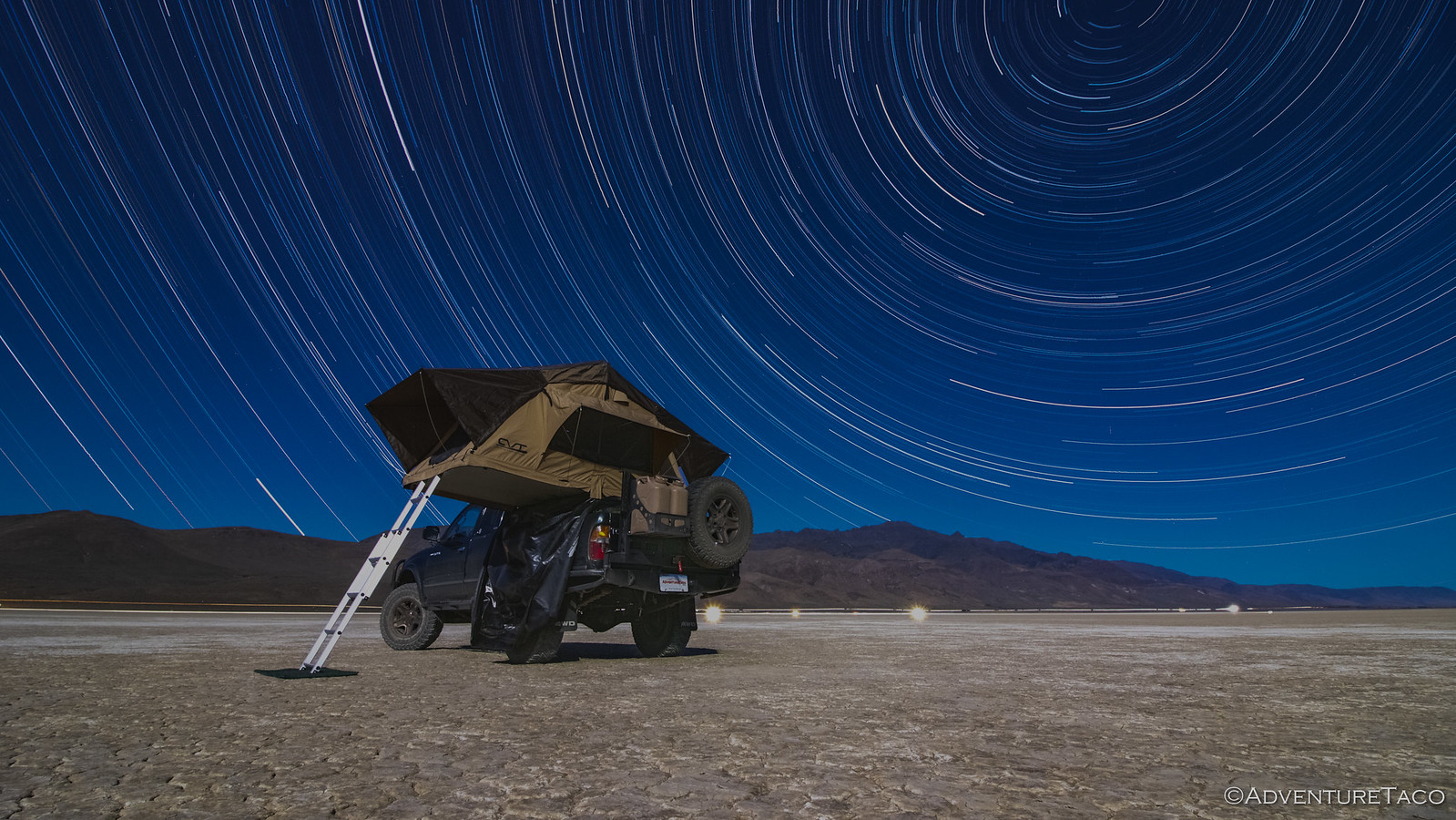
It was a great start to the day, and with the sun now up and warming the playa to a blistering 26°F, we found ourselves out of the tent attempting to eat a bowl of cereal before it froze. ? Moving quickly so we could climb in the heated truck, we were soon on our way - a quick stop for a photo of our so-close-but-so-far destination before we headed south to start the ascent up to the highest road in Oregon.

Now, as one should always do, I'd done my best to plan an all-dirt route from the Alvord Playa to the top of Steens Mountain. Most of the land around each - since they are essentially next to each other - is a sprinkling of BLM and private land. And usually that's not a problem - ranchers are generally pretty good, at least in these parts, of leaving gates unlocked and relying on responsible use - closing gates that you open, etc.
So, as we headed off the main drag an onto our first road onto the mountain along Carlson Creek, we were glad to see that while there was a gate, it was unlocked and a sign posted by the BLM noted the various allowed uses - driving included. So we drove through, aired down, and were on our way...

Apparently however, that "driving" was only for the first mile - at which point a locked gate across the road and a smaller opening for hikers and hunters. Well shoot.

Now, a mile or two out of our way is nothing to be concerned with - generally. So we took a look at our offline map and planned route - and noted that just a couple miles down the main road there was another entrance to the mountain...which eventually rejoined the road we'd planned to take up Carlson Creek. And so with that, we were off to Bone Creek and attempt #2 at summiting the highest road in the state.

Where we were almost immediately turned around on Carlson Creek, Bone Creek was just the opposite and we continued to climb up into the hills for several miles, marveling at our ability to adapt, patting ourselves on the back. We were - you might say - counting our chickens.
And that seemed to be working just fine. We passed through several gates - some of them open and some not - without incident, none of them locked. We rejoined the original road/route about six miles in and then turned up towards the top of the first ridge we'd climb on our way to Steens. We summited that ridge and took in the views back towards the playa.
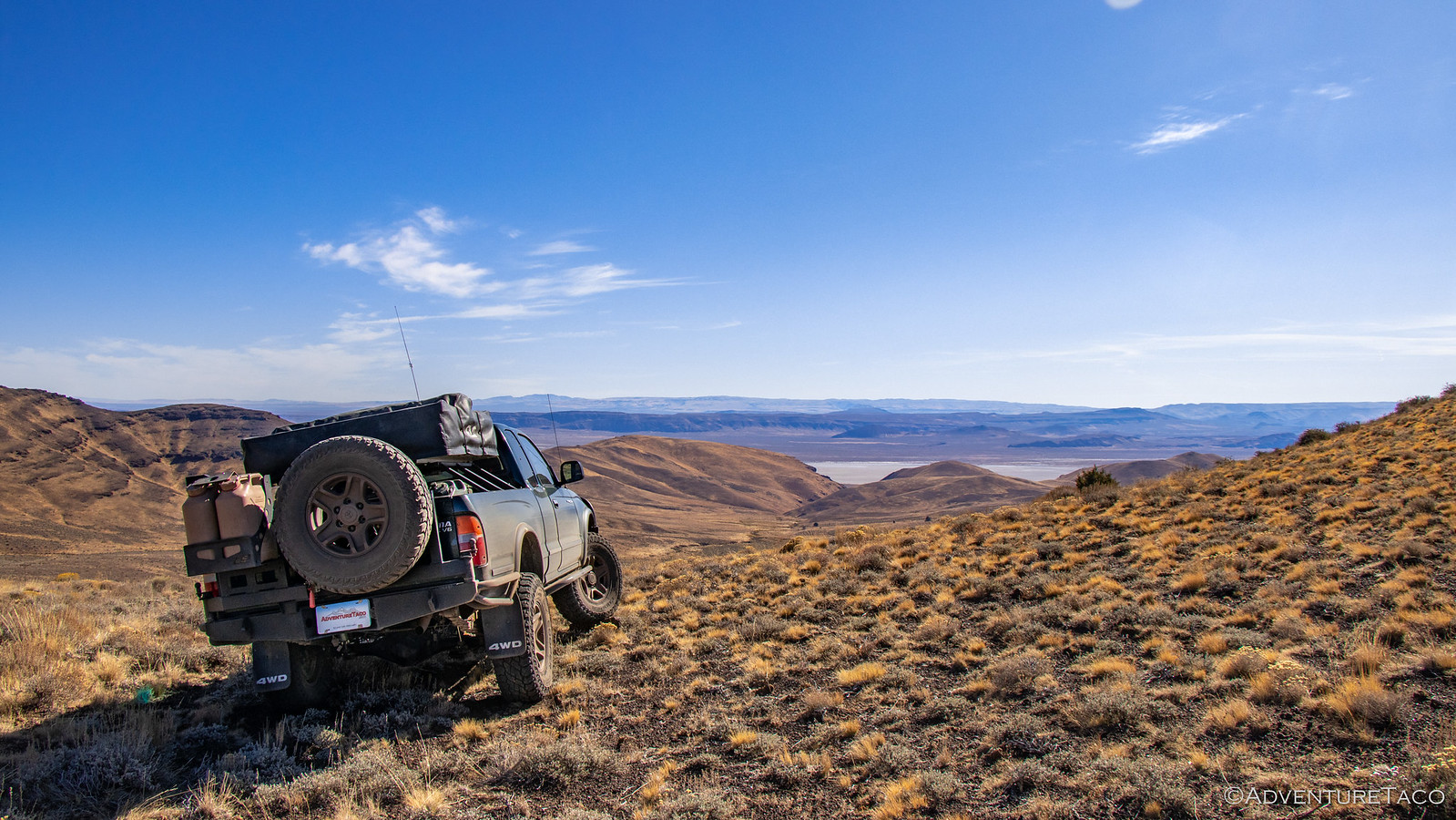
And then, our chickens bit back. Not 100 yards down the west side of the ridge - a locked gate for the Roaring Springs Ranch. The bummer was that the sign had a note that hunting (and thus travel) was sometimes allowed via written permission - which may have come with a key - but I'd not contacted them prior to the trip, so we were keyless, and now another hour+ behind schedule.
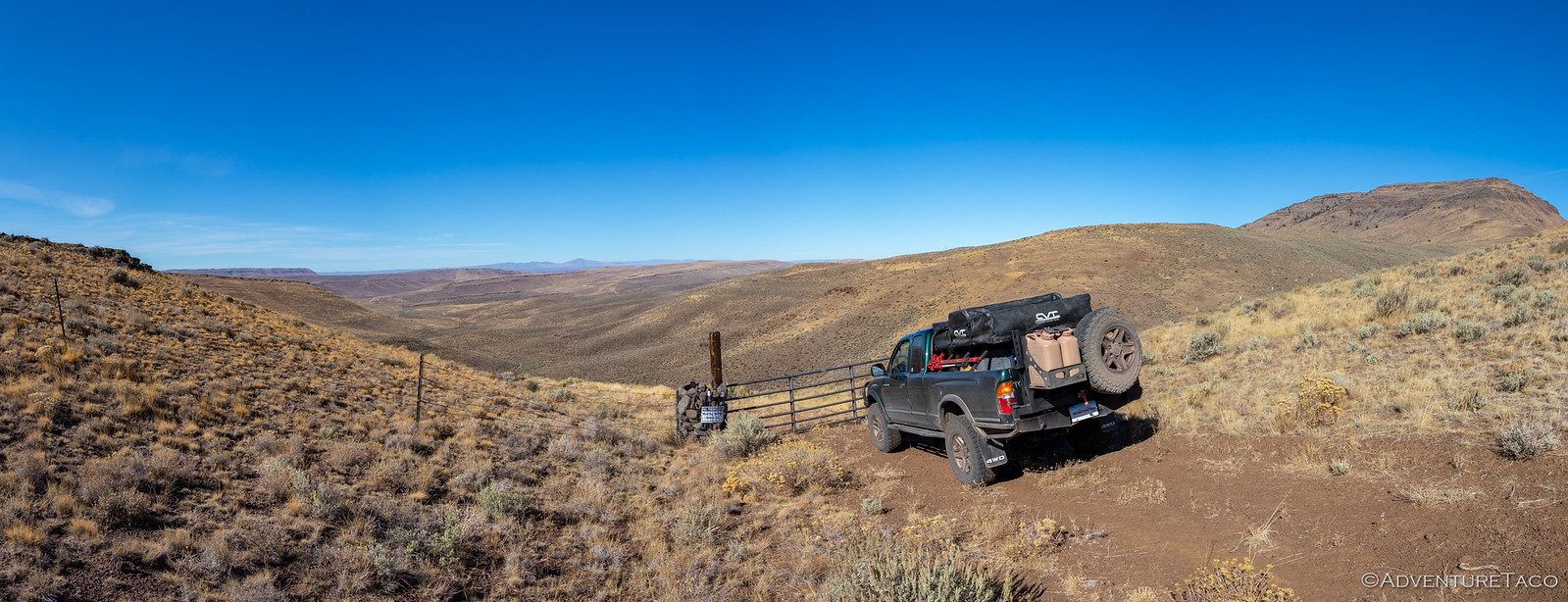
That's just part of the adventure though, so we turned around and headed back down. This had been our last hope of reaching Steens Mountain Loop on dirt, so it was time to air up, grab some fuel at Fields Station, and use the skinny pedal liberally to try and make up a bit of time.

My liberal use of the skinny pedal is apparently different than most, and so it was a little after 12:30pm when we finally arrived at Steens Mountain Loop and started up in earnest. We were both hungry at this point, and so only a few stops were made over the next 20 miles - for some wild horses and our first view of the snowy summit - just so we could put a few miles behind us before we stopped again!



Now, about 20 miles up the south side of the loop, there's a turn-off. This leads to the Riddle Brothers Ranch, and was something I'd thought we should do when I planned the trip. @mrs.turbodb had come to the same conclusion when reading her book - 100 Hikes / Travel Guide: Eastern Oregon - and we were glad to hear that it was open "from mid-June through October." It was October 12, so that was perfect.
Except that "through October" at the Riddle Brothers Ranch actually means "not through October," because a little more than a mile from the ranch, the gate was closed! We were batting 1.000 on the locked gates, that's for sure.
Luckily in this case there were plenty of signs inviting us to walk around and make the two-mile roundtrip on foot, so we ate a quick lunch and then got underway.
Almost immediately, we saw the first cabin. It belonged to Ben Riddle - the youngest of the bunch - who arrived in 1896 to make the ranch his home. His brothers - Walt and Fred - followed a few years later and worked the land, producing 150 tons of hay each year which was sold along with mules and horses to the U.S. Cavalry for WWI.


Though he was the youngest, Ben also was the first to die - of suicide in 1915 - after several bouts with depression. His brother Fred would continue to ranch the land until he was 82 (in 1952), the livestock changing from mules and horses to cattle after The War.
We continued down the Little Blitzen River towards Fred's house and the main ranch complex, the river a constant gurgle to our north, ice starting to creep further from its banks.

If Ben's cabin had been tiny and isolated, Fred's was anything but. Nicely constructed, he had several outbuildings, including a guest house, tack shop, and large barn - all of them in reasonably good condition now that the BLM has acquired the ranch and preserved much of what was left.
We took our time exploring.




Don't miss the rest of the story, and all the remaining photos that don't fit here (due to max post size). Hopefully that can change in the future, but until then...
.
Hoping to catch the stars as they danced through the sky, you may recall that I'd setup the camera to take as many 30 second exposures as it could, until its battery ran out, through the cold night. As morning rolled around, I grabbed a second camera battery and popped out of the tent into the 21°F weather to take a look.
...Only to discover that my second battery was also dead - I'd forgotten to charge it before the trip! ? So I plugged in the my little 175W inverter and let a battery charge for an hour. As a side note, I should say that I really like this inverter. Plenty of power for charging camera batteries and my laptop, and no cooling fan so it's completely quiet. I won't be running any hair dryers with it, but that's just fine with me.
Battery charged and another hour of warmth for me, I finally had a chance to check out the previous nights display. Not. Too. Shabby. At all.

It was a great start to the day, and with the sun now up and warming the playa to a blistering 26°F, we found ourselves out of the tent attempting to eat a bowl of cereal before it froze. ? Moving quickly so we could climb in the heated truck, we were soon on our way - a quick stop for a photo of our so-close-but-so-far destination before we headed south to start the ascent up to the highest road in Oregon.

Now, as one should always do, I'd done my best to plan an all-dirt route from the Alvord Playa to the top of Steens Mountain. Most of the land around each - since they are essentially next to each other - is a sprinkling of BLM and private land. And usually that's not a problem - ranchers are generally pretty good, at least in these parts, of leaving gates unlocked and relying on responsible use - closing gates that you open, etc.
So, as we headed off the main drag an onto our first road onto the mountain along Carlson Creek, we were glad to see that while there was a gate, it was unlocked and a sign posted by the BLM noted the various allowed uses - driving included. So we drove through, aired down, and were on our way...

Apparently however, that "driving" was only for the first mile - at which point a locked gate across the road and a smaller opening for hikers and hunters. Well shoot.

Now, a mile or two out of our way is nothing to be concerned with - generally. So we took a look at our offline map and planned route - and noted that just a couple miles down the main road there was another entrance to the mountain...which eventually rejoined the road we'd planned to take up Carlson Creek. And so with that, we were off to Bone Creek and attempt #2 at summiting the highest road in the state.

Where we were almost immediately turned around on Carlson Creek, Bone Creek was just the opposite and we continued to climb up into the hills for several miles, marveling at our ability to adapt, patting ourselves on the back. We were - you might say - counting our chickens.
And that seemed to be working just fine. We passed through several gates - some of them open and some not - without incident, none of them locked. We rejoined the original road/route about six miles in and then turned up towards the top of the first ridge we'd climb on our way to Steens. We summited that ridge and took in the views back towards the playa.

And then, our chickens bit back. Not 100 yards down the west side of the ridge - a locked gate for the Roaring Springs Ranch. The bummer was that the sign had a note that hunting (and thus travel) was sometimes allowed via written permission - which may have come with a key - but I'd not contacted them prior to the trip, so we were keyless, and now another hour+ behind schedule.

That's just part of the adventure though, so we turned around and headed back down. This had been our last hope of reaching Steens Mountain Loop on dirt, so it was time to air up, grab some fuel at Fields Station, and use the skinny pedal liberally to try and make up a bit of time.

My liberal use of the skinny pedal is apparently different than most, and so it was a little after 12:30pm when we finally arrived at Steens Mountain Loop and started up in earnest. We were both hungry at this point, and so only a few stops were made over the next 20 miles - for some wild horses and our first view of the snowy summit - just so we could put a few miles behind us before we stopped again!



Now, about 20 miles up the south side of the loop, there's a turn-off. This leads to the Riddle Brothers Ranch, and was something I'd thought we should do when I planned the trip. @mrs.turbodb had come to the same conclusion when reading her book - 100 Hikes / Travel Guide: Eastern Oregon - and we were glad to hear that it was open "from mid-June through October." It was October 12, so that was perfect.
Except that "through October" at the Riddle Brothers Ranch actually means "not through October," because a little more than a mile from the ranch, the gate was closed! We were batting 1.000 on the locked gates, that's for sure.
Luckily in this case there were plenty of signs inviting us to walk around and make the two-mile roundtrip on foot, so we ate a quick lunch and then got underway.
Almost immediately, we saw the first cabin. It belonged to Ben Riddle - the youngest of the bunch - who arrived in 1896 to make the ranch his home. His brothers - Walt and Fred - followed a few years later and worked the land, producing 150 tons of hay each year which was sold along with mules and horses to the U.S. Cavalry for WWI.


Though he was the youngest, Ben also was the first to die - of suicide in 1915 - after several bouts with depression. His brother Fred would continue to ranch the land until he was 82 (in 1952), the livestock changing from mules and horses to cattle after The War.
We continued down the Little Blitzen River towards Fred's house and the main ranch complex, the river a constant gurgle to our north, ice starting to creep further from its banks.

If Ben's cabin had been tiny and isolated, Fred's was anything but. Nicely constructed, he had several outbuildings, including a guest house, tack shop, and large barn - all of them in reasonably good condition now that the BLM has acquired the ranch and preserved much of what was left.
We took our time exploring.

A screened porch and small guest house made for some nice livin'.


Table's set for the next meal in a reasonably well appointed kitchen.

Don't miss the rest of the story, and all the remaining photos that don't fit here (due to max post size). Hopefully that can change in the future, but until then...
Keep reading the rest here
Unfinished Business #2 - Highest Truck in Oregon
Unfinished Business #2 - Highest Truck in Oregon
.
turbodb
Well-known member
Unfinished Business #3 - We Find Jessi Combs Last Track
The night wasn't quite as cold as the previous had been, but it was still well below freezing when I looked out the tent door to see an amazing glow on the horizon. Whether I liked it or not, I knew I was going to spend at least a few minutes out there as the light started to spread across the Alvord Playa - before hoping I wouldn't be in too much trouble for climbing back into bed to warm up again.
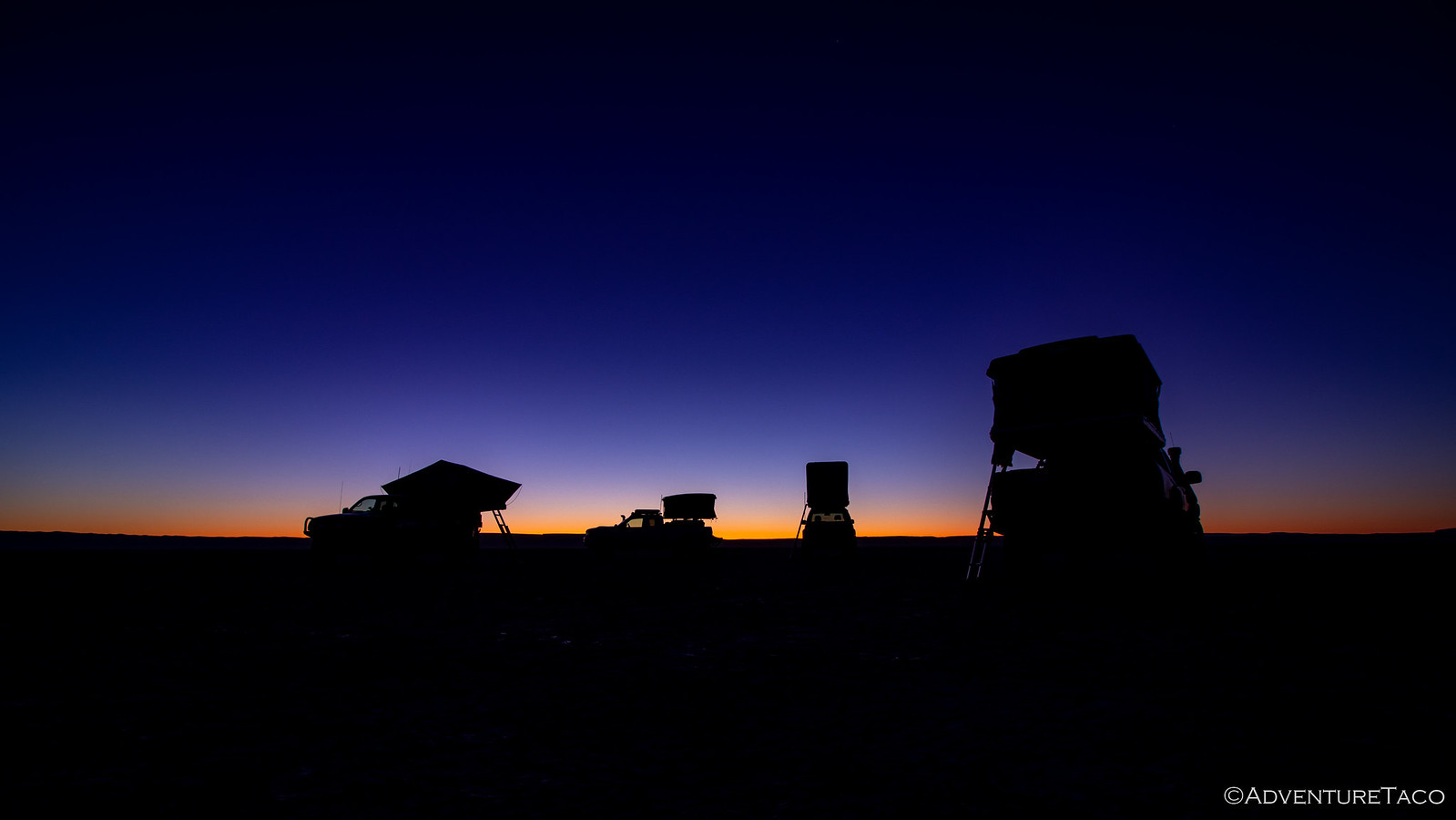

The cold had gotten to everyone overnight, which meant that they were either driven out of their tent early - like Nate @nateshrum - or remained bundled up as long as possible - ahem, Ben @m3bassman and Will @willhaman21. Regardless, by a little after 8:00am, everyone was up and moving about - the first look of the playa in the daylight, with Steens Mountain rising up behind it, understandably exciting for the newcomers.

Ben at some point decided to drive his truck around a bit - not all that fast though, so I'm not sure what he was really up to. Nor was Venice - his travel partner for the trip - as she took off after him rather than being left behind.



Though the Playa will heal itself over winter, this little display didn't go un-admonished by me. Though, I guess the front brakes are working just fine.
Breakfast was the next order of business and while @mrs.turbodb and I had cereal and granola bars, Nate fired up his stove and put together what looked like a seriously tasty breakfast burrito for the rest of the crew. The three of them would end up cooking most meals together, which is something the groups I'm out with don't generally do, but seemed to work well - at least for the one day they were there! (And is not all that different than how we often do a group breakfast or two, now that I think about it.)
This was also the point where Nate pulled out his drone. This of course caused much ogling - since drones still seem reasonably rare - and if I'm honest, a bit of concern from my point of view. It's not that I don't like drones - I think they are pretty cool and you can do amazing things with them - but I didn't want a day full of stops to launch the drone, staging of the trucks for the perfect trailing shot, etc. - because we had plenty to keep us busy, and we'd be stopping enough for photos as it was. As it turned out, this wouldn't end up being an issue at all however, because the drone's SD card was MIA.

And with that, we set about the important - and frankly required - task of speeding across the dry lake bed. For anyone who hasn't been, it's hard to describe the surreal experience that racing across the playa provides. You're literally pushing your truck as fast as it'll go - and you can see the ground immediately around you racing by at 80+ mph - but all of the landmarks in the distance appear completely stationary. It is truly a bit disconcerting. And it's also a blast.




We spent a good hour - or more - making our way around and over various parts of the playa; our GPS track looked as though a toddler had been scribbling frantically with a large crayon - no rhyme or reason evident in our movement. But, we were on a mission - one that was ultimately a success. Just a couple months before - August 27th on this very playa - Jessi Combs [wikipedia] [jessicombs.com] had arrived to make an attempt at the women's land speed record. The previous record had been set here in 1976 - some 43 years earlier - by Kitty O'Neil. Driving the North American Eagle, Jessi Combs hoped to break that across the same ground. Unfortunately - in a tragic accident, she was unable to stop the jet car as it reached speeds over 550 mph on the playa, and she was killed in the aftermath.


All of our searching was to pay our respects. Eventually, in the south west corner of the playa, we found what we were looking for. Three distinct impressions of Jessi's final runs.

Making one more pass across the playa, we followed the tracks to their end in the north east corner. She'd used as much of the playa as she was able, on each of several runs. We milled around for a bit here at the end - taking in the views and wondering aloud about what had transpired - before eventually continuing on our way.
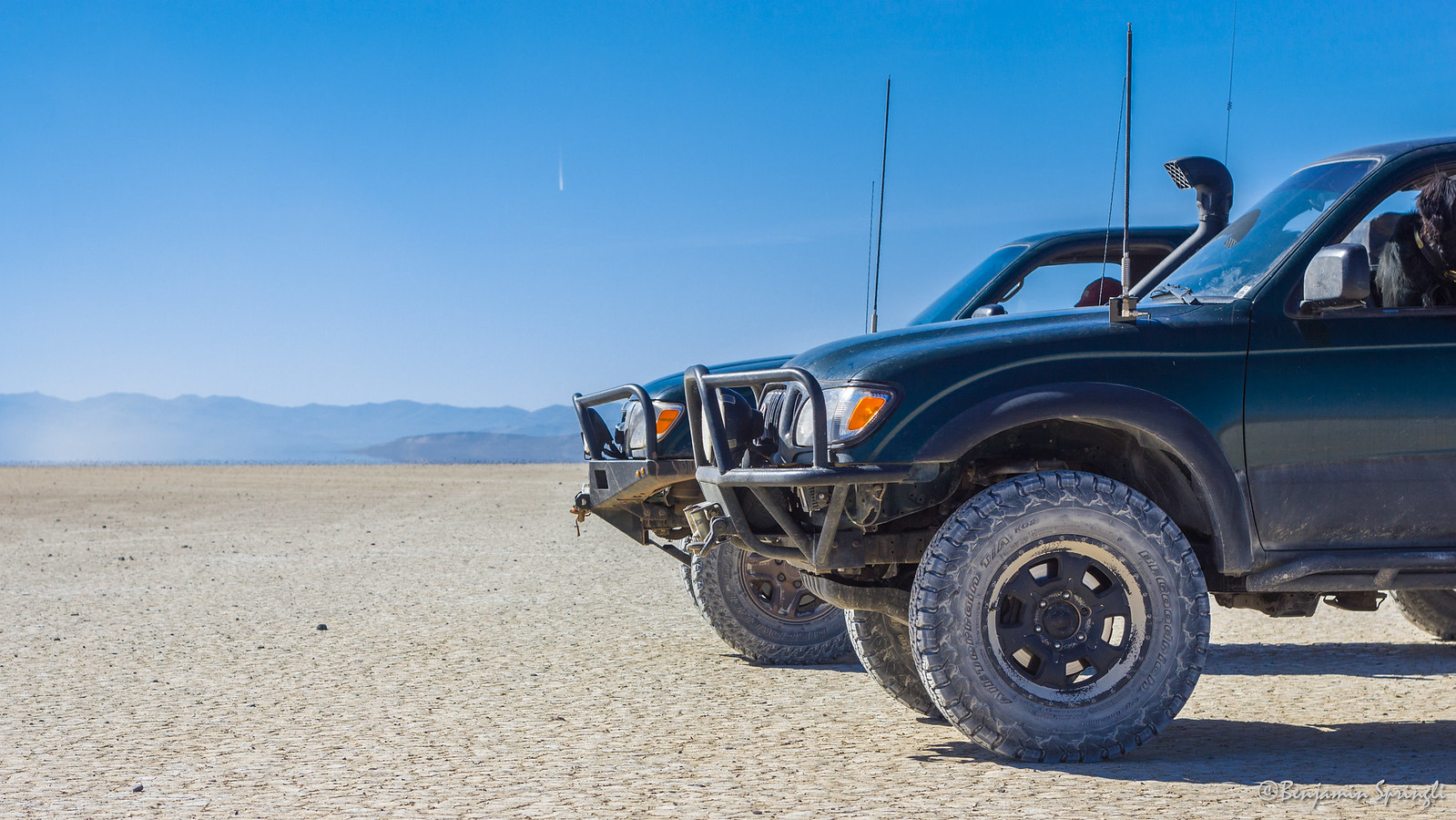


Now nearing noon, our next destination was surely easier to find. One of the most prominent land features of the playa, Big Sand Gap was formed when - during the Ice Age - this desert’s basin filled with a 30-mile-long lake. When the water finally spilled out, it did so here - at Big Sand Gap - launching a colossal flood that roared down the Snake and Columbia Rivers to the sea. With three additional trucks in tow this time, @mrs.turbodb and I also hoped it also led to redemption from our last trip.
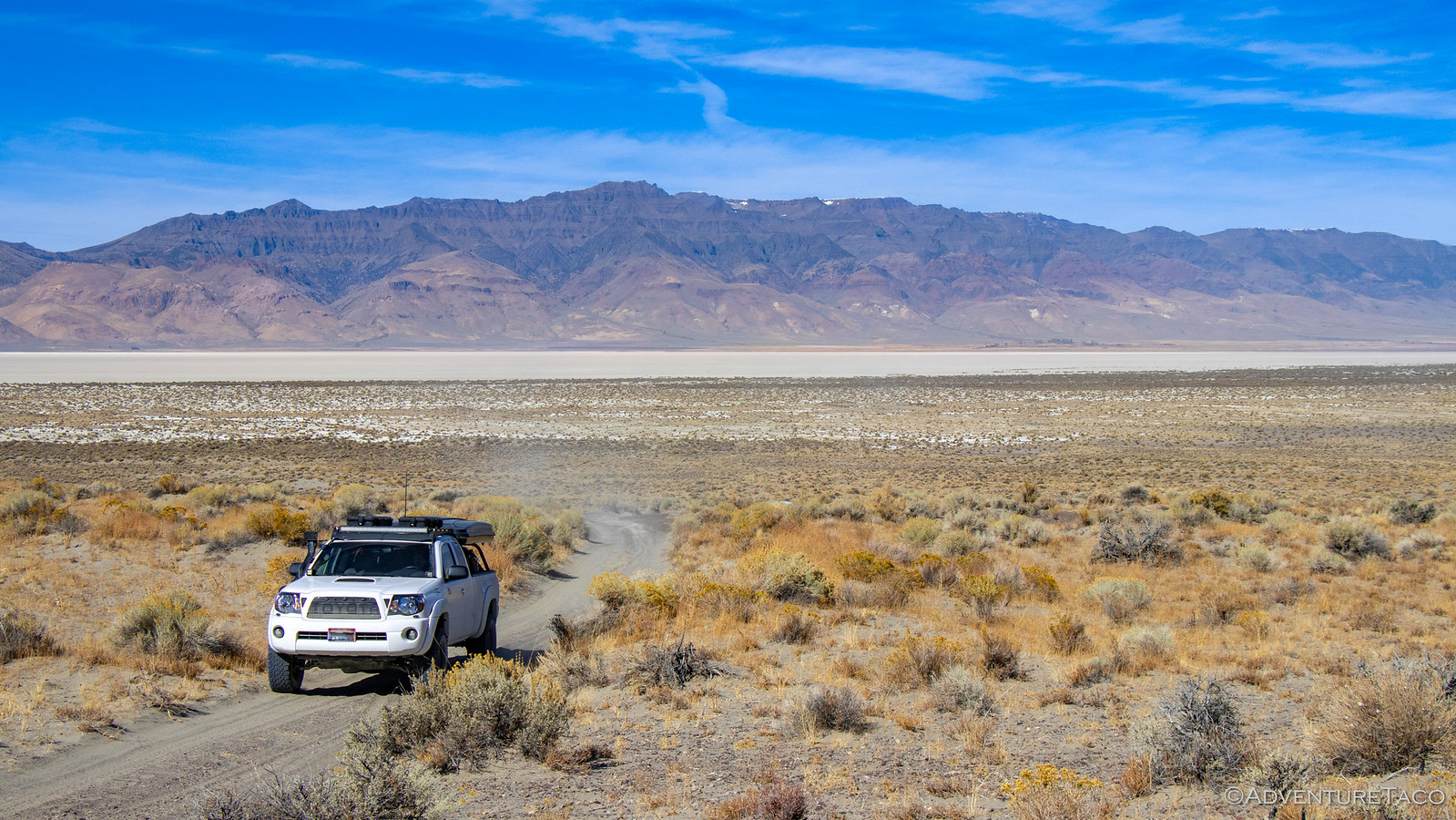
Don't miss the rest of the story, and all the remaining photos that don't fit here (due to max post size). Hopefully that can change in the future, but until then...
.
The night wasn't quite as cold as the previous had been, but it was still well below freezing when I looked out the tent door to see an amazing glow on the horizon. Whether I liked it or not, I knew I was going to spend at least a few minutes out there as the light started to spread across the Alvord Playa - before hoping I wouldn't be in too much trouble for climbing back into bed to warm up again.


The cold had gotten to everyone overnight, which meant that they were either driven out of their tent early - like Nate @nateshrum - or remained bundled up as long as possible - ahem, Ben @m3bassman and Will @willhaman21. Regardless, by a little after 8:00am, everyone was up and moving about - the first look of the playa in the daylight, with Steens Mountain rising up behind it, understandably exciting for the newcomers.

Ben at some point decided to drive his truck around a bit - not all that fast though, so I'm not sure what he was really up to. Nor was Venice - his travel partner for the trip - as she took off after him rather than being left behind.



Though the Playa will heal itself over winter, this little display didn't go un-admonished by me. Though, I guess the front brakes are working just fine.
Breakfast was the next order of business and while @mrs.turbodb and I had cereal and granola bars, Nate fired up his stove and put together what looked like a seriously tasty breakfast burrito for the rest of the crew. The three of them would end up cooking most meals together, which is something the groups I'm out with don't generally do, but seemed to work well - at least for the one day they were there! (And is not all that different than how we often do a group breakfast or two, now that I think about it.)
This was also the point where Nate pulled out his drone. This of course caused much ogling - since drones still seem reasonably rare - and if I'm honest, a bit of concern from my point of view. It's not that I don't like drones - I think they are pretty cool and you can do amazing things with them - but I didn't want a day full of stops to launch the drone, staging of the trucks for the perfect trailing shot, etc. - because we had plenty to keep us busy, and we'd be stopping enough for photos as it was. As it turned out, this wouldn't end up being an issue at all however, because the drone's SD card was MIA.

And with that, we set about the important - and frankly required - task of speeding across the dry lake bed. For anyone who hasn't been, it's hard to describe the surreal experience that racing across the playa provides. You're literally pushing your truck as fast as it'll go - and you can see the ground immediately around you racing by at 80+ mph - but all of the landmarks in the distance appear completely stationary. It is truly a bit disconcerting. And it's also a blast.




We spent a good hour - or more - making our way around and over various parts of the playa; our GPS track looked as though a toddler had been scribbling frantically with a large crayon - no rhyme or reason evident in our movement. But, we were on a mission - one that was ultimately a success. Just a couple months before - August 27th on this very playa - Jessi Combs [wikipedia] [jessicombs.com] had arrived to make an attempt at the women's land speed record. The previous record had been set here in 1976 - some 43 years earlier - by Kitty O'Neil. Driving the North American Eagle, Jessi Combs hoped to break that across the same ground. Unfortunately - in a tragic accident, she was unable to stop the jet car as it reached speeds over 550 mph on the playa, and she was killed in the aftermath.


All of our searching was to pay our respects. Eventually, in the south west corner of the playa, we found what we were looking for. Three distinct impressions of Jessi's final runs.

Making one more pass across the playa, we followed the tracks to their end in the north east corner. She'd used as much of the playa as she was able, on each of several runs. We milled around for a bit here at the end - taking in the views and wondering aloud about what had transpired - before eventually continuing on our way.



Now nearing noon, our next destination was surely easier to find. One of the most prominent land features of the playa, Big Sand Gap was formed when - during the Ice Age - this desert’s basin filled with a 30-mile-long lake. When the water finally spilled out, it did so here - at Big Sand Gap - launching a colossal flood that roared down the Snake and Columbia Rivers to the sea. With three additional trucks in tow this time, @mrs.turbodb and I also hoped it also led to redemption from our last trip.

Don't miss the rest of the story, and all the remaining photos that don't fit here (due to max post size). Hopefully that can change in the future, but until then...
Keep reading the rest here
Unfinished Business #3 - We Find Jessi Combs Last Track
Unfinished Business #3 - We Find Jessi Combs Last Track
.
turbodb
Well-known member
In Search of Overlooks - A Fall Trip to Western Death Valley #1
Death Valley is not nearby, and yet - it continues to call time after time, urging us to make the 20 hour journey south to explore its wonders. And it's hard to say no. That's how - on a Wednesday morning - we found ourselves packed up in the truck and heading towards southern California, excited for the three-and-a-half days we'd have to explore.
I promised myself that this trip would be different. We wouldn't attempt to squeeze everything in; I wouldn't over-schedule our time; it wouldn't be like it always is - a mad dash to not miss a thing. I'd do this by keeping us in the northwest corner of the park - in Eureka and Saline Valleys, and by planning at most a single morning and single afternoon "attraction."
Or so I thought.
By the end (literally, shortly after midnight) of our first full day of driving, we made it to Walker Lake. There are a couple of free BLM campgrounds along the edge of the lake, and though they are very close to the highway, @mrs.turbodb and I were both exhausted and decided that trying to make it two more hours to a spot we'd found outside of Dyer, NV to camp was just not in the cards. We climbed into the tent and within minutes we were both sound asleep.
Five hours later, at 5:30am, my alarm went off. Unlike most mornings, it wasn't set early to catch the sunrise, but was instead because we needed to get on the road if we were going to have time to do everything I'd planned for the day. (Yes, I realize now that this is perhaps not the approach that leads to a more relaxed trip.) Still, getting up early did have its benefits!


Intriguing sun shades provide relief to campers in the summer months.
By 9:00am, we'd fueled up in Dyer (Note: though the pumps appear closed before the store is open, hunt around and figure out how to use your credit card by lifting the rubber cover.) and were turning off onto dirt - our entrance into the park via North Eureka Valley Road, one that was new for @mrs.turbodb, and in my opinion the second nicest way into the park (because it's hard to beat Titus Canyon Rd.)
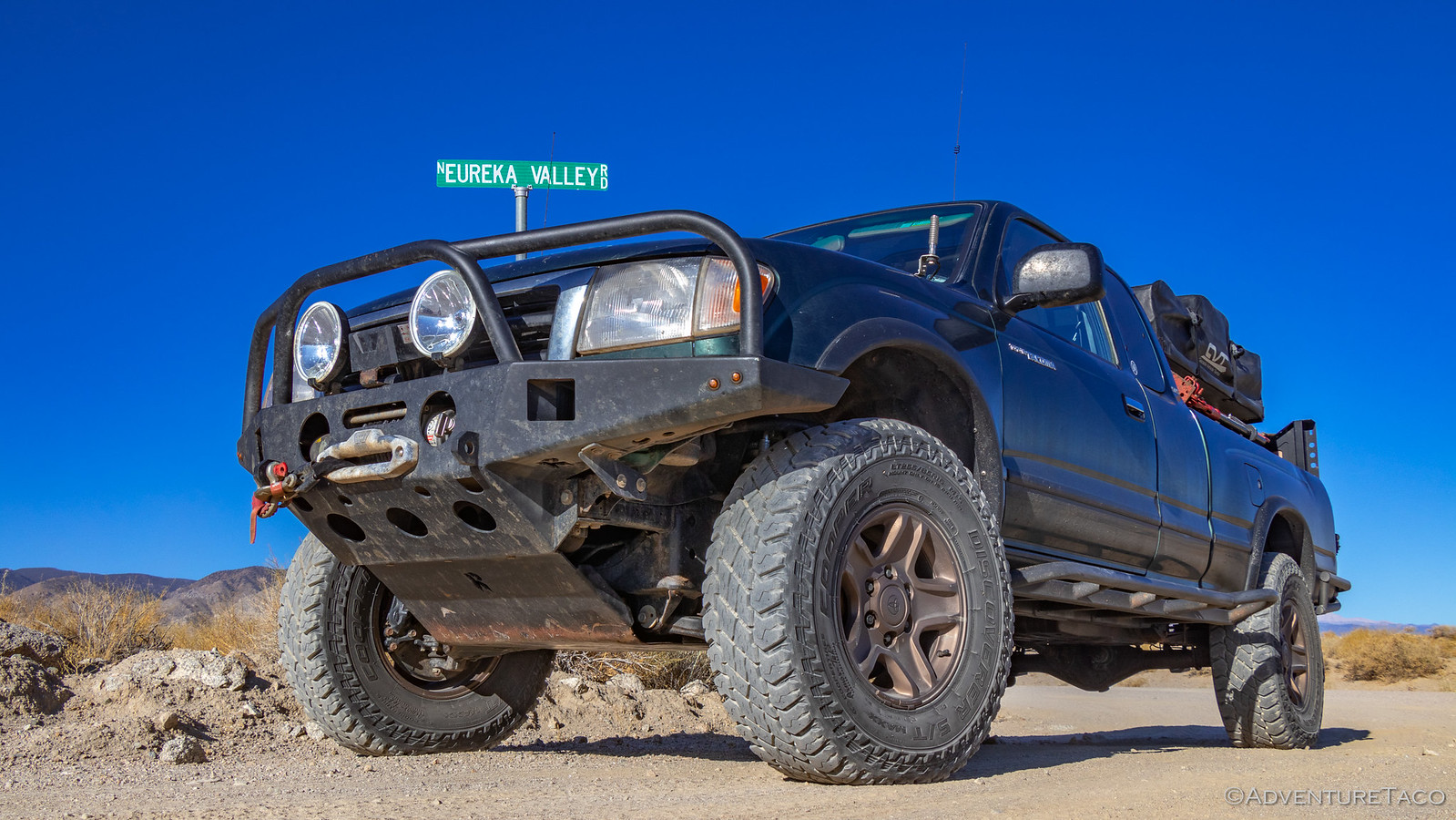
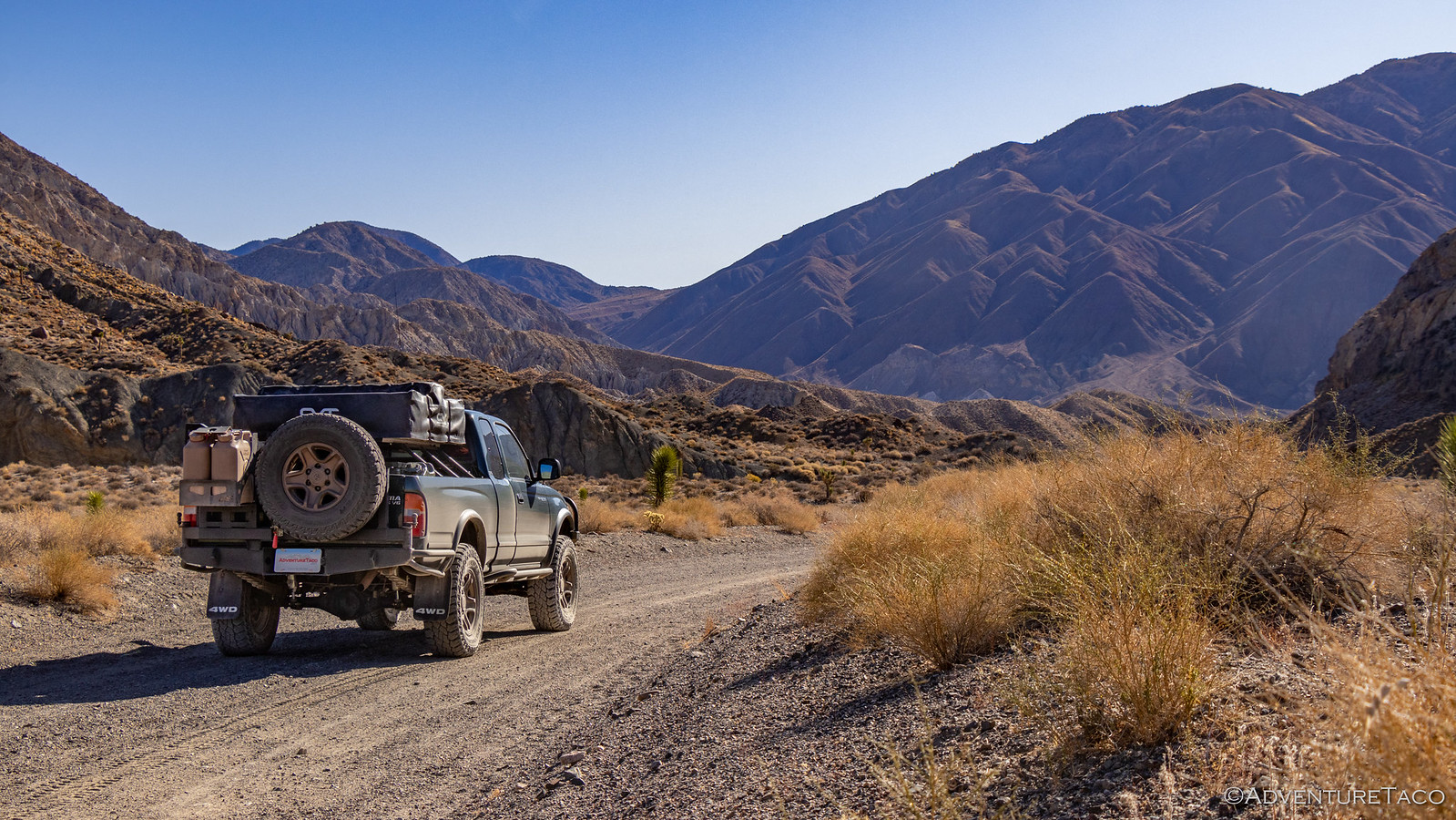

Under the warm morning sun we made good time, even with some photo stops for me, and geology stops for @mrs.turbodb, and it wasn't long before we reached the north end of Eureka Valley - the dunes where we'd be spending the night still just out of sight behind the north end of the Last Chance Range.
And they'd stay hidden a while longer, because our first destination was up in the mountains - to investigate the old sulfur mine and town site of Crater.

The Crater Mine - and its associated town - started operation in 1929 and produced 50,000 tons of pure sulfur by the time it closed down in 1969 (nearly 30% of all California's sulfur) and the area is still rich with the stinky stuff - some 3,000,000 tons of the stuff still left in the ground! (Hiking Western Death Valley)
As we pulled up to the mine site, the remnants of the last refinery were immediately visible in the middle of a barren playa. Over the course of mining here, twice there were sulfur dust explosions as the material was refined for transport. Most prominent were the crusher and retort, now laying like a lunar lander in the sulfur ore, its refractory bricks still lining the interior.


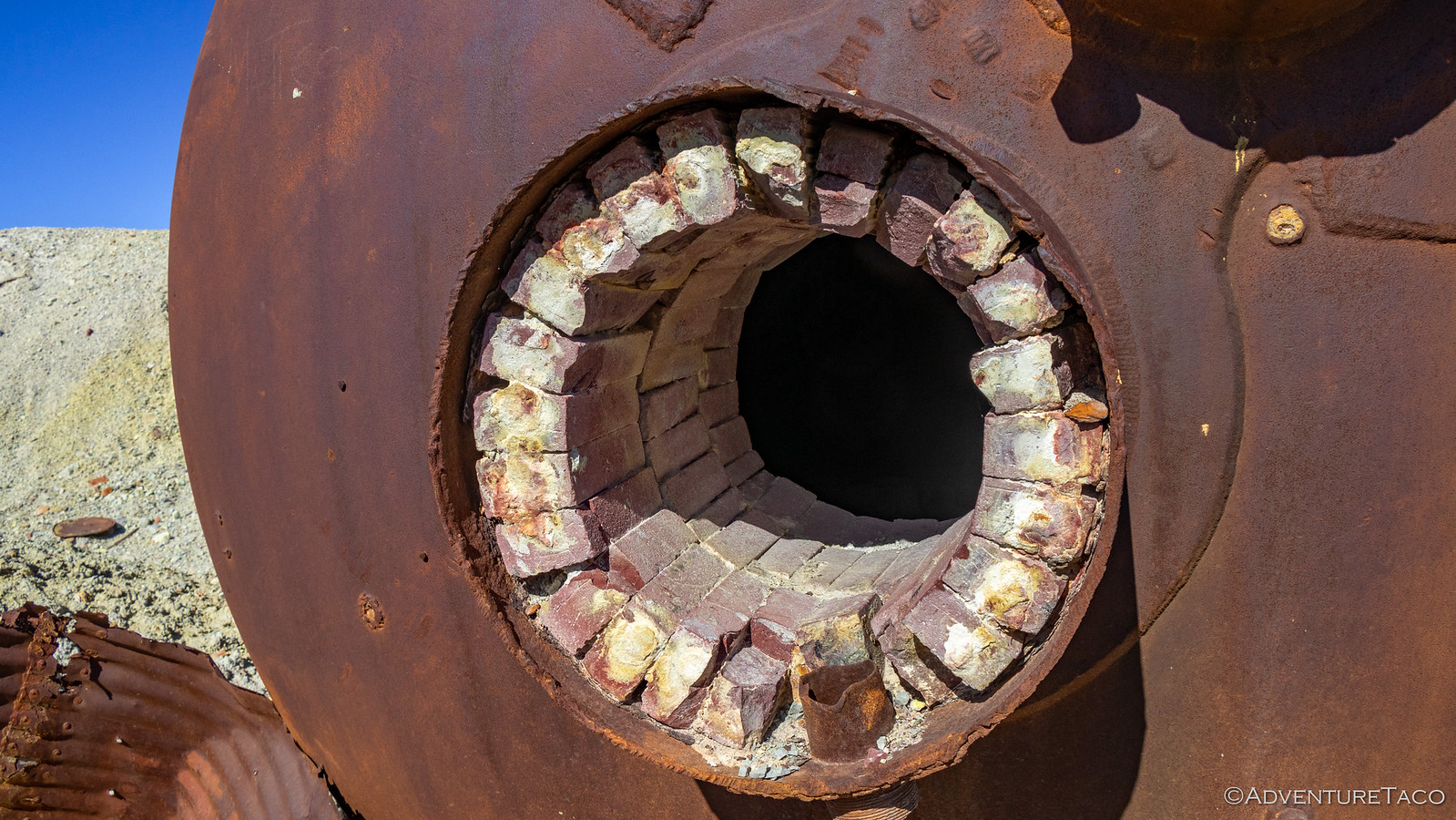
Wandering around, one could only wonder who kept passing gas as the sun's rays warmed the strikingly yellow ground around us, the light breeze only serving to waft the smell past our noses. ?

Most of the mines we find ourselves exploring are shaft-style mines, and Crater is one of the few pit mines that we've ever really walked around. The destruction of this style of mining was immediately apparent, the entire hillside having been carved out in search of quick profits.


Soon enough, we decided it was time to move on. Just up the hill was the old town site of the same name, all of its buildings reduced to piles of timber by the passing of time. Only three relics mark the town site today - some sort of old double-door cooler, a pair of water tanks, and a storage shed built into the hillside. In all honesty, probably not worth visiting if you want my opinion! :gossip:


Now, at this point, my plan had been that we'd eat lunch and then make our way back down into Eureka Valley so we could find a nice spot to camp and then make our way up the dunes. But @mrs.turbodb had gotten to reading Digonnet's Book, and well... there were several interesting things nearby that we decided we might as well add to the schedule.
So, after less than two hours in the park, our plan to keep things simple and not pack too much into a day went by the wayside. We were once again in full-on OMG there's so much to see mode.
Our first detour was to the El Captan Mine. This was an old Mercury mine, the 800-foot long shaft still completely open and easily large enough to drive a Tacoma into. Keen to stay alive, we refrained from such a foolish move - though curiosity did get the best of me and I walked in 50' or so - opting instead to drive up the hill through which the shaft passes to an enormous hole that was created at the other end.
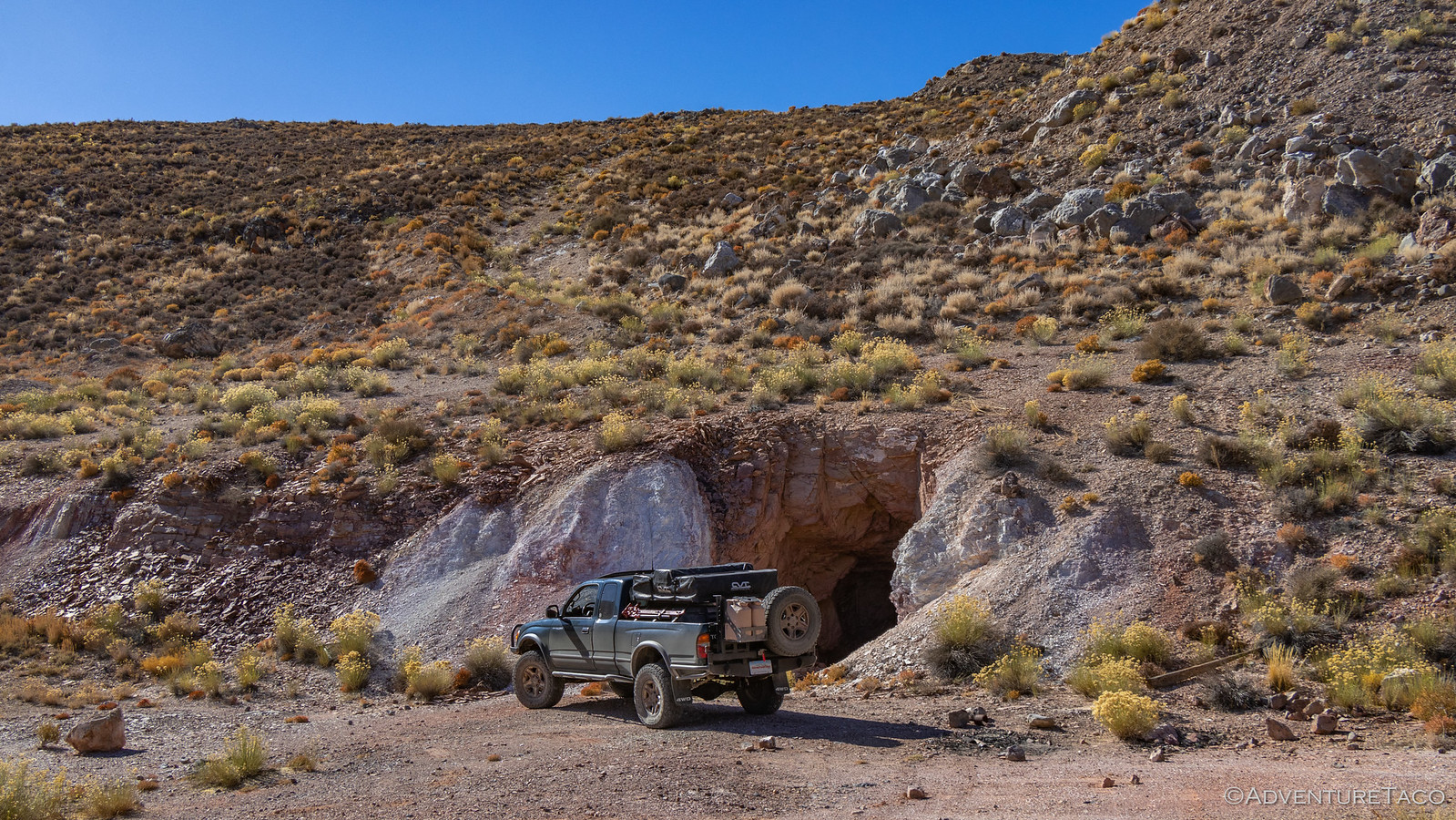
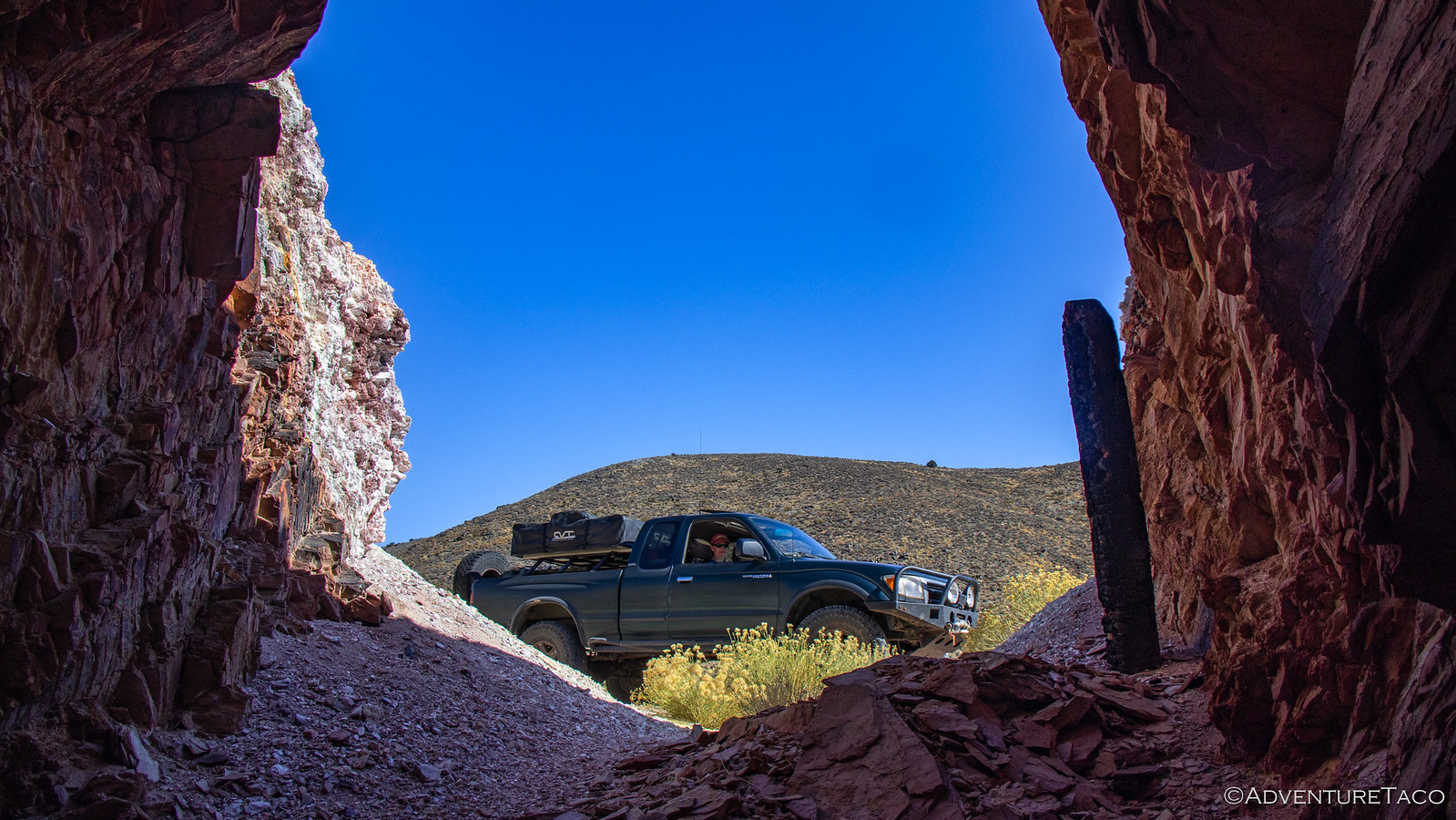

The hole was originally an access shaft that intersected the mine shaft 60-feet lower than its entrance, but when Mercury was found in the surrounding cinnabar ore, it became a glory hole - the material simply dropped down the hole to the end of the mine shaft where it could be hauled out. We kept ourselves out of this side of the mine altogether, its geological state clearly more precarious than the main shaft opening.

Don't miss the rest of the story, and all the remaining photos that don't fit here (due to max post size). Hopefully that can change in the future, but until then...
.
Death Valley is not nearby, and yet - it continues to call time after time, urging us to make the 20 hour journey south to explore its wonders. And it's hard to say no. That's how - on a Wednesday morning - we found ourselves packed up in the truck and heading towards southern California, excited for the three-and-a-half days we'd have to explore.
I promised myself that this trip would be different. We wouldn't attempt to squeeze everything in; I wouldn't over-schedule our time; it wouldn't be like it always is - a mad dash to not miss a thing. I'd do this by keeping us in the northwest corner of the park - in Eureka and Saline Valleys, and by planning at most a single morning and single afternoon "attraction."
Or so I thought.
By the end (literally, shortly after midnight) of our first full day of driving, we made it to Walker Lake. There are a couple of free BLM campgrounds along the edge of the lake, and though they are very close to the highway, @mrs.turbodb and I were both exhausted and decided that trying to make it two more hours to a spot we'd found outside of Dyer, NV to camp was just not in the cards. We climbed into the tent and within minutes we were both sound asleep.
Five hours later, at 5:30am, my alarm went off. Unlike most mornings, it wasn't set early to catch the sunrise, but was instead because we needed to get on the road if we were going to have time to do everything I'd planned for the day. (Yes, I realize now that this is perhaps not the approach that leads to a more relaxed trip.) Still, getting up early did have its benefits!


Intriguing sun shades provide relief to campers in the summer months.
By 9:00am, we'd fueled up in Dyer (Note: though the pumps appear closed before the store is open, hunt around and figure out how to use your credit card by lifting the rubber cover.) and were turning off onto dirt - our entrance into the park via North Eureka Valley Road, one that was new for @mrs.turbodb, and in my opinion the second nicest way into the park (because it's hard to beat Titus Canyon Rd.)



Under the warm morning sun we made good time, even with some photo stops for me, and geology stops for @mrs.turbodb, and it wasn't long before we reached the north end of Eureka Valley - the dunes where we'd be spending the night still just out of sight behind the north end of the Last Chance Range.
And they'd stay hidden a while longer, because our first destination was up in the mountains - to investigate the old sulfur mine and town site of Crater.

The Crater Mine - and its associated town - started operation in 1929 and produced 50,000 tons of pure sulfur by the time it closed down in 1969 (nearly 30% of all California's sulfur) and the area is still rich with the stinky stuff - some 3,000,000 tons of the stuff still left in the ground! (Hiking Western Death Valley)
As we pulled up to the mine site, the remnants of the last refinery were immediately visible in the middle of a barren playa. Over the course of mining here, twice there were sulfur dust explosions as the material was refined for transport. Most prominent were the crusher and retort, now laying like a lunar lander in the sulfur ore, its refractory bricks still lining the interior.



Wandering around, one could only wonder who kept passing gas as the sun's rays warmed the strikingly yellow ground around us, the light breeze only serving to waft the smell past our noses. ?

Most of the mines we find ourselves exploring are shaft-style mines, and Crater is one of the few pit mines that we've ever really walked around. The destruction of this style of mining was immediately apparent, the entire hillside having been carved out in search of quick profits.


Soon enough, we decided it was time to move on. Just up the hill was the old town site of the same name, all of its buildings reduced to piles of timber by the passing of time. Only three relics mark the town site today - some sort of old double-door cooler, a pair of water tanks, and a storage shed built into the hillside. In all honesty, probably not worth visiting if you want my opinion! :gossip:


Now, at this point, my plan had been that we'd eat lunch and then make our way back down into Eureka Valley so we could find a nice spot to camp and then make our way up the dunes. But @mrs.turbodb had gotten to reading Digonnet's Book, and well... there were several interesting things nearby that we decided we might as well add to the schedule.
So, after less than two hours in the park, our plan to keep things simple and not pack too much into a day went by the wayside. We were once again in full-on OMG there's so much to see mode.
Our first detour was to the El Captan Mine. This was an old Mercury mine, the 800-foot long shaft still completely open and easily large enough to drive a Tacoma into. Keen to stay alive, we refrained from such a foolish move - though curiosity did get the best of me and I walked in 50' or so - opting instead to drive up the hill through which the shaft passes to an enormous hole that was created at the other end.



The hole was originally an access shaft that intersected the mine shaft 60-feet lower than its entrance, but when Mercury was found in the surrounding cinnabar ore, it became a glory hole - the material simply dropped down the hole to the end of the mine shaft where it could be hauled out. We kept ourselves out of this side of the mine altogether, its geological state clearly more precarious than the main shaft opening.

Don't miss the rest of the story, and all the remaining photos that don't fit here (due to max post size). Hopefully that can change in the future, but until then...
Keep reading the rest here
In Search of Overlooks - A Fall Trip to Western Death Valley #1
In Search of Overlooks - A Fall Trip to Western Death Valley #1
.
turbodb
Well-known member
Old Roads and Star Trails - In Search of Overlooks #2
One benefit of going to bed at 7:30pm is that even waking up as the sun crested the Last Chance Range at 6:30am, I got a full night sleep...and then some. And that was a good thing - because even in my attempt to plan reasonable-length days before heading out on this adventure, I knew I'd failed for this day - we had a lot to do. I'll get a bit ahead of myself here, but our goal was to make it out of Eureka Valley, explore some vast swaths of Saline Valley, conquer two multi-mile hikes, and eventually backtrack quite a few miles to camp at the middle Saline Valley Warm Springs.
Yeah, I'm not sure what I was thinking. Except that at 6:30am, all I was really thinking about was how cold it was (our water had frozen overnight) and how nice the sun felt as it finally started to warm us up in camp.


We ate a quick breakfast as we got the tent put away, and it wasn't long before we here headed south - past the dunes we'd hiked the day before - and towards our exit from Eureka Valley.


That exit - as anyone familiar with the area has likely already realized - was via Dedeckera Canyon and Steel Pass. This fun little section of road would be the most technical that we'd traverse in the park on this trip, and was something I'd been looking forward to since I'd traveled it in the opposite direction a little more than 18 months earlier. At the time, I'd had less experience, and was glad to have been descending the four closely-spaced obstacles through Dedeckera rather than climbing them; gravity seemingly in my favor.
This time, I was happy to climb them - the challenge of something a little more exciting, my motivating factor. It wasn't long before we hit the first narrow, rocky section.


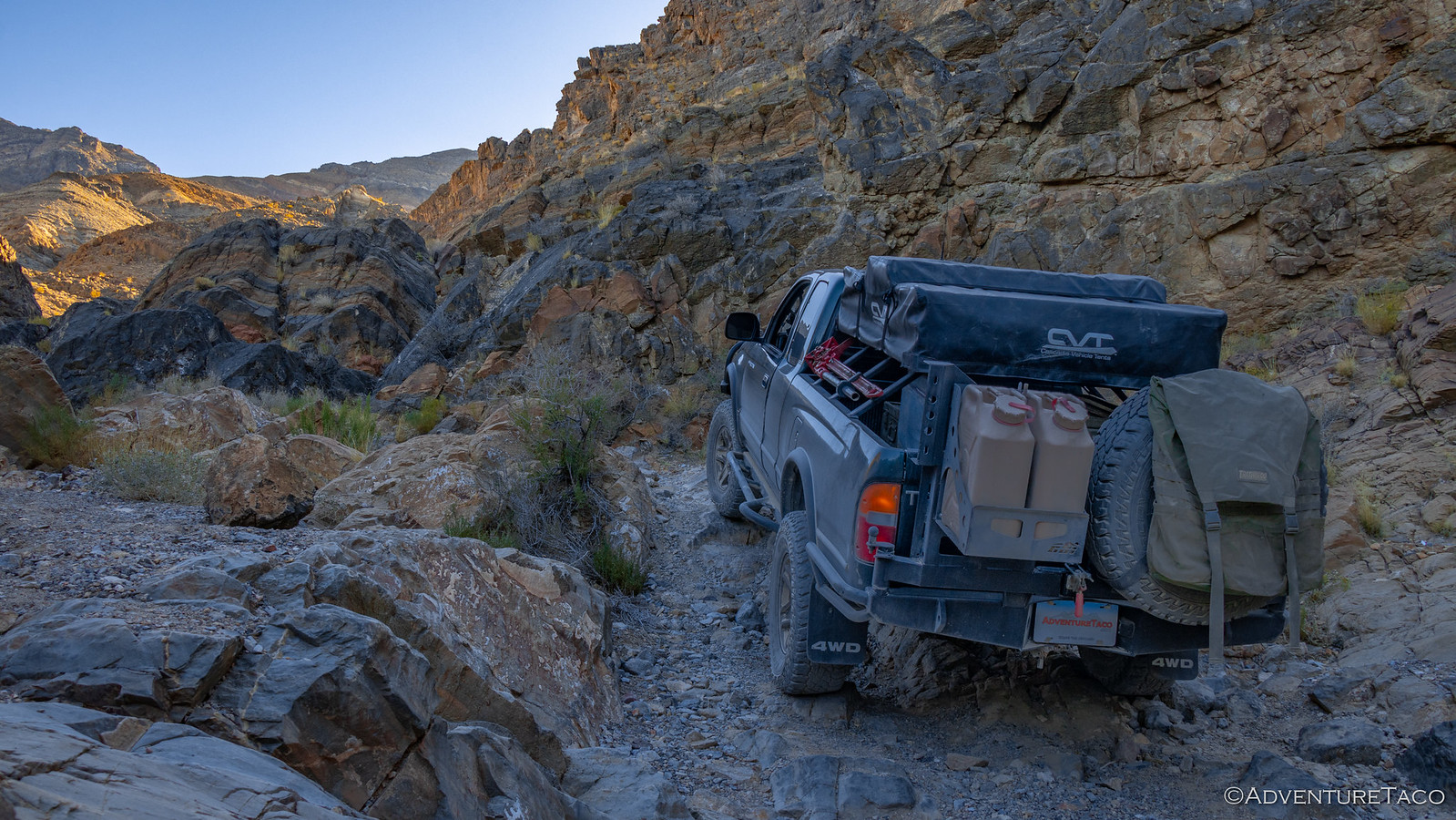
Well, I must say - while it was fun, and a little narrow... I've clearly been jaded by the last 18 months of adventures. This is - I suppose - to be expected, but at the same time I'd be lying if I didn't say I was a little bummed.
It was of course still a beautiful drive, and @mrs.turbodb - having been on fewer trips - got plenty of thrills as we squeezed through the various narrows and climbed up over the dry falls; the e-brake just strong enough to hold he truck without slipping in a couple of situations as I hopped out to snap a quick photo.




Something that was hard to capture on this trip through the canyon due to the long, early morning shadows - and that I think many people miss because they are focused on the driving - is that there are several very interesting looking side canyons branching off of the main wash. I had assumed that this might be my last trip through Dedeckera given its remoteness in relation to everything else in Death Valley National Park, but I can confidently say now that I will be back to this region - both to explore these side canyons, as well as several more places in Eureka Valley that have piqued my interest!
Today however, we passed by the side canyons and made our up and over through Steel Pass; we had places to be, and a limited number of hours to accomplish that be-ing.



As Saline Valley opened up in front of us, we both took in our first view of where we'd be spending the next couple of days. This valley and the Inyo Mountains to its west were to be our stomping grounds - our goal to uncover, and yet still keep, a few of its secrets.

...So that's where this trip report is going to get a bit weird. I'm going to do things a little out of order and with some location redaction - in hopes of keeping a few of these special places special for just a little longer. If you find them, I think it'd be swell if you'd do the same!
While it's obvious that salt plays an important role in Saline Valley's history, I think most people who've been there are mostly - or only - familiar with the Salt Tram that carried the white crystals up and over the Inyo Mountains to the west, and out to the Owens Valley.

Well, it turns out that this was the both the initial and final path for the harvested salt, but it wasn't the only successful path over which the salt was transported. For that, we need to reach a bit deeper into the history of the operation. The brain child of an attorney named White Smith, the salt tram was constructed - at great cost - between 1911 and 1913.
Unfortunately, there were flaws in the construction which limited the amount of salt it could transport and by 1920, having transported only 5,000 tons of salt, Smith's company went bankrupt, and the tram was repossessed by the builder.
Not to be dissuaded, Smith lobbied the county to build a road from the Owens Valley to Saline Valley, via San Lucas Canyon. This road too took over two years to build. When completed, trucks would carry 10-ton loads of salt along a trail famed by miners to be "so precarious, it is only navigable by those crazy enough to do it drunk."
Last driven in the 1930's, no part of this dirt road is recognizable today - with one exception. At the most dangerous point on the route - where the road navigated around the edge of a 50-foot dry fall - a narrow ledge can be seen cut into the side of the canyon wall.
And that's where we were headed. Assuming my plan worked out.
See, rather than take the normal route from the top of San Lucas Canyon to the dry fall, I'd found a faint road and a side canyon that appeared to connect back into San Lucas - saving approximately 2 miles of hiking - assuming that it was passable. And it started with driving high above Saline Valley before parking the truck in a flexy spot at the top of the side canyon. :laugh:


Don't miss the rest of the story, and all the remaining photos that don't fit here (due to max post size). Hopefully that can change in the future, but until then...
.
One benefit of going to bed at 7:30pm is that even waking up as the sun crested the Last Chance Range at 6:30am, I got a full night sleep...and then some. And that was a good thing - because even in my attempt to plan reasonable-length days before heading out on this adventure, I knew I'd failed for this day - we had a lot to do. I'll get a bit ahead of myself here, but our goal was to make it out of Eureka Valley, explore some vast swaths of Saline Valley, conquer two multi-mile hikes, and eventually backtrack quite a few miles to camp at the middle Saline Valley Warm Springs.
Yeah, I'm not sure what I was thinking. Except that at 6:30am, all I was really thinking about was how cold it was (our water had frozen overnight) and how nice the sun felt as it finally started to warm us up in camp.


We ate a quick breakfast as we got the tent put away, and it wasn't long before we here headed south - past the dunes we'd hiked the day before - and towards our exit from Eureka Valley.


That exit - as anyone familiar with the area has likely already realized - was via Dedeckera Canyon and Steel Pass. This fun little section of road would be the most technical that we'd traverse in the park on this trip, and was something I'd been looking forward to since I'd traveled it in the opposite direction a little more than 18 months earlier. At the time, I'd had less experience, and was glad to have been descending the four closely-spaced obstacles through Dedeckera rather than climbing them; gravity seemingly in my favor.
This time, I was happy to climb them - the challenge of something a little more exciting, my motivating factor. It wasn't long before we hit the first narrow, rocky section.



Well, I must say - while it was fun, and a little narrow... I've clearly been jaded by the last 18 months of adventures. This is - I suppose - to be expected, but at the same time I'd be lying if I didn't say I was a little bummed.
It was of course still a beautiful drive, and @mrs.turbodb - having been on fewer trips - got plenty of thrills as we squeezed through the various narrows and climbed up over the dry falls; the e-brake just strong enough to hold he truck without slipping in a couple of situations as I hopped out to snap a quick photo.




Something that was hard to capture on this trip through the canyon due to the long, early morning shadows - and that I think many people miss because they are focused on the driving - is that there are several very interesting looking side canyons branching off of the main wash. I had assumed that this might be my last trip through Dedeckera given its remoteness in relation to everything else in Death Valley National Park, but I can confidently say now that I will be back to this region - both to explore these side canyons, as well as several more places in Eureka Valley that have piqued my interest!
Today however, we passed by the side canyons and made our up and over through Steel Pass; we had places to be, and a limited number of hours to accomplish that be-ing.



As Saline Valley opened up in front of us, we both took in our first view of where we'd be spending the next couple of days. This valley and the Inyo Mountains to its west were to be our stomping grounds - our goal to uncover, and yet still keep, a few of its secrets.

...So that's where this trip report is going to get a bit weird. I'm going to do things a little out of order and with some location redaction - in hopes of keeping a few of these special places special for just a little longer. If you find them, I think it'd be swell if you'd do the same!
While it's obvious that salt plays an important role in Saline Valley's history, I think most people who've been there are mostly - or only - familiar with the Salt Tram that carried the white crystals up and over the Inyo Mountains to the west, and out to the Owens Valley.

Well, it turns out that this was the both the initial and final path for the harvested salt, but it wasn't the only successful path over which the salt was transported. For that, we need to reach a bit deeper into the history of the operation. The brain child of an attorney named White Smith, the salt tram was constructed - at great cost - between 1911 and 1913.
Unfortunately, there were flaws in the construction which limited the amount of salt it could transport and by 1920, having transported only 5,000 tons of salt, Smith's company went bankrupt, and the tram was repossessed by the builder.
Not to be dissuaded, Smith lobbied the county to build a road from the Owens Valley to Saline Valley, via San Lucas Canyon. This road too took over two years to build. When completed, trucks would carry 10-ton loads of salt along a trail famed by miners to be "so precarious, it is only navigable by those crazy enough to do it drunk."
Last driven in the 1930's, no part of this dirt road is recognizable today - with one exception. At the most dangerous point on the route - where the road navigated around the edge of a 50-foot dry fall - a narrow ledge can be seen cut into the side of the canyon wall.
And that's where we were headed. Assuming my plan worked out.
See, rather than take the normal route from the top of San Lucas Canyon to the dry fall, I'd found a faint road and a side canyon that appeared to connect back into San Lucas - saving approximately 2 miles of hiking - assuming that it was passable. And it started with driving high above Saline Valley before parking the truck in a flexy spot at the top of the side canyon. :laugh:


Don't miss the rest of the story, and all the remaining photos that don't fit here (due to max post size). Hopefully that can change in the future, but until then...
Keep reading the rest here
Old Roads and Star Trails - In Search of Overlooks #2
Old Roads and Star Trails - In Search of Overlooks #2
.
turbodb
Well-known member
To Thunderbirds and Beyond - In Search of Overlooks #3
The night air was warm - probably 15°F warmer than it'd been in Eureka Valley - as the stars spun in the clear sky above. It was a great night, tucked away in our quiet, secluded corner of Saline Valley.

Once again having gone to bed early, it was no trouble getting up a little before sunrise. I wasn't sure we'd really get anything with cloudless skies and our position relative to the Inyo Mountains and Panamint Ranges. And in the end, there wasn't much except a bit of color in the sky, but even that was extremely pleasant as I sat overlooking the valley in a short-sleeve shirt, reading The Athena Project on my Kindle.

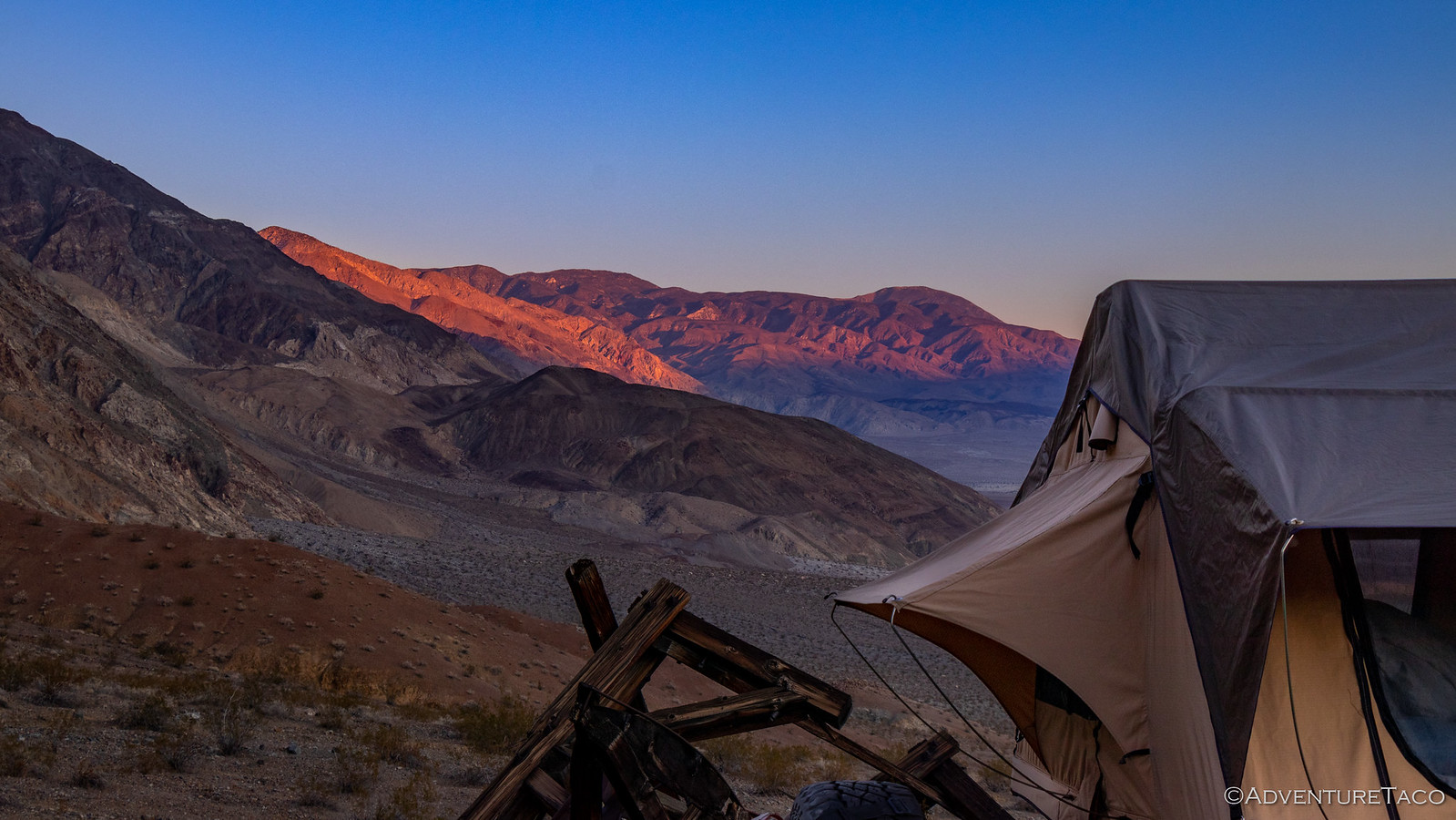
We had another full day in front of us, our slower-paced plan now a distant memory. A couple more hikes, exploration of a silver mine (that was an ad-hoc addition to the trip), and a hunt for petroglyphs hidden somewhere in Saline Valley before heading off in search of another great overlook where we could spend the night.
And here - once again - I should mention that I'll be doing this out-of-order and with a bit of obfuscation and/or redaction of certain places. If you know where they are, please do your best to keep them special as well! That means refraining from sharing specific locations, wandering off trail, and touching any rock art that you find. These places have a hard enough time surviving in a desert environment, without having to compete with the chaos that inattentive humans can bring.
With the sun streaking higher in the sky, @mrs.turbodb was soon out of the tent as well, and as got to prepping breakfast, I poked around a bit in the ruins of the dilapidated Salt Tram where we'd set up camp. There I found the usual suspects - old wood, nails, brackets, and cabling - but also a few unique items as well. The coolest - in my opinion - was some turquoise glass, which reminded me of the purple glass we'd found at the Champion Mine in Colorado.
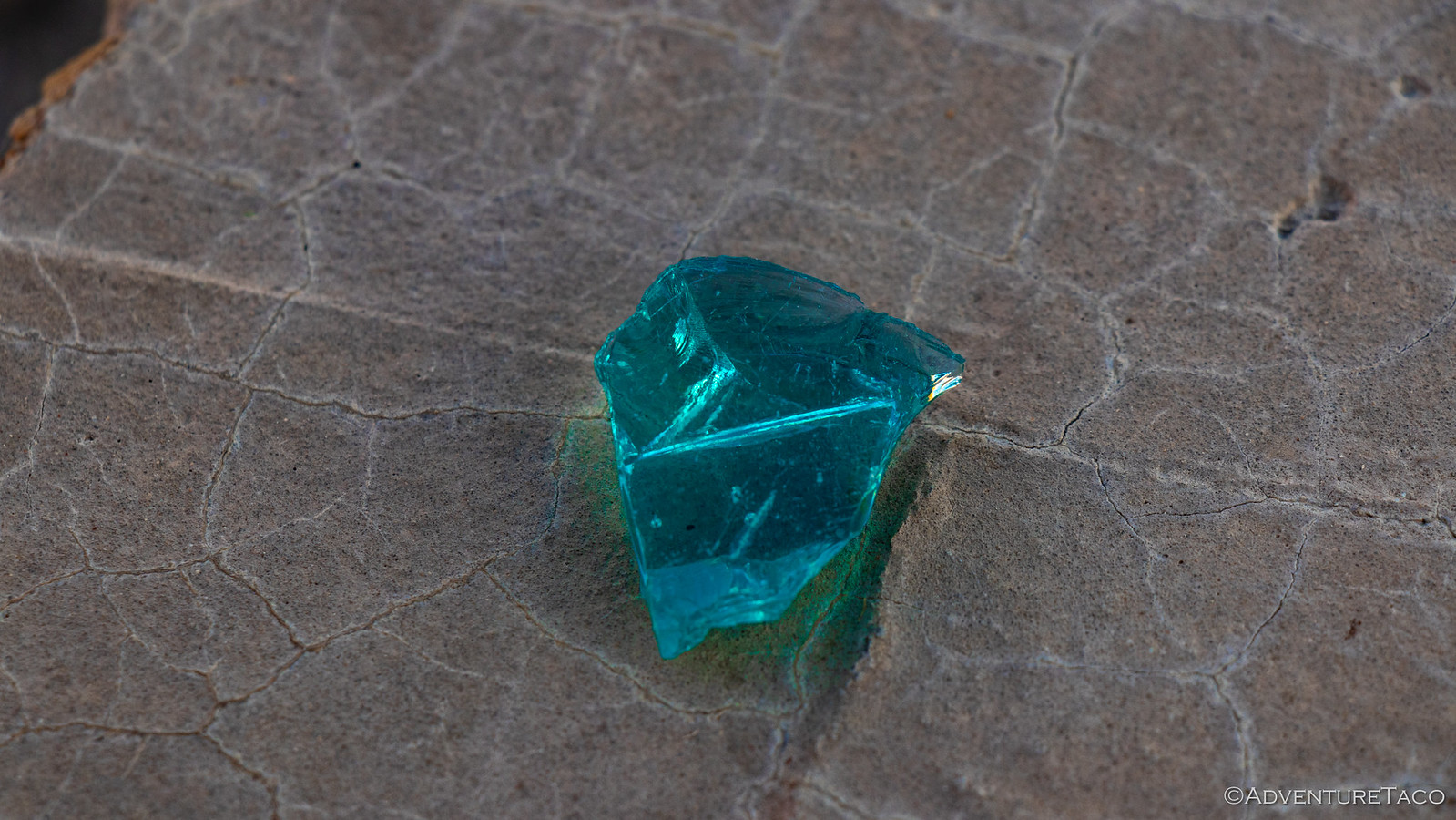
Cereal - and some of the best store-bought blueberries I've ever eaten - consumed, we packed up the kitchen and tent and got on our way, heading back down toward Saline Valley Road from our camp at the base of the Inyos.

Now, one of the treasures of Saline Valley are the *************************** petroglyphs. Located well off the beaten path, one has to find the right spot to park, and hike for a couple miles across the desert in the right direction in order to even hope to find them.
I'd discovered them - or hints about them - in several places during my research of Death Valley, and before we left on the trip, I was pretty sure I'd figured out their location. We wouldn't know for sure until we got there however, and so after making our way to a point I'd marked on the map, we parked the truck and set out on foot.


A hike like this is always a bit of a gamble - I mean, you never really know if it'll be a success or not until you're fully committed - so it's always nice to look for little things to enjoy along the way... just in case there's no pot of gold at the end. Today, the little things were easy to enjoy. Somehow - I have no idea how - I happened to look down at the ground at just the right time to see a large chip of obsidian.
I've never seen obsidian here before, but I took it as a good sign that we were headed in the right direction for Native American art, and continued on.

The flora in Saline Valley - well, all of Death Valley really - is always amazing. With a name like Death Valley - and the desert climate to go along with it - I'm always struck by the color and beauty of the plant life. Along the "trail," we found numerous cacti - the red cotton-top cactus and chollos, especially vibrant.

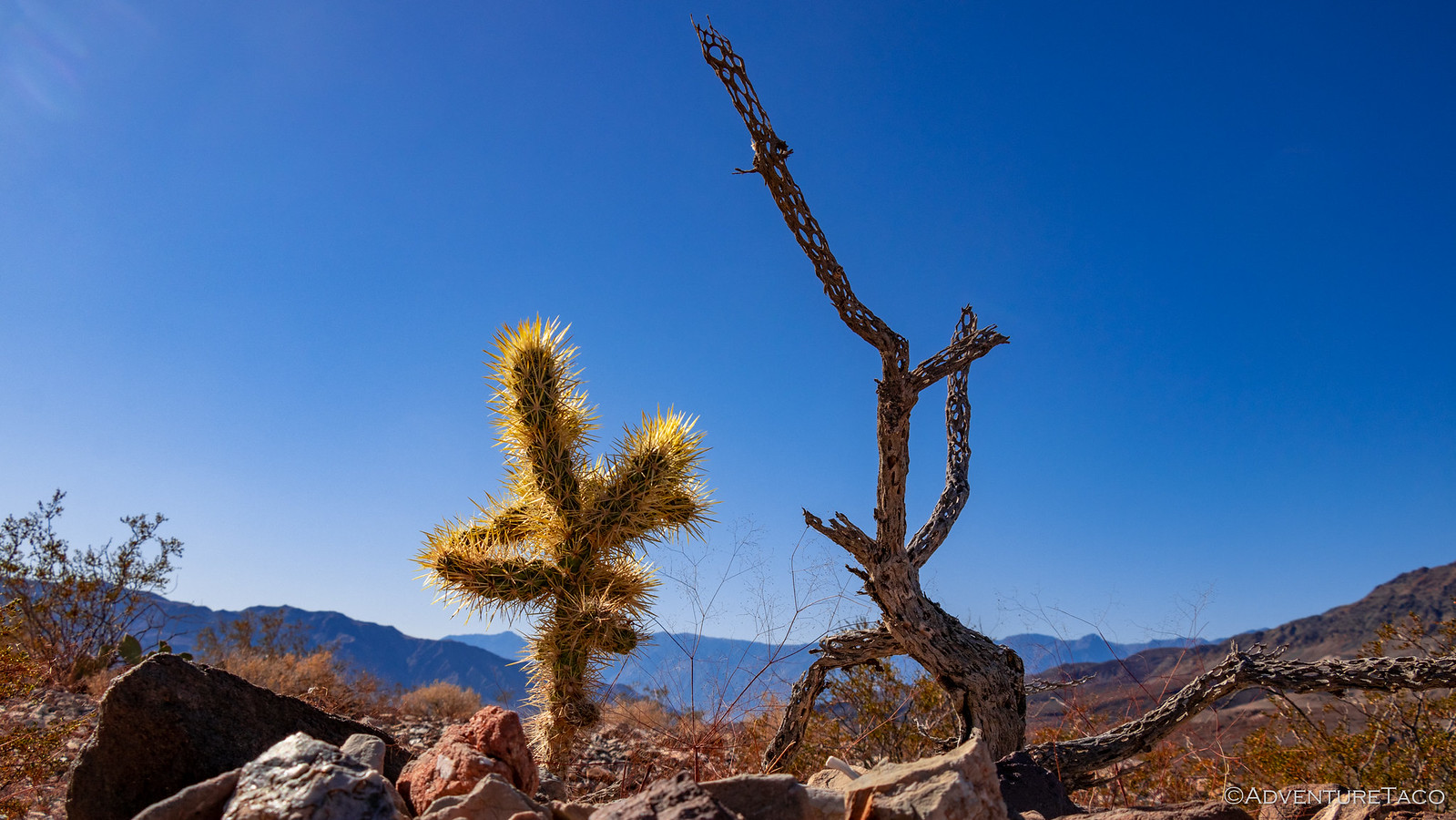
Eventually, a couple miles into our trek, we reached the edge of the valley and the mouth of the canyon that we hoped would contain our treasure. As the walls rose up around us, we pressed on.

Now was the moment of truth - sort of. A better analogy would probably be a slow motion highlight reel - or train wreck - depending on the outcome... because even if we'd found the right canyon, it was still a rather sizable place, and locating the carvings in the rock wasn't necessarily going to be an easy task.
Making our way back and forth across the wash, we inspected the walls as we headed deeper into the canyon. Eventually, we ran into the first panel, and we knew we'd found the right place!
I present to you - lady holes.

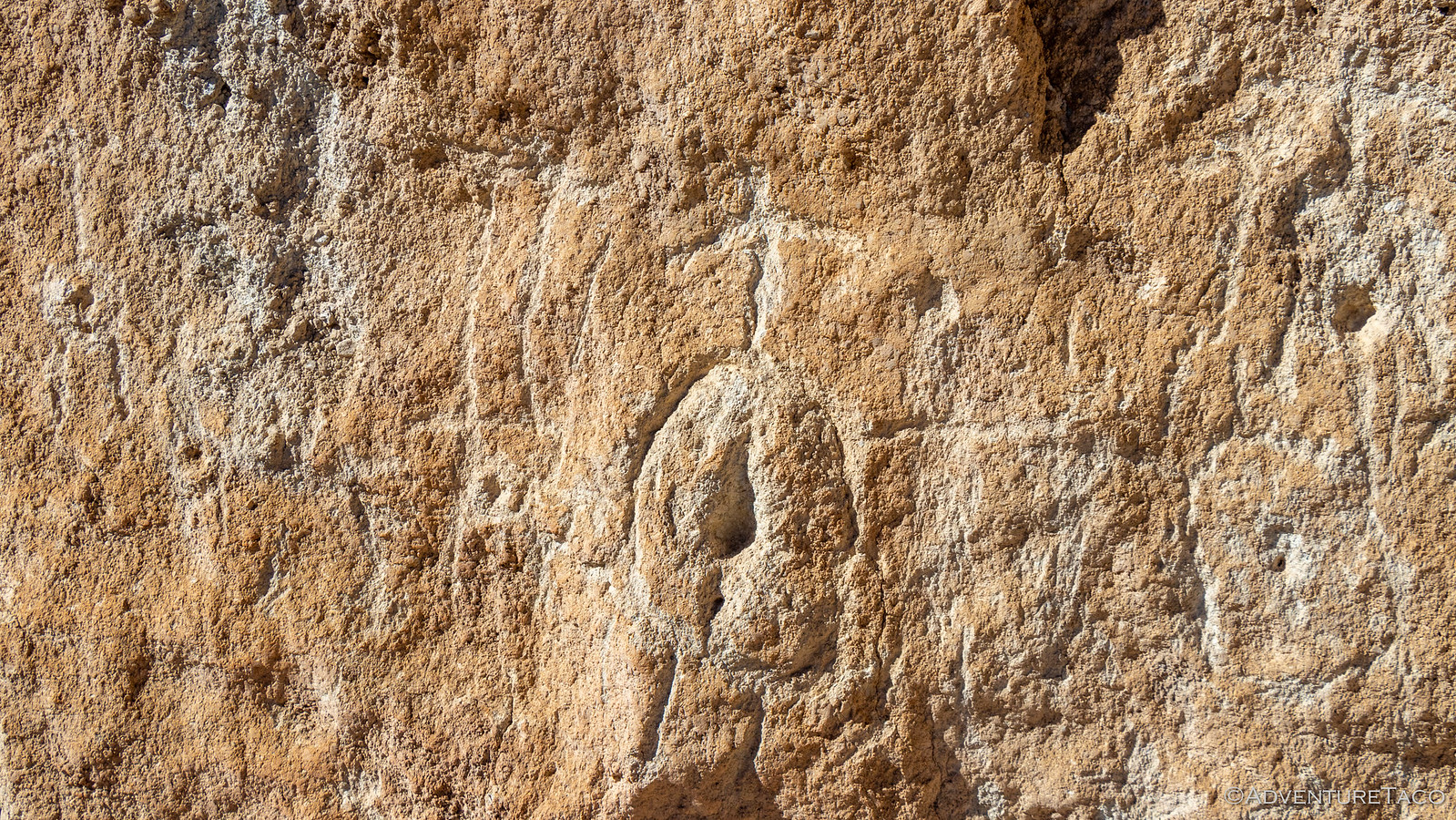
It's not known exactly what these figures represent, but it is purported that this was perhaps a fertility site, and these figures represent pregnant women - large bellies and oversize belly buttons, depicted on the rocks. Much like the yoni that we found further south near the Blue Sun Cave.
Now excited that we were in the right area, we pushed on further - our goal was to find a series of birds known as either Thunderbirds or Condors.

It wasn't long - at least relatively - before we found the next panel. This one had more variety than the first, various shapes and several different creatures depicted.



It was almost as though this second panel was a "scratch panel" of sorts - the carvings here seemingly scraped over in various places as though the artist had been practicing.

Don't miss the rest of the story, and all the remaining photos that don't fit here (due to max post size). Hopefully that can change in the future, but until then...
.
The night air was warm - probably 15°F warmer than it'd been in Eureka Valley - as the stars spun in the clear sky above. It was a great night, tucked away in our quiet, secluded corner of Saline Valley.

Once again having gone to bed early, it was no trouble getting up a little before sunrise. I wasn't sure we'd really get anything with cloudless skies and our position relative to the Inyo Mountains and Panamint Ranges. And in the end, there wasn't much except a bit of color in the sky, but even that was extremely pleasant as I sat overlooking the valley in a short-sleeve shirt, reading The Athena Project on my Kindle.


We had another full day in front of us, our slower-paced plan now a distant memory. A couple more hikes, exploration of a silver mine (that was an ad-hoc addition to the trip), and a hunt for petroglyphs hidden somewhere in Saline Valley before heading off in search of another great overlook where we could spend the night.
And here - once again - I should mention that I'll be doing this out-of-order and with a bit of obfuscation and/or redaction of certain places. If you know where they are, please do your best to keep them special as well! That means refraining from sharing specific locations, wandering off trail, and touching any rock art that you find. These places have a hard enough time surviving in a desert environment, without having to compete with the chaos that inattentive humans can bring.
With the sun streaking higher in the sky, @mrs.turbodb was soon out of the tent as well, and as got to prepping breakfast, I poked around a bit in the ruins of the dilapidated Salt Tram where we'd set up camp. There I found the usual suspects - old wood, nails, brackets, and cabling - but also a few unique items as well. The coolest - in my opinion - was some turquoise glass, which reminded me of the purple glass we'd found at the Champion Mine in Colorado.

Cereal - and some of the best store-bought blueberries I've ever eaten - consumed, we packed up the kitchen and tent and got on our way, heading back down toward Saline Valley Road from our camp at the base of the Inyos.

Now, one of the treasures of Saline Valley are the *************************** petroglyphs. Located well off the beaten path, one has to find the right spot to park, and hike for a couple miles across the desert in the right direction in order to even hope to find them.
I'd discovered them - or hints about them - in several places during my research of Death Valley, and before we left on the trip, I was pretty sure I'd figured out their location. We wouldn't know for sure until we got there however, and so after making our way to a point I'd marked on the map, we parked the truck and set out on foot.


A hike like this is always a bit of a gamble - I mean, you never really know if it'll be a success or not until you're fully committed - so it's always nice to look for little things to enjoy along the way... just in case there's no pot of gold at the end. Today, the little things were easy to enjoy. Somehow - I have no idea how - I happened to look down at the ground at just the right time to see a large chip of obsidian.
I've never seen obsidian here before, but I took it as a good sign that we were headed in the right direction for Native American art, and continued on.

The flora in Saline Valley - well, all of Death Valley really - is always amazing. With a name like Death Valley - and the desert climate to go along with it - I'm always struck by the color and beauty of the plant life. Along the "trail," we found numerous cacti - the red cotton-top cactus and chollos, especially vibrant.


Eventually, a couple miles into our trek, we reached the edge of the valley and the mouth of the canyon that we hoped would contain our treasure. As the walls rose up around us, we pressed on.

Now was the moment of truth - sort of. A better analogy would probably be a slow motion highlight reel - or train wreck - depending on the outcome... because even if we'd found the right canyon, it was still a rather sizable place, and locating the carvings in the rock wasn't necessarily going to be an easy task.
Making our way back and forth across the wash, we inspected the walls as we headed deeper into the canyon. Eventually, we ran into the first panel, and we knew we'd found the right place!
I present to you - lady holes.


It's not known exactly what these figures represent, but it is purported that this was perhaps a fertility site, and these figures represent pregnant women - large bellies and oversize belly buttons, depicted on the rocks. Much like the yoni that we found further south near the Blue Sun Cave.
Now excited that we were in the right area, we pushed on further - our goal was to find a series of birds known as either Thunderbirds or Condors.

It wasn't long - at least relatively - before we found the next panel. This one had more variety than the first, various shapes and several different creatures depicted.



It was almost as though this second panel was a "scratch panel" of sorts - the carvings here seemingly scraped over in various places as though the artist had been practicing.

Don't miss the rest of the story, and all the remaining photos that don't fit here (due to max post size). Hopefully that can change in the future, but until then...
Keep reading the rest here
To Thunderbirds and Beyond - In Search of Overlooks #3
To Thunderbirds and Beyond - In Search of Overlooks #3
.
turbodb
Well-known member
Saline Warm Springs & Cerro Gordo: Once is Enough - In Search of Overlooks #4
Unlike most nights, where the temps seem to drop to their lowest point just before sunrise, our night high in ************ the Inyo Mountains turned out to be just the opposite. At some point, I was so warm that I even removed one of the comforters in order to maintain a reasonably-cozy-and-not-all-sweaty body temp. Even @mrs.turbodb commented on it in the morning, as we enjoyed our breakfast.
That of course was after I'd gotten out of bed in order to capture what might have been an amazing sunrise. See, as we'd arrived the previous evening, one of the things we'd noticed was that there was quite a bit of high-level smoke to our west. With a westerly wind, I figured we'd either reap the benefits of that smoke - with some spectacular color - or we'd end up with nothing more than a hazy mess. If the end, I think we got a bit of both.
The light on the horizon started oranger than we'd seen previous mornings - likely because this was the first time we had enough elevation to see closer to the horizon. The bright orange lasted only minutes, the smoke becoming more hazy as the sun neared the horizon.

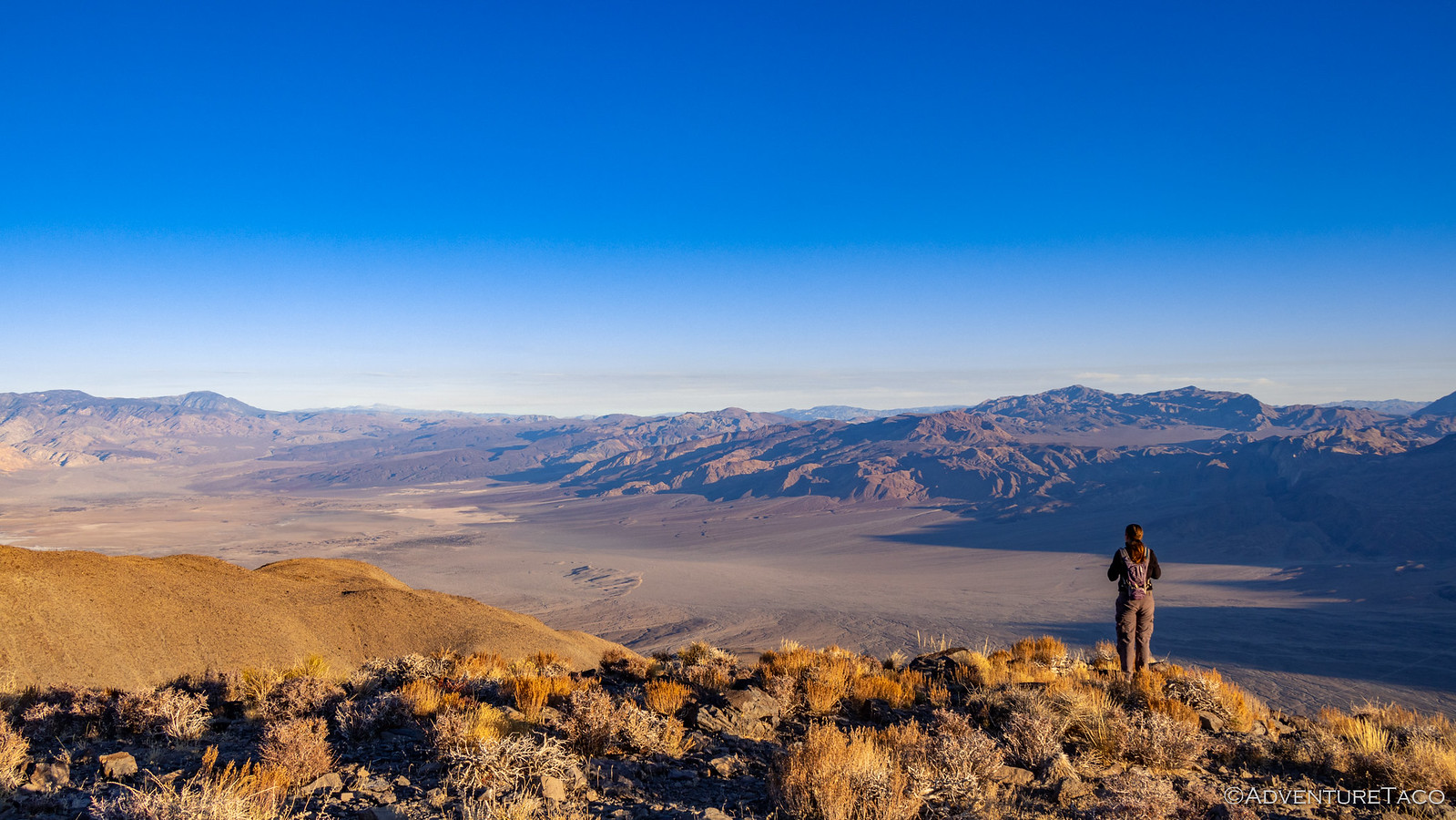
I probably scurried around camp - literally jogging from spot to spot in order to try and capture the grandeur - for a good 90 minutes before finally deciding that there was really no way I was going to be able to be in all places at once, and I'd just have to find my way back in the future so I could spend a few more days here. With @mrs.turbodb now out of bed and breakfast behind us, it was time to get on with our day. We only had about half the day to spend here in the wilderness - the other half to be spent making our way north towards home.
And here - once again - I should mention that I'll be doing this out-of-order and with a bit of obfuscation and/or redaction of certain places. If you know where they are, please do your best to keep them special as well!
Luckily for us, our first stop was reasonably nearby - the *************** Mine. This was a historic copper mine, responsible for more than two thirds of all the copper to come out of Saline Valley. Mined as an open cut, the most striking thing about this mine to me was the structure of the quartz crystals that are everywhere on the site. More than trillions of little crystals are imperceptible at first, and only on closer inspection does one notice the amazing geology.


As much as we'd have loved to stay to take in the views, we knew that there were other places to spend time before we hit the highway, and we pulled ourselves away towards our next destination. It's here that I'd be remiss however, if I failed to mention another really exciting experience that we'd had the last several days. In fact, it was one that I wasn't sure would be in the cards this time due to the unfortunate crash of a Navy F-18 at Father Crowley Point back in July. But - and I don't know if this has always been the Star Wars route, or if it's a new route for the planes - our time in Saline Valley was peppered with low-level fly-bys, several of the jets performing rolls as they passed overhead.
Could they see us - a lone vehicle with a dust trail as we drove our way around? - perhaps. But we could definitely see - and hear - them!

Surely, all of the folks at the Saline Valley Warm Springs enjoyed it as well. That place was hopping as we drove by - something that I think surprised @mrs.turbodb a little bit, given it's remoteness - and while we'd planned to stay there one night, in the end we were much happier with our private little spot by the Salt Tram - away from the chaotic parties that were surely raging below. A few minutes exploring the upper springs, and a quick stop at the bat sign, were the only time we allotted to what is - by far - the most popular place in Saline Valley.


Our next couple of mines were not quite on our way to the final destination of our trip - the mining ghost town of Cerro Gordo - but they were close enough. The ********* Mine - which worked primarily silver - and ********* Mine - which pulled garnets and several other semi-precious stones - were both located in the ************ near Lee Flat. We visited the silver mine first, working out way up to a small opening in the hillside. Don't let this opening fool you - if pressed, I'd say it was much smaller than the original opening, erosion of the surrounding area slowly working to cover this entrance. A few feet inside the mountain, both the the shaft height and width increased dramatically, large enough for several miners to work comfortably side by side.

We were in no way going inside this mine however - the loose dirt and rock, indicators to us that we'd be safer out here in the open! As it turns out, this mine was reasonably near another attraction, and there were a few other explorers already set up there when we were at the ********* Mine, so we didn't hang out here long.

Instead, we headed over to the nearby ********* garnet mine to see if we could find what we had heard was a profusion of garnet strewn about on the ground. This was especially interesting to @mrs.turbodb who'd also wanted to search for garnets on our trip to Indian Hot Springs in Idaho earlier in the year. There, we hadn't had time to do much poking around, but this time we figured it would be significantly easier, and so - why not?
Almost immediately, we discovered something else. In addition to garnets, this mine was apparently rich - at least, as far as we could tell - with turquoise. In fact, while we searched several tailings piles for garnets and never found any, there was no shortage of the bluish-green gem embedded in the surrounding rock. It quite literally, littered the ground!

Here too there were mine shafts - the largest of which seemed to be bored into reasonably solid rock. That fact, and my hope that perhaps we'd find a garnet inside, propelled not only me - but also @mrs.turbodb - forward twenty feet or so into the shaft.

...which is when we noticed this little guy on the ceiling. Now, for anyone familiar with my stories - you may recall that it was only a couple months ago that I found a bat under my mattress when I was putting away the tent one morning. The discovery was enough to send @mrs.turbodb back the way she'd come, and I spent a few minutes trying to get a photo before making my way out as well. Garnet-less! (Which was just fine - it's not like they'd be coming home with us anyway, though it would have been nice to take home a picture.)

With that, our exploration of the mine was complete - at least for this trip - and we climbed back in the truck and pointed ourselves west; our destination was Cerro Gordo. Located near the southern crest of the Inyo Mountains, this mining town founded by Mexicans in 1863 was unlike many in the Death Valley area. Where most mines were all work and no pay - disappointing generations of miners - Cerro Gordo was not only successful - it was the most successful. In fact, Hiking Western Death Valley retells a story of just how much silver was pulled out of this area:
- - -
Don't miss the rest of the story, and all the remaining photos that don't fit here (due to max post size). Hopefully that can change in the future, but until then...
.
Unlike most nights, where the temps seem to drop to their lowest point just before sunrise, our night high in ************ the Inyo Mountains turned out to be just the opposite. At some point, I was so warm that I even removed one of the comforters in order to maintain a reasonably-cozy-and-not-all-sweaty body temp. Even @mrs.turbodb commented on it in the morning, as we enjoyed our breakfast.
That of course was after I'd gotten out of bed in order to capture what might have been an amazing sunrise. See, as we'd arrived the previous evening, one of the things we'd noticed was that there was quite a bit of high-level smoke to our west. With a westerly wind, I figured we'd either reap the benefits of that smoke - with some spectacular color - or we'd end up with nothing more than a hazy mess. If the end, I think we got a bit of both.
The light on the horizon started oranger than we'd seen previous mornings - likely because this was the first time we had enough elevation to see closer to the horizon. The bright orange lasted only minutes, the smoke becoming more hazy as the sun neared the horizon.


Breakfast with a view.
I probably scurried around camp - literally jogging from spot to spot in order to try and capture the grandeur - for a good 90 minutes before finally deciding that there was really no way I was going to be able to be in all places at once, and I'd just have to find my way back in the future so I could spend a few more days here. With @mrs.turbodb now out of bed and breakfast behind us, it was time to get on with our day. We only had about half the day to spend here in the wilderness - the other half to be spent making our way north towards home.
And here - once again - I should mention that I'll be doing this out-of-order and with a bit of obfuscation and/or redaction of certain places. If you know where they are, please do your best to keep them special as well!
Luckily for us, our first stop was reasonably nearby - the *************** Mine. This was a historic copper mine, responsible for more than two thirds of all the copper to come out of Saline Valley. Mined as an open cut, the most striking thing about this mine to me was the structure of the quartz crystals that are everywhere on the site. More than trillions of little crystals are imperceptible at first, and only on closer inspection does one notice the amazing geology.


As much as we'd have loved to stay to take in the views, we knew that there were other places to spend time before we hit the highway, and we pulled ourselves away towards our next destination. It's here that I'd be remiss however, if I failed to mention another really exciting experience that we'd had the last several days. In fact, it was one that I wasn't sure would be in the cards this time due to the unfortunate crash of a Navy F-18 at Father Crowley Point back in July. But - and I don't know if this has always been the Star Wars route, or if it's a new route for the planes - our time in Saline Valley was peppered with low-level fly-bys, several of the jets performing rolls as they passed overhead.
Could they see us - a lone vehicle with a dust trail as we drove our way around? - perhaps. But we could definitely see - and hear - them!

Surely, all of the folks at the Saline Valley Warm Springs enjoyed it as well. That place was hopping as we drove by - something that I think surprised @mrs.turbodb a little bit, given it's remoteness - and while we'd planned to stay there one night, in the end we were much happier with our private little spot by the Salt Tram - away from the chaotic parties that were surely raging below. A few minutes exploring the upper springs, and a quick stop at the bat sign, were the only time we allotted to what is - by far - the most popular place in Saline Valley.


Our next couple of mines were not quite on our way to the final destination of our trip - the mining ghost town of Cerro Gordo - but they were close enough. The ********* Mine - which worked primarily silver - and ********* Mine - which pulled garnets and several other semi-precious stones - were both located in the ************ near Lee Flat. We visited the silver mine first, working out way up to a small opening in the hillside. Don't let this opening fool you - if pressed, I'd say it was much smaller than the original opening, erosion of the surrounding area slowly working to cover this entrance. A few feet inside the mountain, both the the shaft height and width increased dramatically, large enough for several miners to work comfortably side by side.

We were in no way going inside this mine however - the loose dirt and rock, indicators to us that we'd be safer out here in the open! As it turns out, this mine was reasonably near another attraction, and there were a few other explorers already set up there when we were at the ********* Mine, so we didn't hang out here long.

Instead, we headed over to the nearby ********* garnet mine to see if we could find what we had heard was a profusion of garnet strewn about on the ground. This was especially interesting to @mrs.turbodb who'd also wanted to search for garnets on our trip to Indian Hot Springs in Idaho earlier in the year. There, we hadn't had time to do much poking around, but this time we figured it would be significantly easier, and so - why not?
Almost immediately, we discovered something else. In addition to garnets, this mine was apparently rich - at least, as far as we could tell - with turquoise. In fact, while we searched several tailings piles for garnets and never found any, there was no shortage of the bluish-green gem embedded in the surrounding rock. It quite literally, littered the ground!

Here too there were mine shafts - the largest of which seemed to be bored into reasonably solid rock. That fact, and my hope that perhaps we'd find a garnet inside, propelled not only me - but also @mrs.turbodb - forward twenty feet or so into the shaft.

...which is when we noticed this little guy on the ceiling. Now, for anyone familiar with my stories - you may recall that it was only a couple months ago that I found a bat under my mattress when I was putting away the tent one morning. The discovery was enough to send @mrs.turbodb back the way she'd come, and I spent a few minutes trying to get a photo before making my way out as well. Garnet-less! (Which was just fine - it's not like they'd be coming home with us anyway, though it would have been nice to take home a picture.)

With that, our exploration of the mine was complete - at least for this trip - and we climbed back in the truck and pointed ourselves west; our destination was Cerro Gordo. Located near the southern crest of the Inyo Mountains, this mining town founded by Mexicans in 1863 was unlike many in the Death Valley area. Where most mines were all work and no pay - disappointing generations of miners - Cerro Gordo was not only successful - it was the most successful. In fact, Hiking Western Death Valley retells a story of just how much silver was pulled out of this area:
Concentration of the ore by on-site smelting was a major part of Cerro Gordo's activities. The silver-lead bullion was cast into 80- to 90-pound ingots and freighted to markets my mule teams, beginning in 1868. For three years, renowned freighter Remi Nadeau ...
- - -
Don't miss the rest of the story, and all the remaining photos that don't fit here (due to max post size). Hopefully that can change in the future, but until then...
Keep reading the rest here
Saline Warm Springs & Cerro Gordo: Once is Enough - In Search of Overlooks #4
Saline Warm Springs & Cerro Gordo: Once is Enough - In Search of Overlooks #4
.
turbodb
Well-known member
Clean Energy for My Tacoma - Time for a Fuel Filter
Well, the Tacoma got a new fuel filter today. It's a part I've had sitting around for maybe 18 months now or so, just taking up room in the garage. Because, who needs to install a new filter when the one that's on there seems to be working just fine.
Right?
Well, it finally dawned on me why they call it preventative maintenance, and I figured I might as well get it done.
Interested in doing this yourself? Here is a handy little how-to that lists the tools and parts you'll need:
First thing I did was to set myself at ease that I wasn't going to have a ¾ tank full of gas all over the floor by doing a little internet surfing to determine that - while a bit of gas would leak out of the lines - without the fuel pump going, it wasn't going to be all that much.
Then, I grabbed a few tools and the new filter and got to work - mentioning to @mrs.turbodb that this would either be a 30 minute project or the truck would be undriveable!



32 minutes later, the old filter had been exchanged for a new one, and the truck fired right up. With no leaks, it was time to cut open the old filter to see if preventative maintenance was overrated.


Well, the Tacoma got a new fuel filter today. It's a part I've had sitting around for maybe 18 months now or so, just taking up room in the garage. Because, who needs to install a new filter when the one that's on there seems to be working just fine.
Right?
Well, it finally dawned on me why they call it preventative maintenance, and I figured I might as well get it done.
Interested in doing this yourself? Here is a handy little how-to that lists the tools and parts you'll need:
First thing I did was to set myself at ease that I wasn't going to have a ¾ tank full of gas all over the floor by doing a little internet surfing to determine that - while a bit of gas would leak out of the lines - without the fuel pump going, it wasn't going to be all that much.
Then, I grabbed a few tools and the new filter and got to work - mentioning to @mrs.turbodb that this would either be a 30 minute project or the truck would be undriveable!



32 minutes later, the old filter had been exchanged for a new one, and the truck fired right up. With no leaks, it was time to cut open the old filter to see if preventative maintenance was overrated.

turbodb
Well-known member
Winter Weight Loss for the Tacoma
It's not natural. It's uncomfortable. It's hard. And, I know it's the right thing to do - I want to find a way to cut some weight off of the Tacoma.
When I purchased the truck, Toyota listed the curb weight of a 4WD SR5 V6 Xtracab at something right around 3,500 lbs, and the gross weight (GVWR) at something near 5100 lbs. Or at least, that's what I can find on the internet in 2019, since I wasn't at all interested or concerned with those numbers at the time. Unfortunately for me - and the truck - when I roll it onto a scale on the side of the highway, the numbers I see today are a little different. Fully loaded, it weighs in right around 5800 lbs, or 700lbs over Toyota's max GVWR!

Of course, I've done various things to try and account for the additional weight, like upgraded ADS suspension, reinforcing of the rear frame, etc. but still - if at all possible, I'd like to get the truck a little lighter. My goal is to drop 500 lbs.
Yeah, probably. Let's get started.
Trimming the Butt End
My first order of business was doing some work on the rear bumper. Ever since I installed the CBI Outback 1.0 bumper, I've wanted to get rid of the Hi-Lift mount on the driver side swing-out. I've got my Hi-Lift mounted to the bed rack, and the tall triangular shape of the swing-out crowds my side mirror.

I've never really summoned up the courage to cut into the powder coat on the bumper, but figured that this was as good a reason as any. So, :sawzall:!

A bit of welding and painting to finish off the new top edge and I was done. And look, progress! 7.25 lbs down, 492.75 lbs to go!

Flush with success, I decided I'd make one more modification to the bumper. See, CBI makes some parts of their bumpers adjustable - this is understandable, since they sell to thousands of people. The spare tire carrier is one such piece, where two pieces of 3/16" steel overlap for about 3", allowing the mount to adjust for tires with varying amounts of backspace.
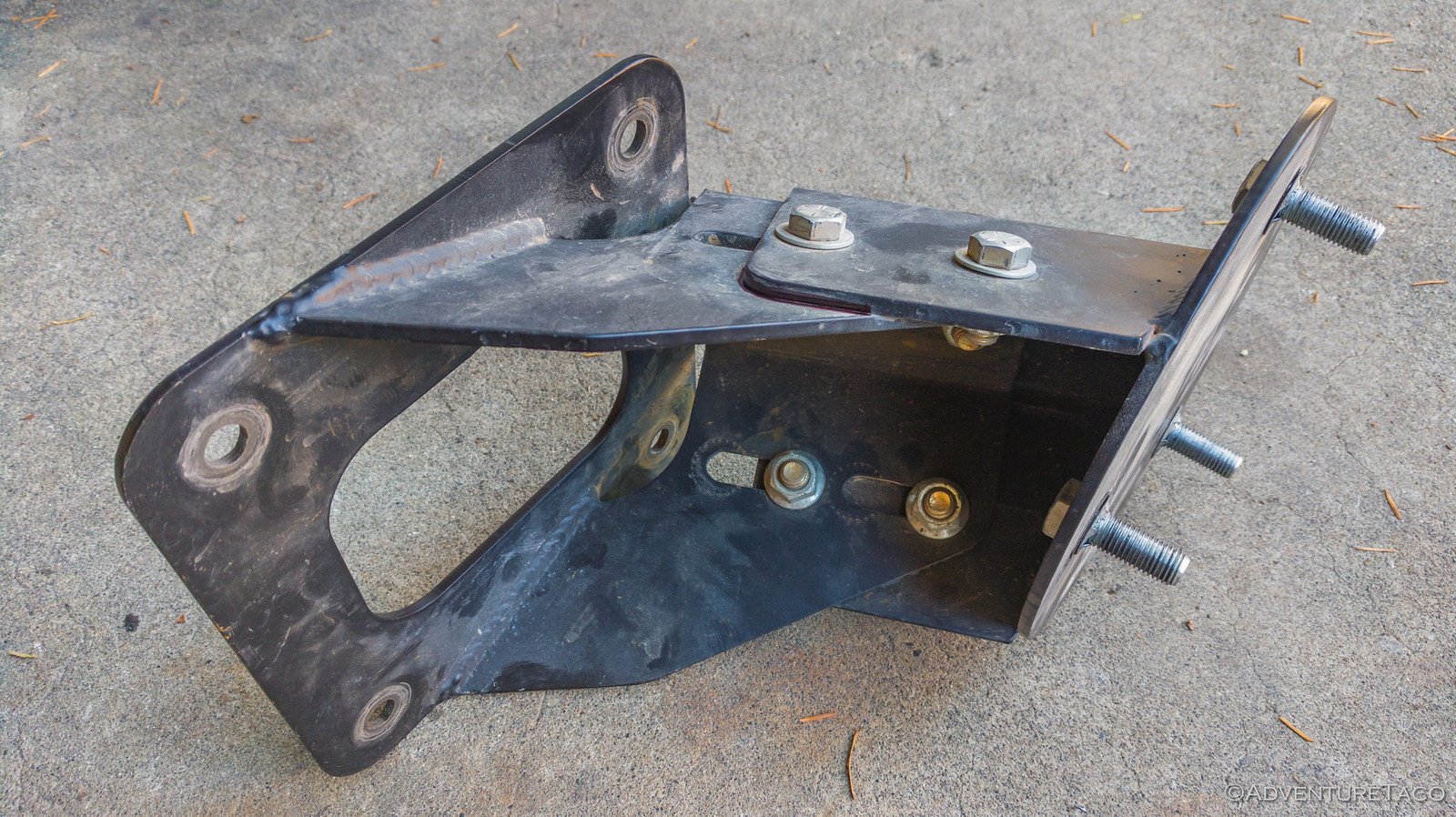
Well, I'm not planning to change my wheel or tire size any time soon (despite the prodding I get from my buddies who want me to go back to SCS wheels, and of course install 35" tires ?), so I figured I could cut out the overlap and just weld up the spare tire mount. Worked just fine, and saved me another cool 2 lbs.

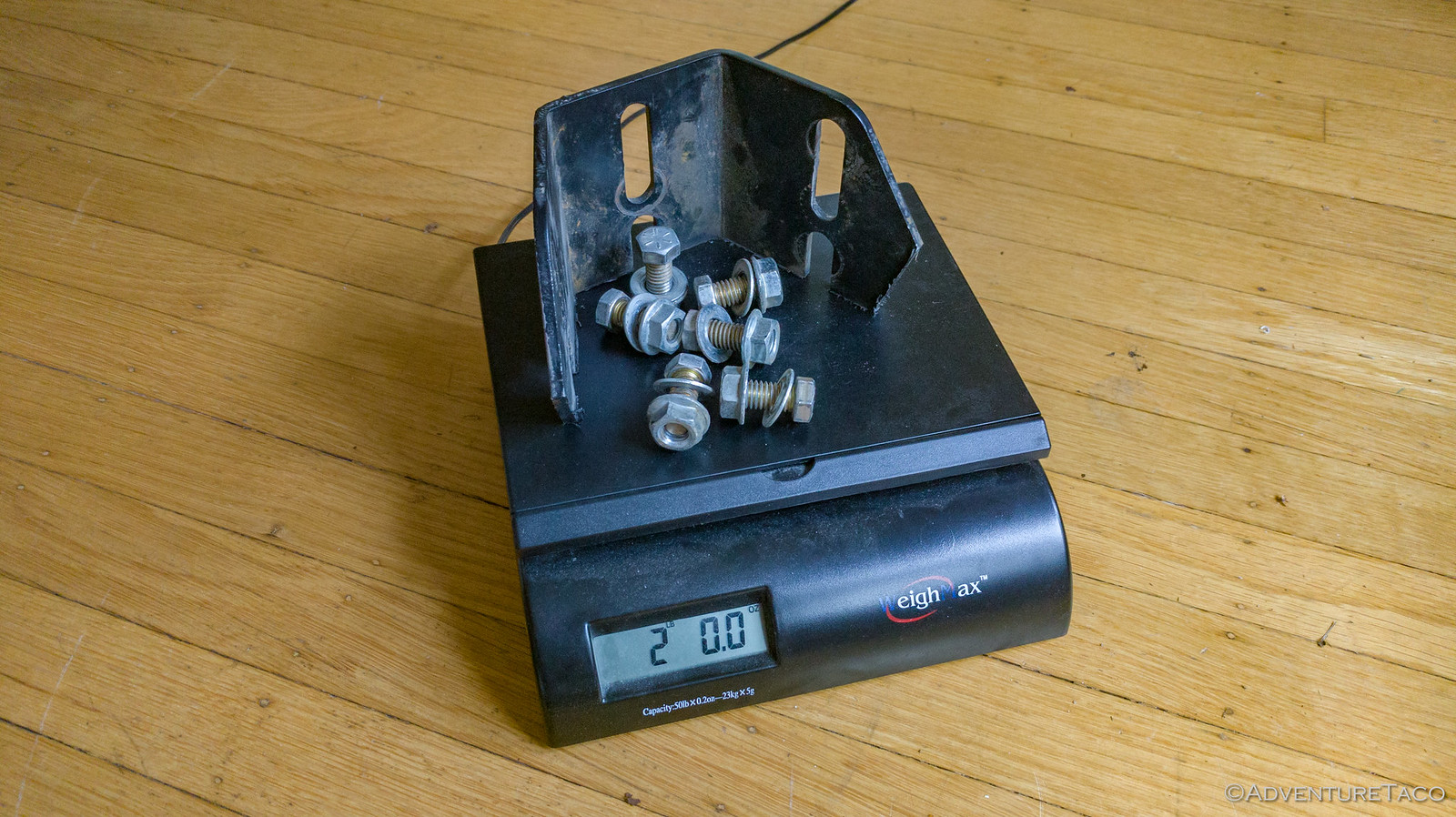
Fabbing a New Top Plate for the Jerry Cans
Long time readers may recall that I lost the top plate that secured the Jerry Can's way back at the beginning of The Re-Tour. Luckily, Dan @drr happened to see it fly off on the highway, and picked it up for me, though a little worse for wear.

Well, I lost it a second time on our most recent trip to Death Valley, and this time Dan wasn't there to pick up after me. So, I needed something that would keep the Jerry Cans from bouncing out of the rack, and figured it was a good time to make it a little lighter as well. Unlike the original plate, I decided that I'd allow myself the convenience of filling (and siphoning out of) the cans without removing the plate. This does mean that someone else could do it if I were away from the truck, but with how tight the lids get, I'm not all that worried. Weight savings was a whopping 2.1 - .44 lbs, for a total of 1.66 lbs! ?

Modifying the Battery Box
OK, so Monte @Blackdawg was sure that this thing was going to fall apart on the trail when I initially built it. Of course, it hasn't, and it's a prime candidate for a little trimming. Made of ¾" plywood, it's heavy - and plywood is so structural that I can turn a lot of it into webbing and still have the cabinet be more than strong enough.

After taking it all apart and cutting out numerous windows, I put everything back together and I'm sure the truck will now be light enough to just float away. Or not. But hey, every 5.4 lbs count!

Who Needs and OSK When You Can Have a No-SK?
I'll be the first to say - I'm not sure this is the smartest move, but my hope is that history is a good indicator of the future, and that if anything does go wrong, I'll be able to limp to wherever I can get a tow and then use my wallet to replace whatever I'm no longer carrying. Additionally, I want to work with my adventuring pals to figure out how we can each bring some things instead of each bringing every thing. Because really, we don't need 3 axles, and we're unlikely to need 6 LBJs on a trip.
Currently, I carry a whole lot of tools and parts, spread out across different areas in the truck. Let's take stock of what I've been carrying:

So now for the OSK. There are two components to the kit that I need to consider - first, the contents. It contains a myriad of things that I have used on trips (either for myself or others), so it's not as easy as just dumping the whole thing. The second component of the kit is the military medical case (ebay) itself. It's big, and while it fits the current contents well, I could save some weight by downsizing.

After giving it a bunch of thought, here's how I've decided to downsize the OSK. My thinking is that I'll keep the recovery gear and most of the tools to work on the vehicle, but that I won't keep things that I could limp to town without. That means I might not be able to perform an on-trail fix that will keep me going on the trip, but the reality is that I was covering so few of those cases anyway that it probably wasn't worthwhile.
The theme here is that these are nice to have, but not necessary on the trail. I can wait until I'm in town (or home) to buy/use them.
Tools
Don't miss the rest of the story, and all the remaining photos that don't fit here (due to max post size). Hopefully that can change in the future, but until then...
.
It's not natural. It's uncomfortable. It's hard. And, I know it's the right thing to do - I want to find a way to cut some weight off of the Tacoma.
When I purchased the truck, Toyota listed the curb weight of a 4WD SR5 V6 Xtracab at something right around 3,500 lbs, and the gross weight (GVWR) at something near 5100 lbs. Or at least, that's what I can find on the internet in 2019, since I wasn't at all interested or concerned with those numbers at the time. Unfortunately for me - and the truck - when I roll it onto a scale on the side of the highway, the numbers I see today are a little different. Fully loaded, it weighs in right around 5800 lbs, or 700lbs over Toyota's max GVWR!

Of course, I've done various things to try and account for the additional weight, like upgraded ADS suspension, reinforcing of the rear frame, etc. but still - if at all possible, I'd like to get the truck a little lighter. My goal is to drop 500 lbs.
Impossible you say?
Yeah, probably. Let's get started.
Trimming the Butt End
My first order of business was doing some work on the rear bumper. Ever since I installed the CBI Outback 1.0 bumper, I've wanted to get rid of the Hi-Lift mount on the driver side swing-out. I've got my Hi-Lift mounted to the bed rack, and the tall triangular shape of the swing-out crowds my side mirror.

I've never really summoned up the courage to cut into the powder coat on the bumper, but figured that this was as good a reason as any. So, :sawzall:!

A bit of welding and painting to finish off the new top edge and I was done. And look, progress! 7.25 lbs down, 492.75 lbs to go!

Flush with success, I decided I'd make one more modification to the bumper. See, CBI makes some parts of their bumpers adjustable - this is understandable, since they sell to thousands of people. The spare tire carrier is one such piece, where two pieces of 3/16" steel overlap for about 3", allowing the mount to adjust for tires with varying amounts of backspace.

Well, I'm not planning to change my wheel or tire size any time soon (despite the prodding I get from my buddies who want me to go back to SCS wheels, and of course install 35" tires ?), so I figured I could cut out the overlap and just weld up the spare tire mount. Worked just fine, and saved me another cool 2 lbs.


Fabbing a New Top Plate for the Jerry Cans
Long time readers may recall that I lost the top plate that secured the Jerry Can's way back at the beginning of The Re-Tour. Luckily, Dan @drr happened to see it fly off on the highway, and picked it up for me, though a little worse for wear.

Well, I lost it a second time on our most recent trip to Death Valley, and this time Dan wasn't there to pick up after me. So, I needed something that would keep the Jerry Cans from bouncing out of the rack, and figured it was a good time to make it a little lighter as well. Unlike the original plate, I decided that I'd allow myself the convenience of filling (and siphoning out of) the cans without removing the plate. This does mean that someone else could do it if I were away from the truck, but with how tight the lids get, I'm not all that worried. Weight savings was a whopping 2.1 - .44 lbs, for a total of 1.66 lbs! ?

Modifying the Battery Box
OK, so Monte @Blackdawg was sure that this thing was going to fall apart on the trail when I initially built it. Of course, it hasn't, and it's a prime candidate for a little trimming. Made of ¾" plywood, it's heavy - and plywood is so structural that I can turn a lot of it into webbing and still have the cabinet be more than strong enough.

After taking it all apart and cutting out numerous windows, I put everything back together and I'm sure the truck will now be light enough to just float away. Or not. But hey, every 5.4 lbs count!

Who Needs and OSK When You Can Have a No-SK?
I'll be the first to say - I'm not sure this is the smartest move, but my hope is that history is a good indicator of the future, and that if anything does go wrong, I'll be able to limp to wherever I can get a tow and then use my wallet to replace whatever I'm no longer carrying. Additionally, I want to work with my adventuring pals to figure out how we can each bring some things instead of each bringing every thing. Because really, we don't need 3 axles, and we're unlikely to need 6 LBJs on a trip.
Currently, I carry a whole lot of tools and parts, spread out across different areas in the truck. Let's take stock of what I've been carrying:
- The OEM screw jack and associated spare tire changing tools, in the Xtracab cubbies.
- My tool roll - which contains all the tools I use on a regular basis for truck maintenance. Details of the roll covered in Gear Roundup - What I Take With Me On Trips (2018 edition).
- The actual OSK. This is generally what I consider to be "backup" stuff that hopefully never gets used on a trip. Again, contents in last year's Gear Roundup; I haven't made any significant changes.

So now for the OSK. There are two components to the kit that I need to consider - first, the contents. It contains a myriad of things that I have used on trips (either for myself or others), so it's not as easy as just dumping the whole thing. The second component of the kit is the military medical case (ebay) itself. It's big, and while it fits the current contents well, I could save some weight by downsizing.

After giving it a bunch of thought, here's how I've decided to downsize the OSK. My thinking is that I'll keep the recovery gear and most of the tools to work on the vehicle, but that I won't keep things that I could limp to town without. That means I might not be able to perform an on-trail fix that will keep me going on the trip, but the reality is that I was covering so few of those cases anyway that it probably wasn't worthwhile.
The theme here is that these are nice to have, but not necessary on the trail. I can wait until I'm in town (or home) to buy/use them.
Tools
- ½" drive, 10-150 ft-lb torque wrench
- Two pry bars<span style="font-family: inherit; font-size: inherit;"> </span>(of the set of four)
- Socket adapter and reducer set
- spare fuses
- 5 qt engine oil
- 1 qt Lucas 80W-90 gear oil
- MAF cleaner
- Throttle Body cleaner
- Brake fluid
Don't miss the rest of the story, and all the remaining photos that don't fit here (due to max post size). Hopefully that can change in the future, but until then...
.
turbodb
Well-known member
Mojave Redemption #1 - Off to an Ominous Start
Part of the Mojave Redemption (Dec 2019) trip.
Spoiler: I need to go back.

Just look at all the cool places we'll go (in blue).
The First Day (Christmas)
It was Christmas day, and for us, that meant we were kicking off our next adventure by starting the two-day trek from the Seattle area to southern California - via Oregon, Idaho, and Nevada. We'd originally planned to make the 20+ hour drive in a single day, but I'd heard that it was supposed to rain the day after Christmas, so we decided that a two-day journey would allow us to relax a bit, and avoid the weather when we were in the preserve.
Even so, with two 10-hour days of driving in front of us, we didn't stop to smell the roses. We did find a closed truck scale however, and eager to see what the truck weighed after its winter weight loss program, I pulled in. At 5350 lbs, it's definitely a lot lower than the 5800 I'd run into previously. Of course, I wasn't in the truck for this photo, so... ?

From there, our next stop was in Boise for fuel. Still a couple hours until dinner, it was already dark and the snow was starting to fall. It was a white Christmas - and it was cold!

Eventually, we reached Twin Falls. We'd been racing to get there for the sole purpose of eating dinner. See, with it being Christmas, @mrs.turbodb had smartly called around to find a place that was open - as it turned out, there weren't many (including Chinese that were closed) and those that were, planned to close early.
We missed dinner by 15 minutes! But, that was OK - having sat in the truck all day, neither of us was all that hungry. And, more worrying than the dinner situation was camp. I'd found a place - at Grey's Landing, near the Idaho-Nevada border - that I thought would be just perfect. It was away from the highway, and reasonably private. Of course, I forgot to check the elevation, and as we arrived, I knew I'd made a mistake. Not only was it cold, but there were six inches of snow on the ground and the lake itself was completely frozen over!
There wasn't much we could do - we'd be in the high desert for much of the rest of the trip - so we found what we thought would be a nice overlook in the morning, set up the tent, and climbed up to snuggle under the covers.
The Next Day (Thursday, the Day After Christmas)
It was 23°F when we woke up at 6:00am the next morning - to the soft tapping of snow drifting down onto the tent. We huddled in bed and evaluated the situation. We were definitely winning - let's list the ways.
We did the only thing we could - put on every article of clothing we'd brought with us into the tent, and headed out to get ready to go. Without breakfast - there was no way we were going to stand around for any longer than we needed to.
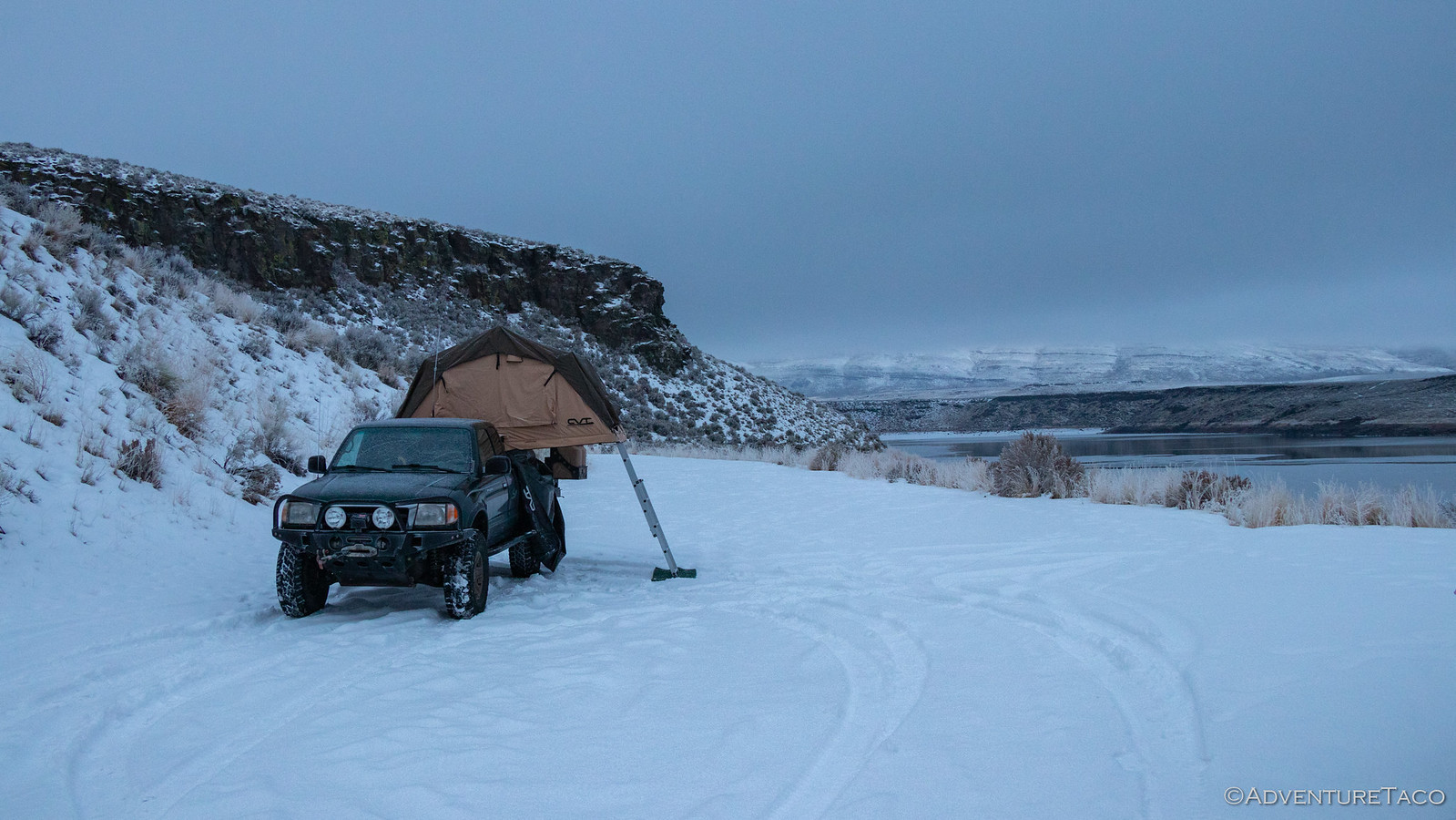
I got as much snow and ice off the tent as possible, and folded it up just as the light snow stopped. Of course! With the engine running and @mrs.turbodb warming up inside, I took a few more quick photos of our camp - it was actually quite pretty, and likely crowded in more temperate months.
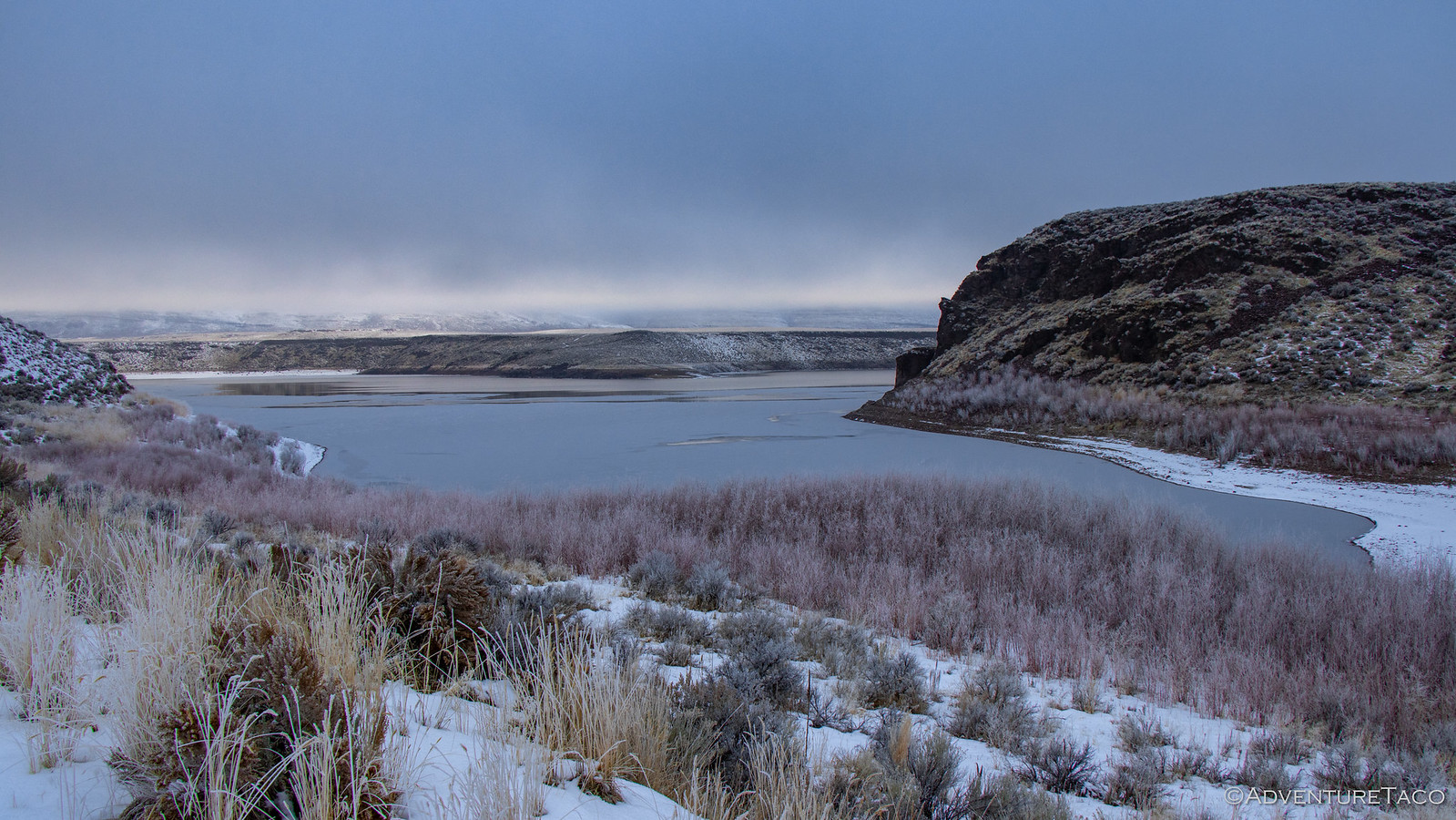
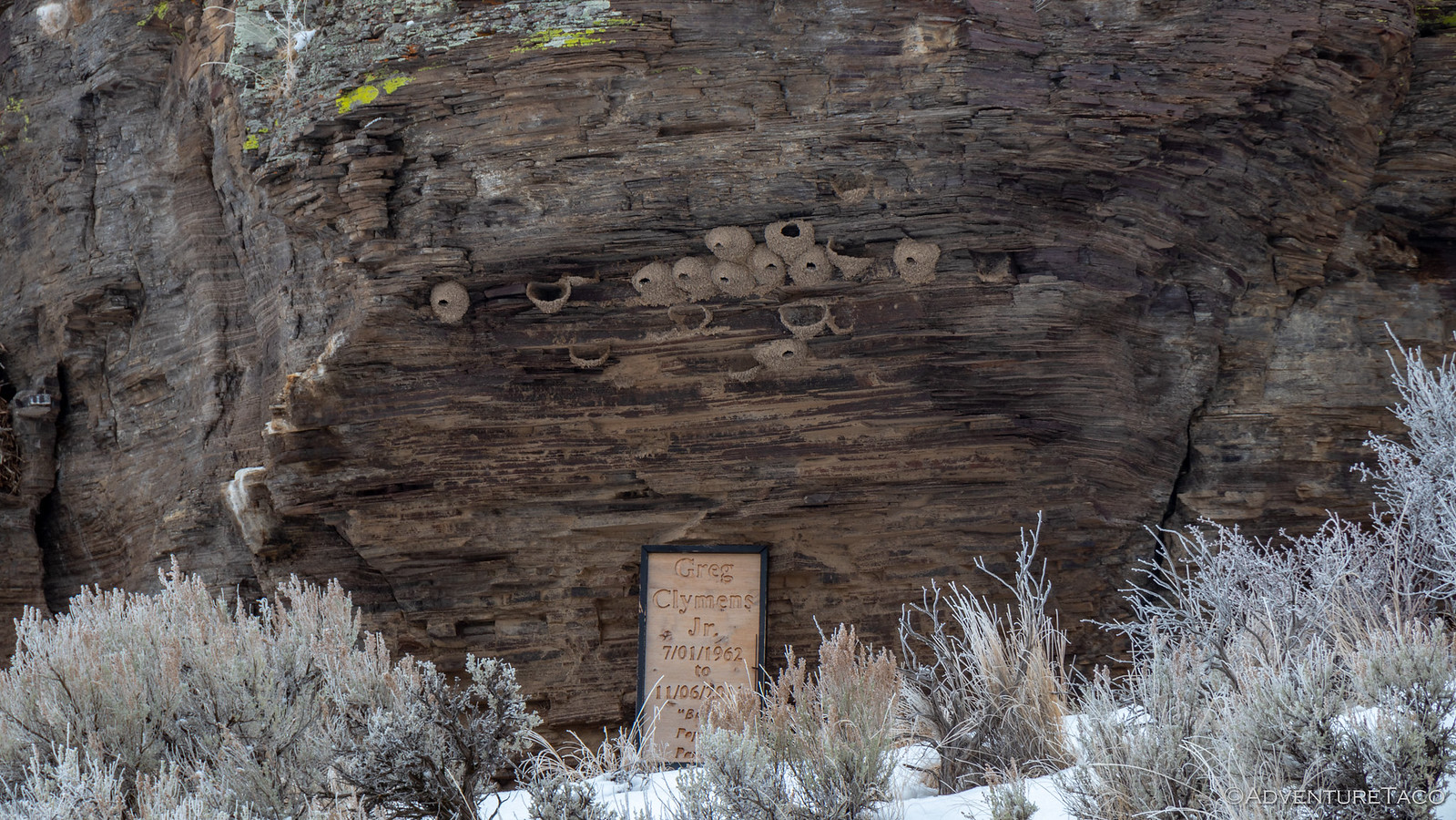
You can always tell the pretty spots by the number of people buried there!
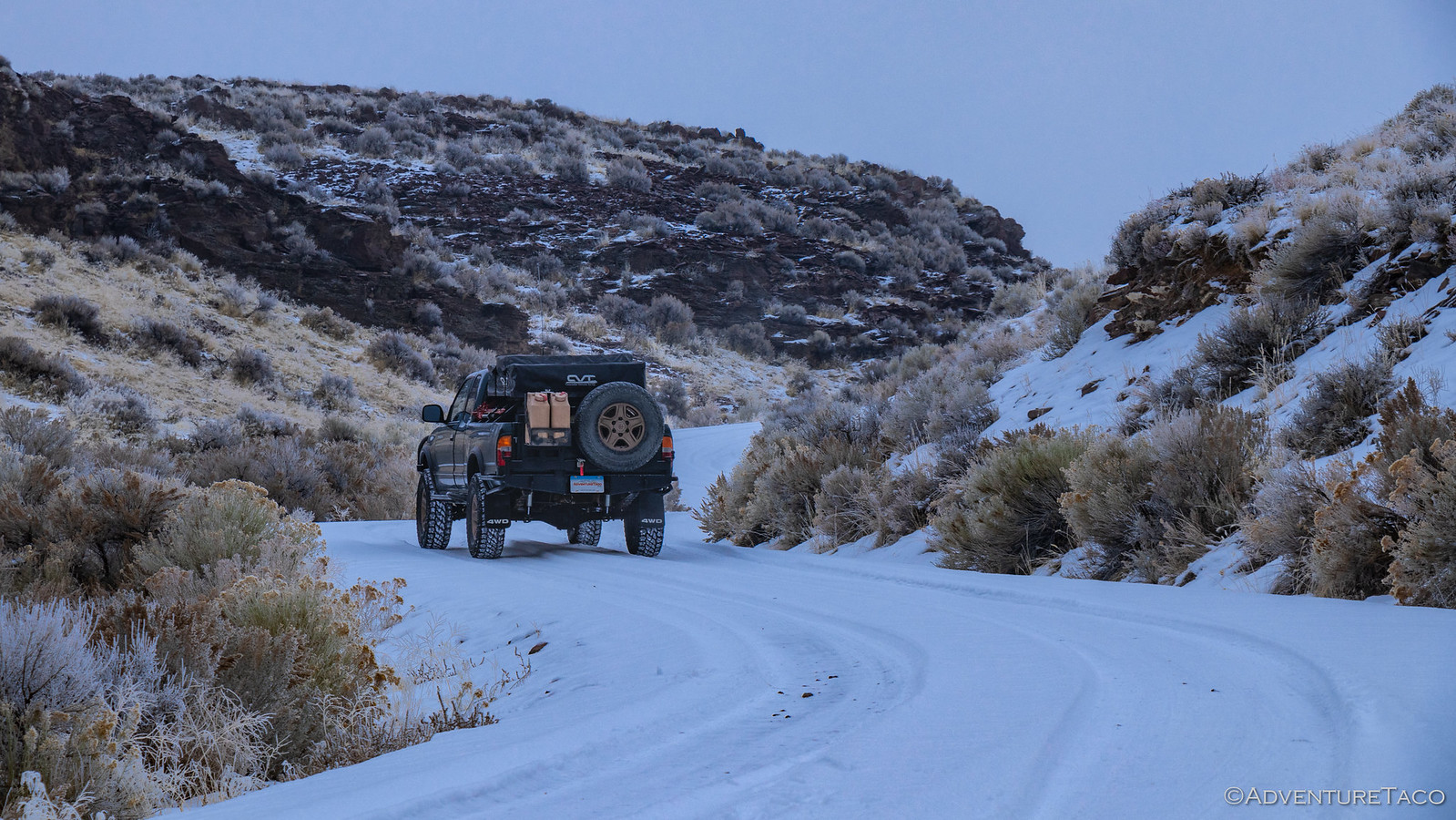
Before long we were making our way back out to US-93, the clouds starting to part and blue sky poking through. It looked to be the start of a beautiful day!

The plan for the rest of the day was simple actually - drive south on US-93 to Las Vegas (or, actually, Primm), Nevada. Along the way, we passed by the camp site Mike @Digiratus and I had used on our first night of the F.U. Rain trip, and like everything else, it was covered in snow.
The snow slowly abated - and turned to rain - as we came down out of the high desert into Las Vegas. It was early evening, and as we looked for somewhere to stop for dinner, we were greeted with an unwelcome notice.

Our bellies full, we promptly ignored all of the Nevada DOT signs and set out on I-15 for Primm. Our hope, of course, was that by the time we got there - maybe 6:00pm or so - that the freeway would be open again.
It was not. In fact, the last 5 miles to Primm were a parking lot on I-15 and we found ourselves reading our Kindles and napping in our lane of traffic for a few hours, until we finally made it to the Primm exit. Everyone else was just turning around and heading back to Las Vegas, but we had nowhere to go so we found ourselves a nice truck parking lot in the back of a local casino, and opened the tent in the rain. Fun times!
We read a bit more, and eventually dozed off to sleep - our hope that the sunny weather forecasted for the next day would materialize, and we'd be able to get on our way.
Though, in the back of our minds was the nagging question - if there'd been enough snow to close the highway, were we going to be totally screwed when we tried to venture off into the wilderness?!
Part of the Mojave Redemption (Dec 2019) trip.
Famous last words! :rofl: said:This trip is going to be EPIC. In fact, once we complete our 8 days in the Mojave National Preserve, we'll probably be done exploring the area - we'll hit all the important bits, and will have no reason to go back - except to show of the coolest areas to our friends.
Spoiler: I need to go back.

Just look at all the cool places we'll go (in blue).
The First Day (Christmas)
It was Christmas day, and for us, that meant we were kicking off our next adventure by starting the two-day trek from the Seattle area to southern California - via Oregon, Idaho, and Nevada. We'd originally planned to make the 20+ hour drive in a single day, but I'd heard that it was supposed to rain the day after Christmas, so we decided that a two-day journey would allow us to relax a bit, and avoid the weather when we were in the preserve.
Even so, with two 10-hour days of driving in front of us, we didn't stop to smell the roses. We did find a closed truck scale however, and eager to see what the truck weighed after its winter weight loss program, I pulled in. At 5350 lbs, it's definitely a lot lower than the 5800 I'd run into previously. Of course, I wasn't in the truck for this photo, so... ?

From there, our next stop was in Boise for fuel. Still a couple hours until dinner, it was already dark and the snow was starting to fall. It was a white Christmas - and it was cold!

Eventually, we reached Twin Falls. We'd been racing to get there for the sole purpose of eating dinner. See, with it being Christmas, @mrs.turbodb had smartly called around to find a place that was open - as it turned out, there weren't many (including Chinese that were closed) and those that were, planned to close early.
We missed dinner by 15 minutes! But, that was OK - having sat in the truck all day, neither of us was all that hungry. And, more worrying than the dinner situation was camp. I'd found a place - at Grey's Landing, near the Idaho-Nevada border - that I thought would be just perfect. It was away from the highway, and reasonably private. Of course, I forgot to check the elevation, and as we arrived, I knew I'd made a mistake. Not only was it cold, but there were six inches of snow on the ground and the lake itself was completely frozen over!
There wasn't much we could do - we'd be in the high desert for much of the rest of the trip - so we found what we thought would be a nice overlook in the morning, set up the tent, and climbed up to snuggle under the covers.
The Next Day (Thursday, the Day After Christmas)
It was 23°F when we woke up at 6:00am the next morning - to the soft tapping of snow drifting down onto the tent. We huddled in bed and evaluated the situation. We were definitely winning - let's list the ways.
- Our breath had condensed onto the metal poles inside the tent.
- Along the underside of the rain fly, there was ice - not just above the doors, but on the entire underside of the fly.
- It was snowing (albeit very lightly, so this isn't actually so bad).
- Did I mention it was 23°F?
#SoWinning
We did the only thing we could - put on every article of clothing we'd brought with us into the tent, and headed out to get ready to go. Without breakfast - there was no way we were going to stand around for any longer than we needed to.

I got as much snow and ice off the tent as possible, and folded it up just as the light snow stopped. Of course! With the engine running and @mrs.turbodb warming up inside, I took a few more quick photos of our camp - it was actually quite pretty, and likely crowded in more temperate months.


You can always tell the pretty spots by the number of people buried there!

Before long we were making our way back out to US-93, the clouds starting to part and blue sky poking through. It looked to be the start of a beautiful day!

The plan for the rest of the day was simple actually - drive south on US-93 to Las Vegas (or, actually, Primm), Nevada. Along the way, we passed by the camp site Mike @Digiratus and I had used on our first night of the F.U. Rain trip, and like everything else, it was covered in snow.
The snow slowly abated - and turned to rain - as we came down out of the high desert into Las Vegas. It was early evening, and as we looked for somewhere to stop for dinner, we were greeted with an unwelcome notice.

Our bellies full, we promptly ignored all of the Nevada DOT signs and set out on I-15 for Primm. Our hope, of course, was that by the time we got there - maybe 6:00pm or so - that the freeway would be open again.
It was not. In fact, the last 5 miles to Primm were a parking lot on I-15 and we found ourselves reading our Kindles and napping in our lane of traffic for a few hours, until we finally made it to the Primm exit. Everyone else was just turning around and heading back to Las Vegas, but we had nowhere to go so we found ourselves a nice truck parking lot in the back of a local casino, and opened the tent in the rain. Fun times!
We read a bit more, and eventually dozed off to sleep - our hope that the sunny weather forecasted for the next day would materialize, and we'd be able to get on our way.
Though, in the back of our minds was the nagging question - if there'd been enough snow to close the highway, were we going to be totally screwed when we tried to venture off into the wilderness?!
turbodb
Well-known member
Mojave Redemption #2 - Should We Turn Around and Go Home?
Part of the Mojave Redemption (Dec 2019) trip.
Camped in a casino parking lot, it was a noisy night - at least comparatively. But, by the time we woke up the rain had stopped, a light breeze was blowing, and the skies to the west - where we were headed - were mostly sunny!

The tent still needed a little drying, so I set about that task as @mrs.turbodb got breakfast ready to go. We ate while admiring the long line of cars still backed up on I-15, and then turned on the heater as we slotted ourselves into the line of traffic. Luckily, we only had a few miles to go before our exit - at the Ivanpah Power Station - which would lead us to the Colosseum Mine.
The Ivanpah Power Station it turns out is almost worth the trip alone. It's an amazing set of structures, literally lighting up the landscape. So dramatic was our first view - and I'm sure the snow-covered mountains in the background helped - that we pulled over on the side of the highway to snap a photo.
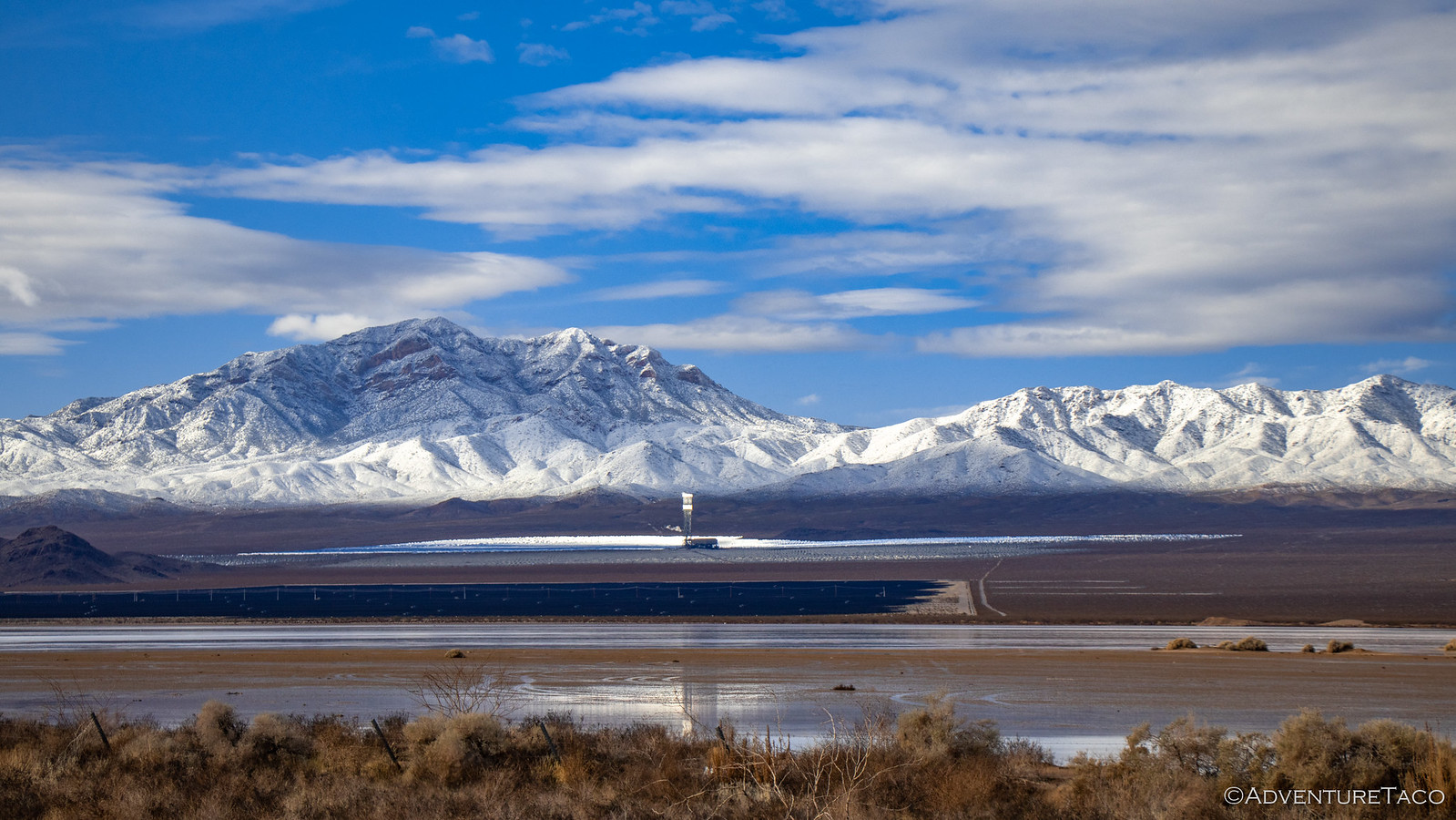
It turns out we needn't have pulled out of traffic - our designated route was going to take us through the heart of the plant, not that we minded!
As we drove through the plant, we stopped several times to capture the towers, each one seemingly reaching toward their "mother sun," trying to please her with their brightness.
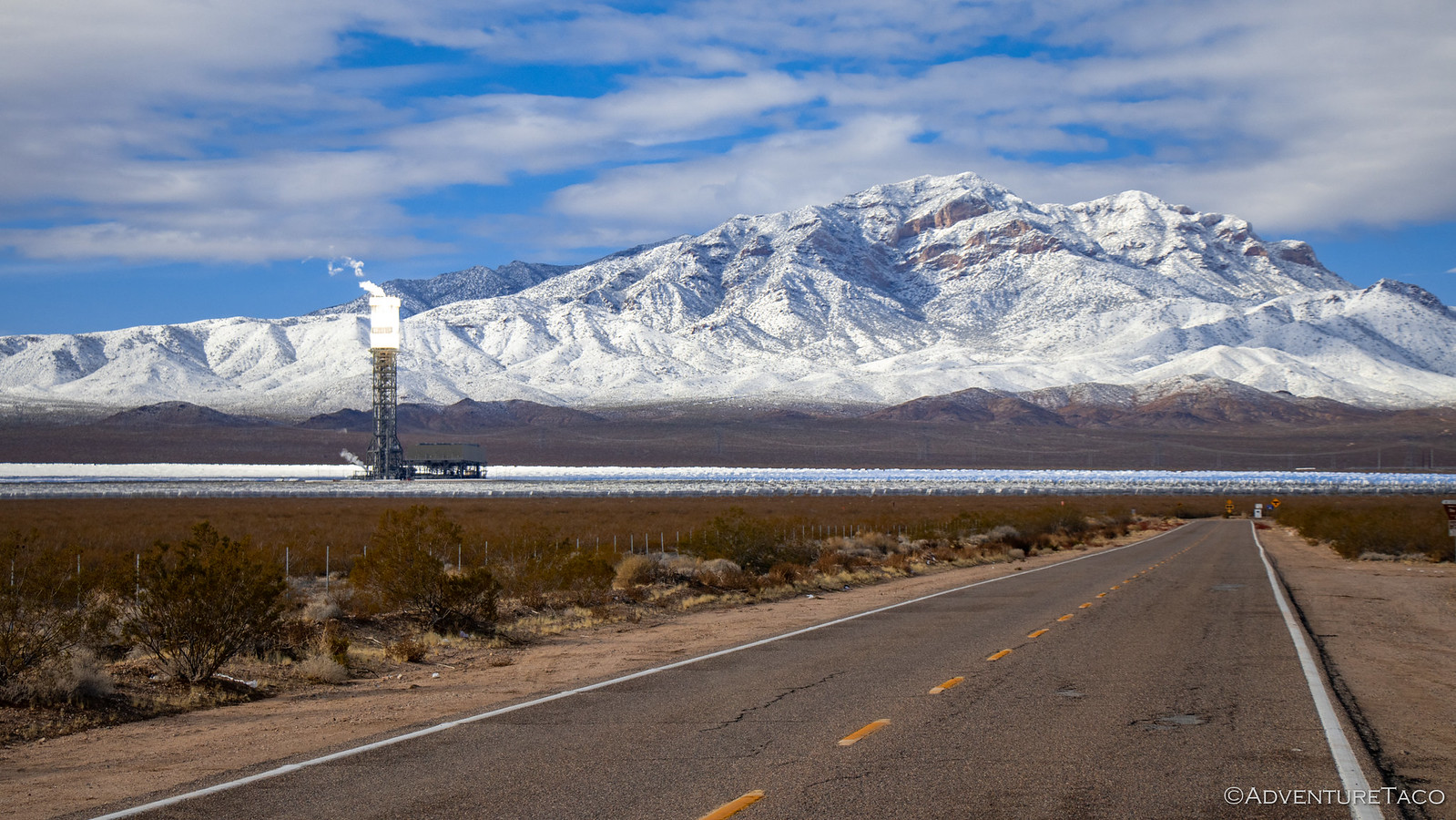

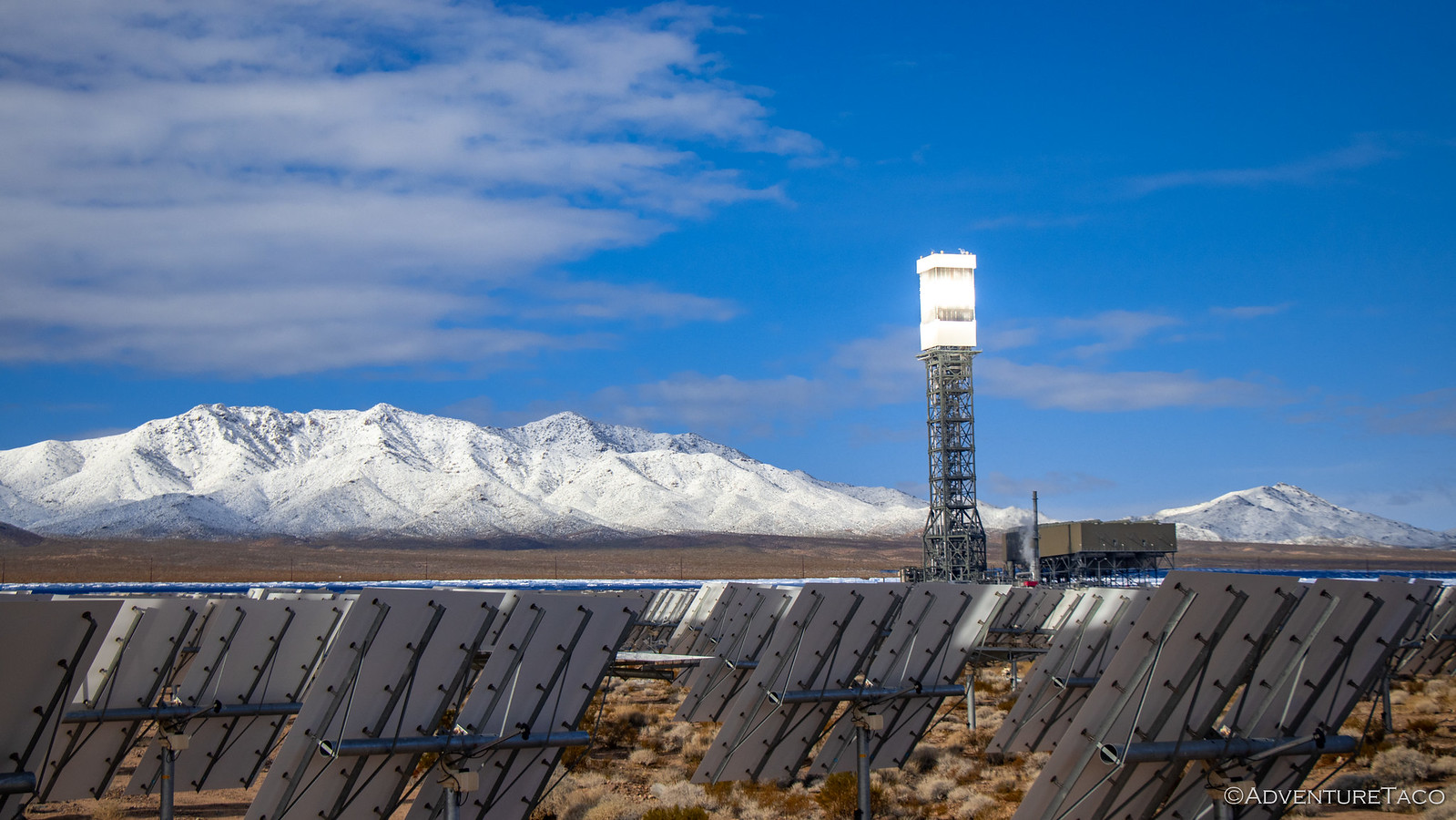
(in a weird voice) "I'm here for you sun mother."
Now, as I previously mentioned, our first destination was the Colosseum Mine - high in the Clark Mountains - where we'd have lunch before dropping down the other side into Alaska Hills. However, as we neared the mountains, we were pretty sure that those plans were about to change.
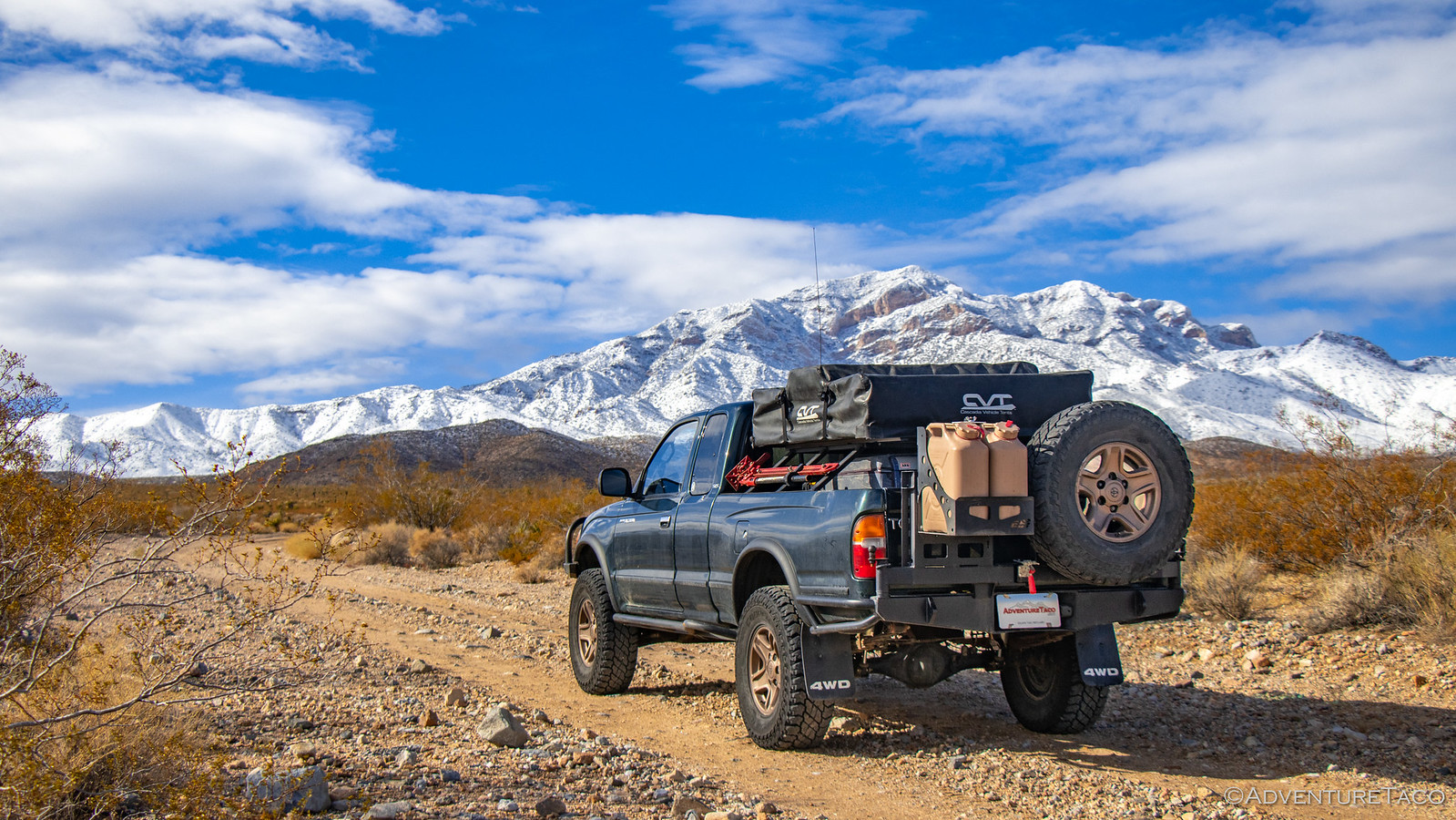
We hadn't hit any snow at 2500 ft, but by the time we hit 3000 ft, the white stuff was everywhere. It wasn't all that deep - and it was definitely beautiful - so we continued on.

The higher we went, the deeper the snow got. By 4000 ft, it was a good 8-inches deep; at 4500 ft, it was 10-inches - just deep enough that the rear diff was starting to drag a bit here and there. We still had another 1000 ft of elevation to go, and we could see that the road got steeper a head. Reluctantly, we made the call to abort our visit to the Colosseum Mine and Alaska Hills - because even if we'd made it, everything we'd planned to see was clearly under a foot or more of snow!
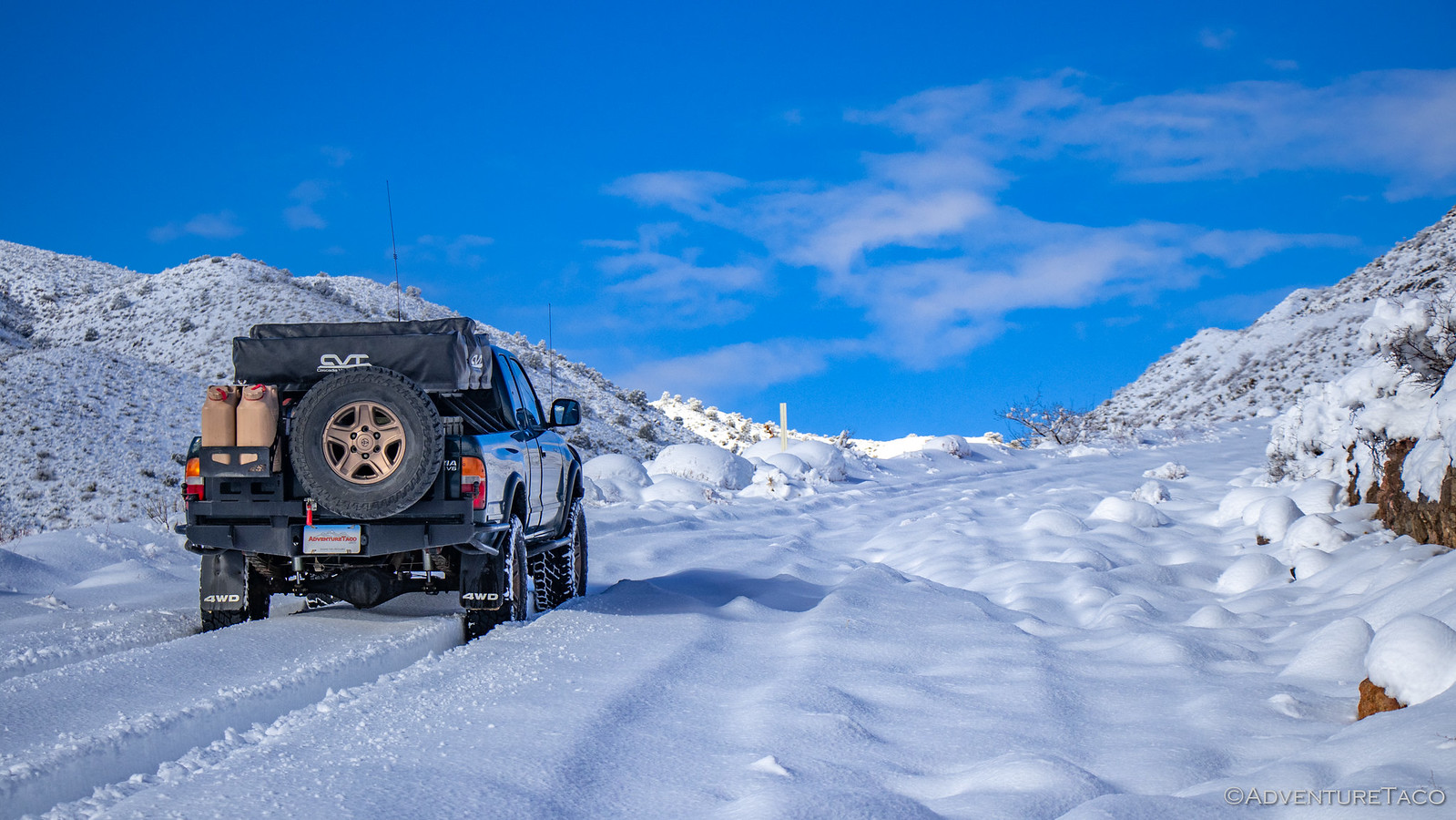
It was time to re-think our plan. We took a look at the route we'd planned - it was a clockwise loop starting from the northeast and working our way south, then west, until we finally reached Zzyzx in the northwest. That clearly wasn't going to work - with many of the initial locations in the 5000 ft range as far as elevation was concerned.
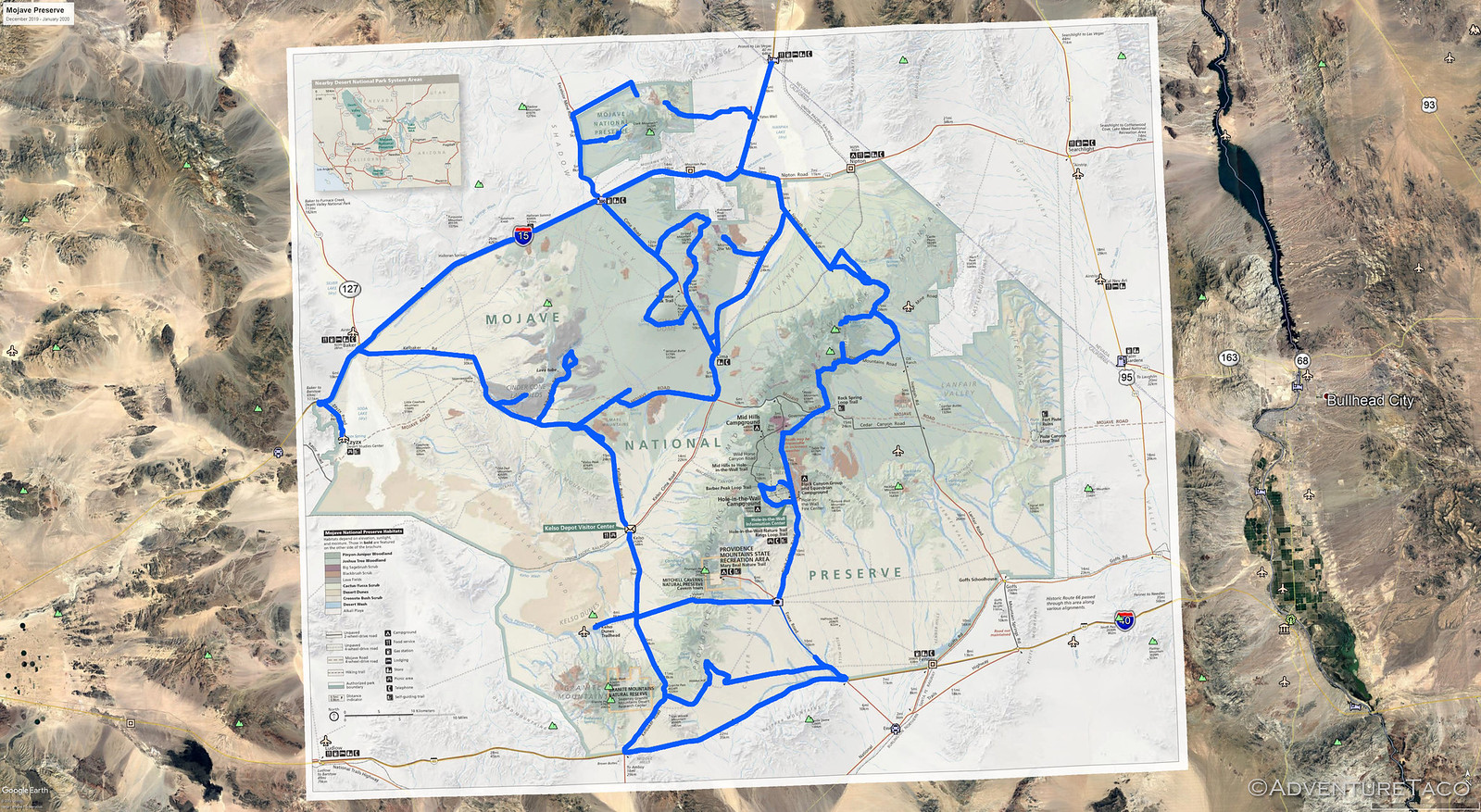
So instead, we headed west - towards some of the lower elevations - hoping that we'd find something salvageable. Otherwise, would we just head home and try again another time?! out:
out:
And - as we headed west on I-15 toward Shadow Valley - we noticed that Cima Dome seemed a little less snow-covered than we expected. Perhaps, just perhaps, we could start there - hiking to the top to get a view of the Mojave around us. So, with the Clark Mountains rising white behind us, we turned south and started down Cima Road.

Now, I will say that one of the nice things about all the snow is that it made the roads feel soft and fluffy even without airing down. As we arrived at our turn-off to hike Cima Dome, we saw a Jeep parked at the turn-off taking photos of the snow-covered side road. They were clearly sticking to the main drag in conditions like this. With a big smile on both our faces, we didn't even slow down - we just turned down the road and pressed the skinny pedal - it was hilarious!
We had several miles to go before the trailhead, and let me tell you - it was surreal. It's not often that you see the desert - Joshua Trees and all - covered in snow.


It was lunch time when we arrived at the corral that designated the end of the road, and the trailhead. This corral was put in place to protect a spring there - though with the gate left open, I don't think it was doing much in the way of protecting. I did a little exploring while @mrs.turbodb whipped up some quick PB&Js for us.
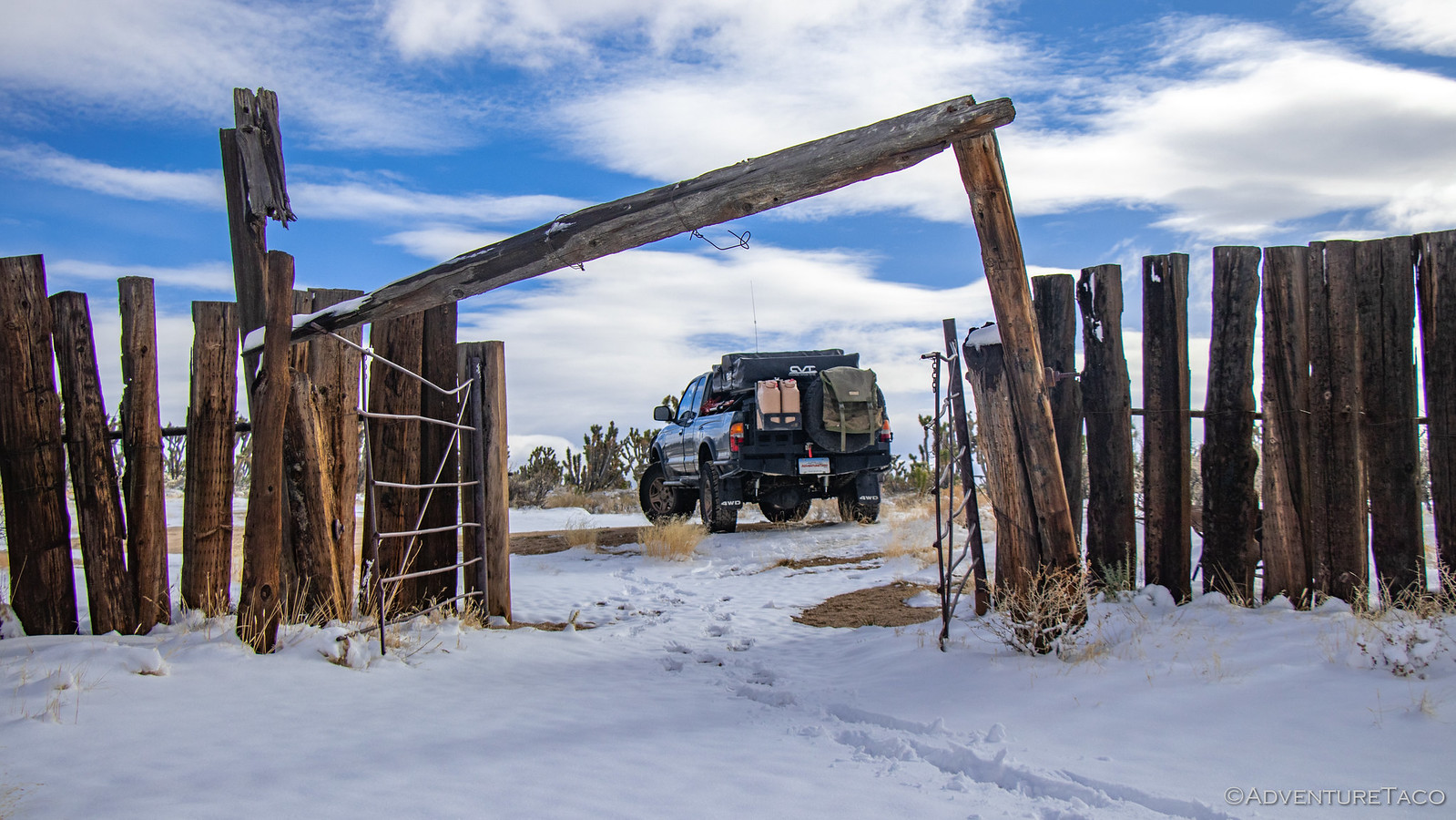
Our bellies happier, we set off. Cima Dome is an extremely symmetric dome that rises from 2100 ft to near 5000 ft over the course of a couple miles. As such, the hike is usually quite easy, as the incline is so gradual. But today was different. With six inches of snow on the ground, the 6-mile loop was a lot of work. So much in fact that we cut it short, turning it into a 4-mile out-and-back.
But, I'm getting a little ahead of myself.
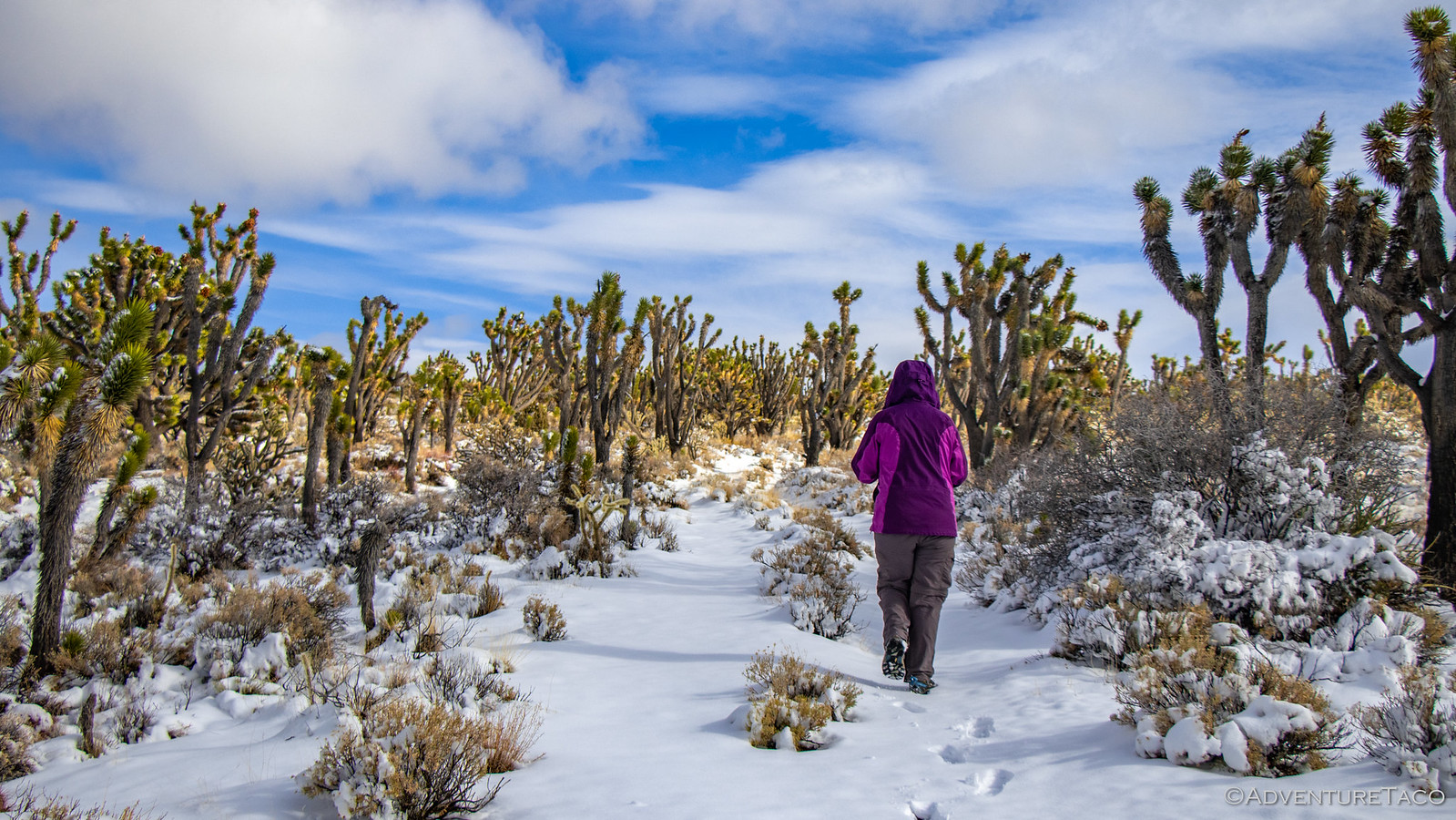
The top of Cima Dome was a little anti-climactic if I do say so myself. Its symmetry is intriguing, but is on such a large scale that - in real life - it's essentially flat. As such, it's hard to really get a good view any direction, and is therefore nice if you're looking for an easy hike in a Joshua Tree forest, but otherwise I think it's something that can be skipped if you're short on time.


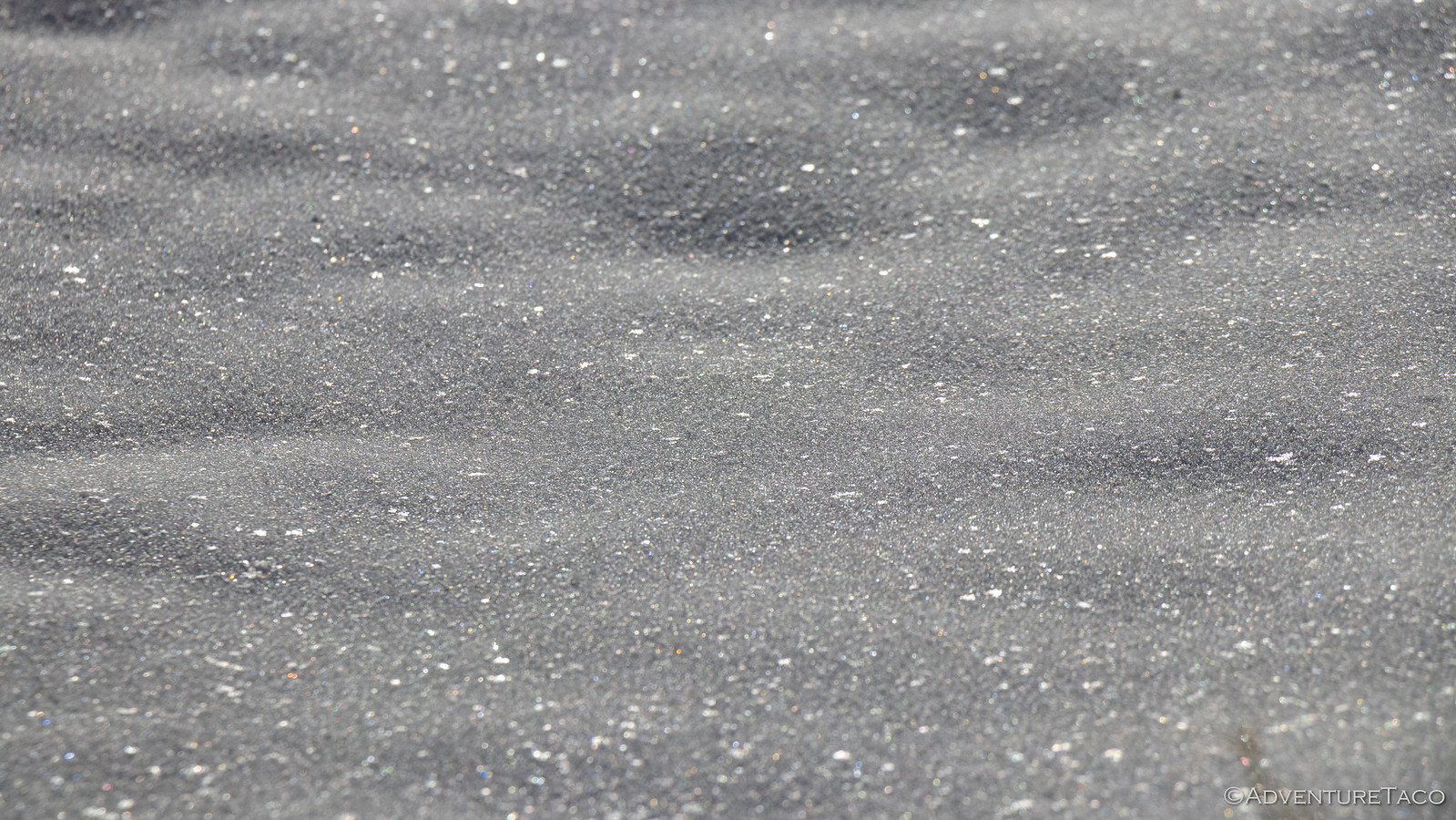
Soon enough, we were back down the mountain, and wondering where we'd go next. At 3:15pm it was getting late - relative to sunset at 4:30pm anyway - and so we decided that we'd head further west. That would take us down to more reasonable elevations - and camp along the Mojave Road, at the base of the Marl Mountains.

Along the way, the views were spectacular. I'm not sure they were once-in-a-lifetime, since it seems that the desert gets snow on a fairly regular basis - but they were rare for sure!
Don't miss the rest of the story, and all the remaining photos that don't fit here (due to max post size). Hopefully that can change in the future, but until then...
.
Part of the Mojave Redemption (Dec 2019) trip.
Camped in a casino parking lot, it was a noisy night - at least comparatively. But, by the time we woke up the rain had stopped, a light breeze was blowing, and the skies to the west - where we were headed - were mostly sunny!

The tent still needed a little drying, so I set about that task as @mrs.turbodb got breakfast ready to go. We ate while admiring the long line of cars still backed up on I-15, and then turned on the heater as we slotted ourselves into the line of traffic. Luckily, we only had a few miles to go before our exit - at the Ivanpah Power Station - which would lead us to the Colosseum Mine.
The Ivanpah Power Station it turns out is almost worth the trip alone. It's an amazing set of structures, literally lighting up the landscape. So dramatic was our first view - and I'm sure the snow-covered mountains in the background helped - that we pulled over on the side of the highway to snap a photo.

It turns out we needn't have pulled out of traffic - our designated route was going to take us through the heart of the plant, not that we minded!
[b said:wikipedia[/b]]Built between 2010-2014, the Ivanpah Power Station is a solar thermal power plant that uses nearly 175,000 mirrors to focus sunlight on three boiler towers to generate steam and power special turbines that generate electricity. Capable of producing 392 megawatts, it was built on public land as a joint project between California and the U.S. Government - at a cost of $2.2 billion. Ironically, despite being a solar thermal plant, it burns natural gas for several hours each morning to warm up the boiler towers, emitting nearly twice the pollution that California allows for power plants and factories.
As we drove through the plant, we stopped several times to capture the towers, each one seemingly reaching toward their "mother sun," trying to please her with their brightness.



(in a weird voice) "I'm here for you sun mother."
Now, as I previously mentioned, our first destination was the Colosseum Mine - high in the Clark Mountains - where we'd have lunch before dropping down the other side into Alaska Hills. However, as we neared the mountains, we were pretty sure that those plans were about to change.

We hadn't hit any snow at 2500 ft, but by the time we hit 3000 ft, the white stuff was everywhere. It wasn't all that deep - and it was definitely beautiful - so we continued on.

The higher we went, the deeper the snow got. By 4000 ft, it was a good 8-inches deep; at 4500 ft, it was 10-inches - just deep enough that the rear diff was starting to drag a bit here and there. We still had another 1000 ft of elevation to go, and we could see that the road got steeper a head. Reluctantly, we made the call to abort our visit to the Colosseum Mine and Alaska Hills - because even if we'd made it, everything we'd planned to see was clearly under a foot or more of snow!

It was time to re-think our plan. We took a look at the route we'd planned - it was a clockwise loop starting from the northeast and working our way south, then west, until we finally reached Zzyzx in the northwest. That clearly wasn't going to work - with many of the initial locations in the 5000 ft range as far as elevation was concerned.

So instead, we headed west - towards some of the lower elevations - hoping that we'd find something salvageable. Otherwise, would we just head home and try again another time?!
And - as we headed west on I-15 toward Shadow Valley - we noticed that Cima Dome seemed a little less snow-covered than we expected. Perhaps, just perhaps, we could start there - hiking to the top to get a view of the Mojave around us. So, with the Clark Mountains rising white behind us, we turned south and started down Cima Road.

Now, I will say that one of the nice things about all the snow is that it made the roads feel soft and fluffy even without airing down. As we arrived at our turn-off to hike Cima Dome, we saw a Jeep parked at the turn-off taking photos of the snow-covered side road. They were clearly sticking to the main drag in conditions like this. With a big smile on both our faces, we didn't even slow down - we just turned down the road and pressed the skinny pedal - it was hilarious!
We had several miles to go before the trailhead, and let me tell you - it was surreal. It's not often that you see the desert - Joshua Trees and all - covered in snow.


It was lunch time when we arrived at the corral that designated the end of the road, and the trailhead. This corral was put in place to protect a spring there - though with the gate left open, I don't think it was doing much in the way of protecting. I did a little exploring while @mrs.turbodb whipped up some quick PB&Js for us.

Our bellies happier, we set off. Cima Dome is an extremely symmetric dome that rises from 2100 ft to near 5000 ft over the course of a couple miles. As such, the hike is usually quite easy, as the incline is so gradual. But today was different. With six inches of snow on the ground, the 6-mile loop was a lot of work. So much in fact that we cut it short, turning it into a 4-mile out-and-back.
But, I'm getting a little ahead of myself.

The top of Cima Dome was a little anti-climactic if I do say so myself. Its symmetry is intriguing, but is on such a large scale that - in real life - it's essentially flat. As such, it's hard to really get a good view any direction, and is therefore nice if you're looking for an easy hike in a Joshua Tree forest, but otherwise I think it's something that can be skipped if you're short on time.



Soon enough, we were back down the mountain, and wondering where we'd go next. At 3:15pm it was getting late - relative to sunset at 4:30pm anyway - and so we decided that we'd head further west. That would take us down to more reasonable elevations - and camp along the Mojave Road, at the base of the Marl Mountains.

Along the way, the views were spectacular. I'm not sure they were once-in-a-lifetime, since it seems that the desert gets snow on a fairly regular basis - but they were rare for sure!
Don't miss the rest of the story, and all the remaining photos that don't fit here (due to max post size). Hopefully that can change in the future, but until then...
Keep reading the rest here
Mojave Redemption #2 - Should We Turn Around and Go Home?
Mojave Redemption #2 - Should We Turn Around and Go Home?
.
thezentree
pretend redneck
Even so, with two 10-hour days of driving in front of us, we didn't stop to smell the roses. We did find a closed truck scale however, and eager to see what the truck weighed after its winter weight loss program, I pulled in. At 5350 lbs, it's definitely a lot lower than the 5800 I'd run into previously. Of course, I wasn't in the truck for this photo, so... ?

450lbs is a pretty good diet. What else did you ditch besides the 110lbs in your Winter Weight Loss post?
turbodb
Well-known member
Probably just slightly different packing and human count in the truck. The two of us account for ~290 lbs, and then another 110 from thw weight loss brings it to 400lbs. So 50lbs somewhere of gear, food, etc. Could have been running/not running the mid-skid even.450lbs is a pretty good diet. What else did you ditch besides the 110lbs in your Winter Weight Loss post?
turbodb
Well-known member
Mojave Redemption #3 - Cinder Cones and Sand Dunes
Part of the Mojave Redemption (Dec 2019) trip.
The night was chilly, but by using some Little Hotties inside our socks while we slept, we were able to stay nice and toasty in the tent. Still in the shade since we'd parked reasonably close to the hillside to shelter us from the wind, we walked out into the desert to enjoy our breakfast and soak in the long rays of the sun as it peaked over the southeastern horizon. By the time we were done, the sun was just starting to hit the tent, and as @mrs.turbodb got the kitchen put away, I stowed the tent for our days activities.
Retracing a few of our steps from our first Mojave Road trip, one of the things I wanted to see was something we'd completely missed in the dense fog the last time we were here - the collection of frogs (and other figures) near the Mojave Mailbox. Heading west from our camp spot, the first thing we came on was the turn-off to Marl Springs. I had thought we'd found the springs last time, but it turns out I'd simply found some other ruin along the Mojave Road, so it was nice to discover the mouth to an old mine shaft, the spring itself, and an old arrastre this time around.


The spring, at Marl Spring.
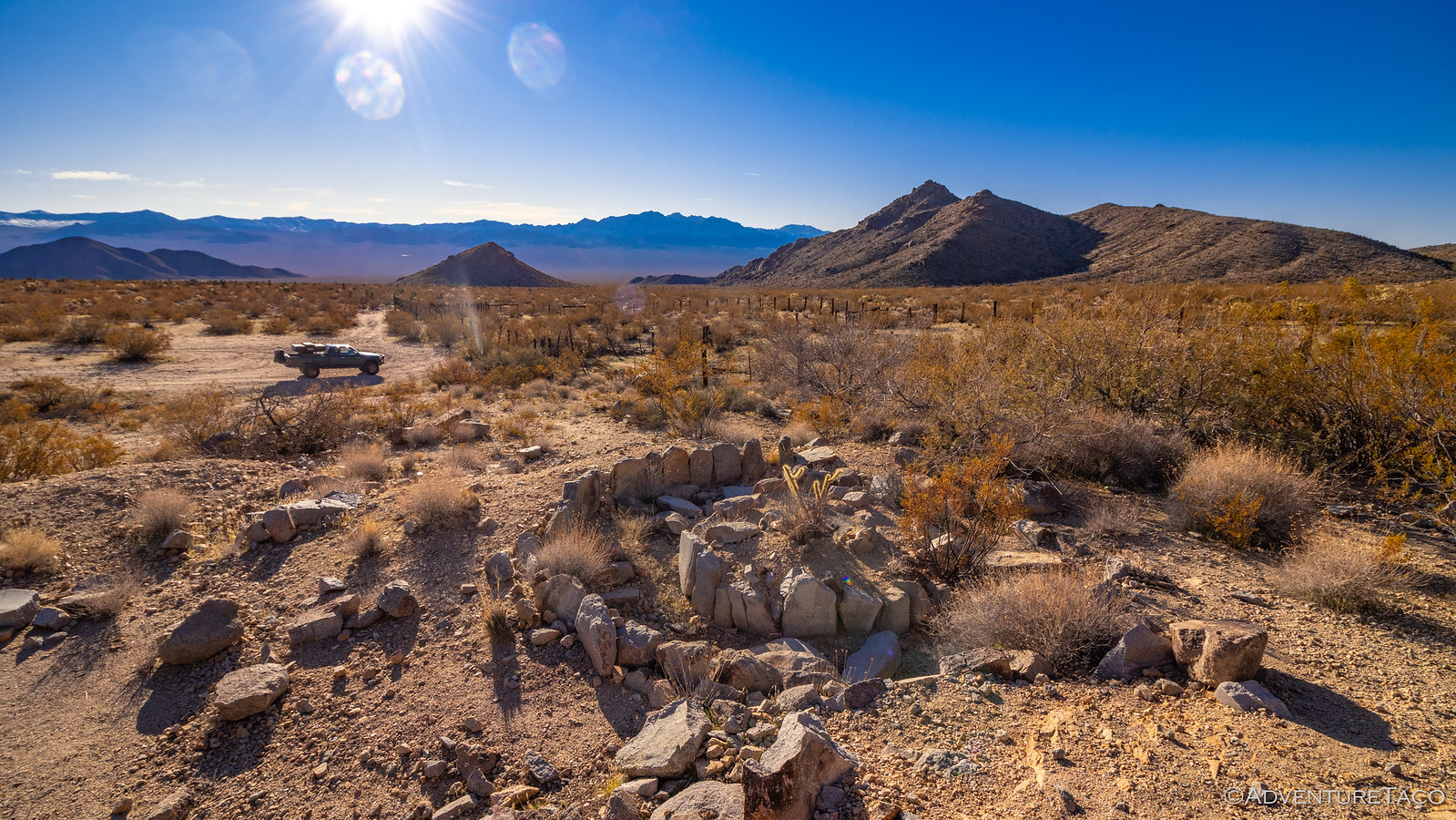
An old arrastre, where donkeys would drag stones in circles to crush gold ore.
From Marl Springs, it isn't much further to the Mojave Mailbox, and our only stop along the way was along the top of a low ridge where we'd transitioned from sun to pea-soup fog the previous year.

And with that, we reached the mailbox - looking as snazzy as ever out in the middle of the desert. As always, we took a look through the various trinkets and left a note for future travelers.
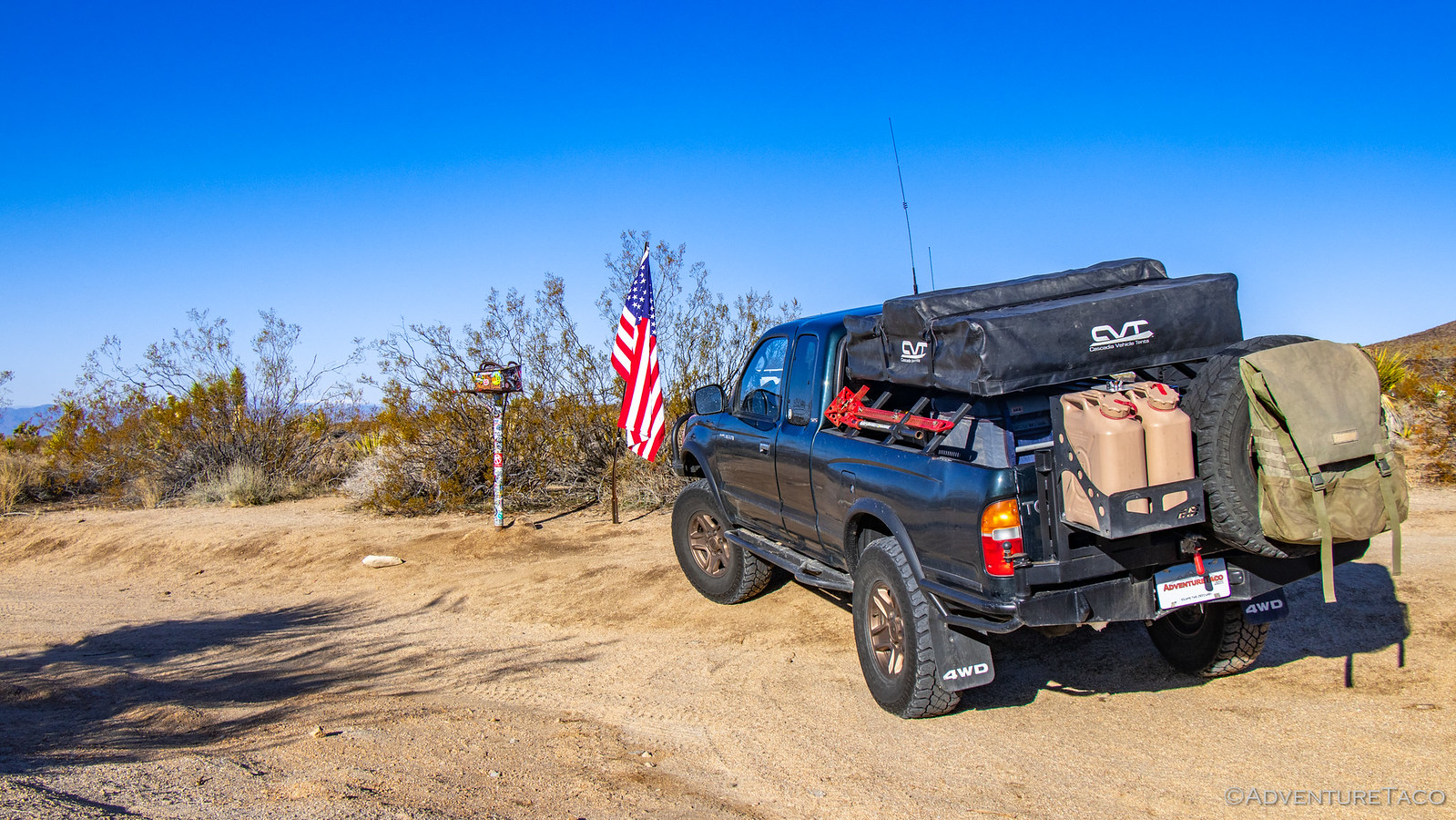
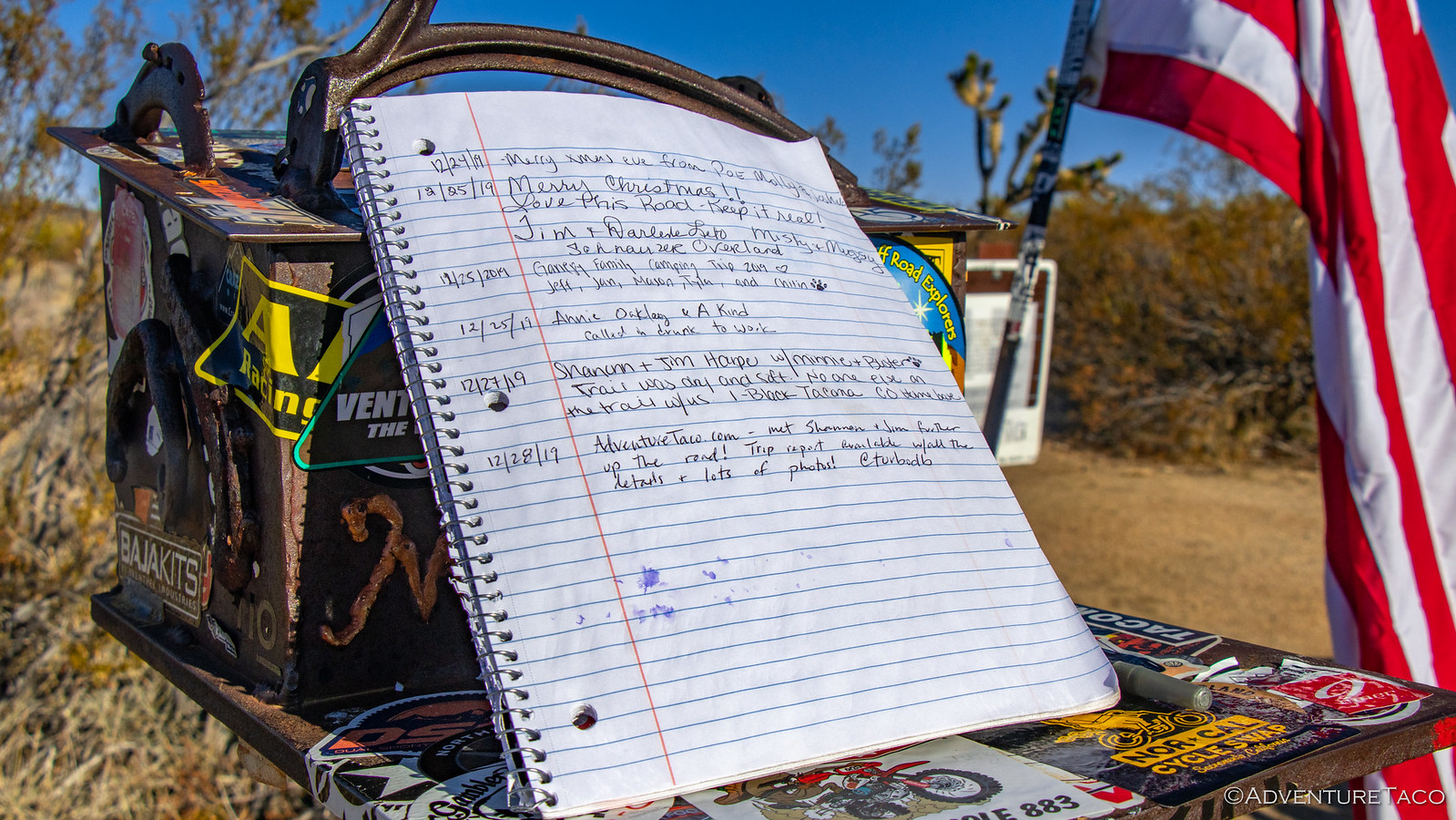
But that's not why we were here - we were here to see the collections of figures that have taken up residence behind the mailbox over the last several decades. There are several groups, the most famous of which are a group of frogs - but we explored them all, the trucks and gnomes also bringing smiles to our face .
.
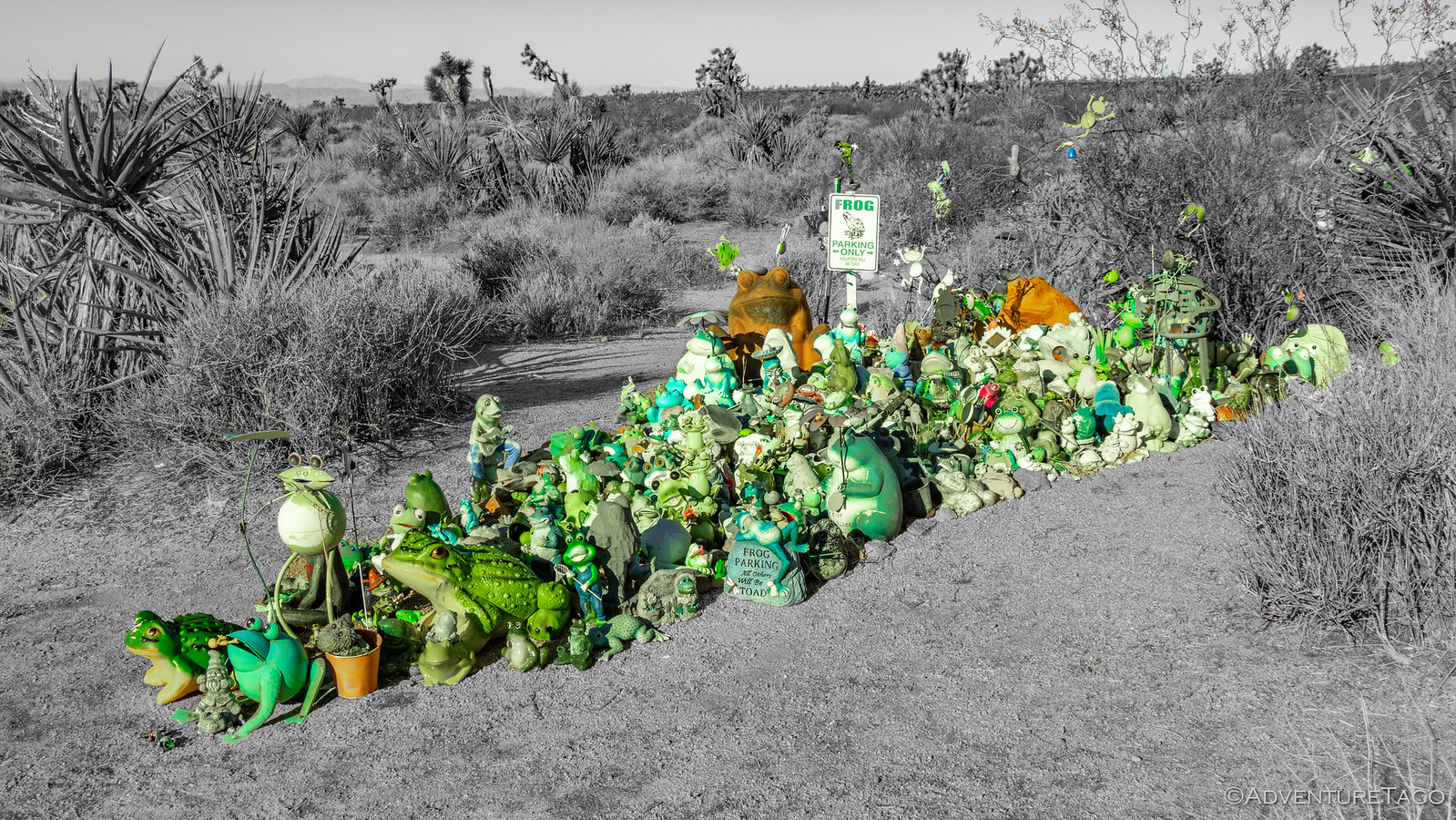

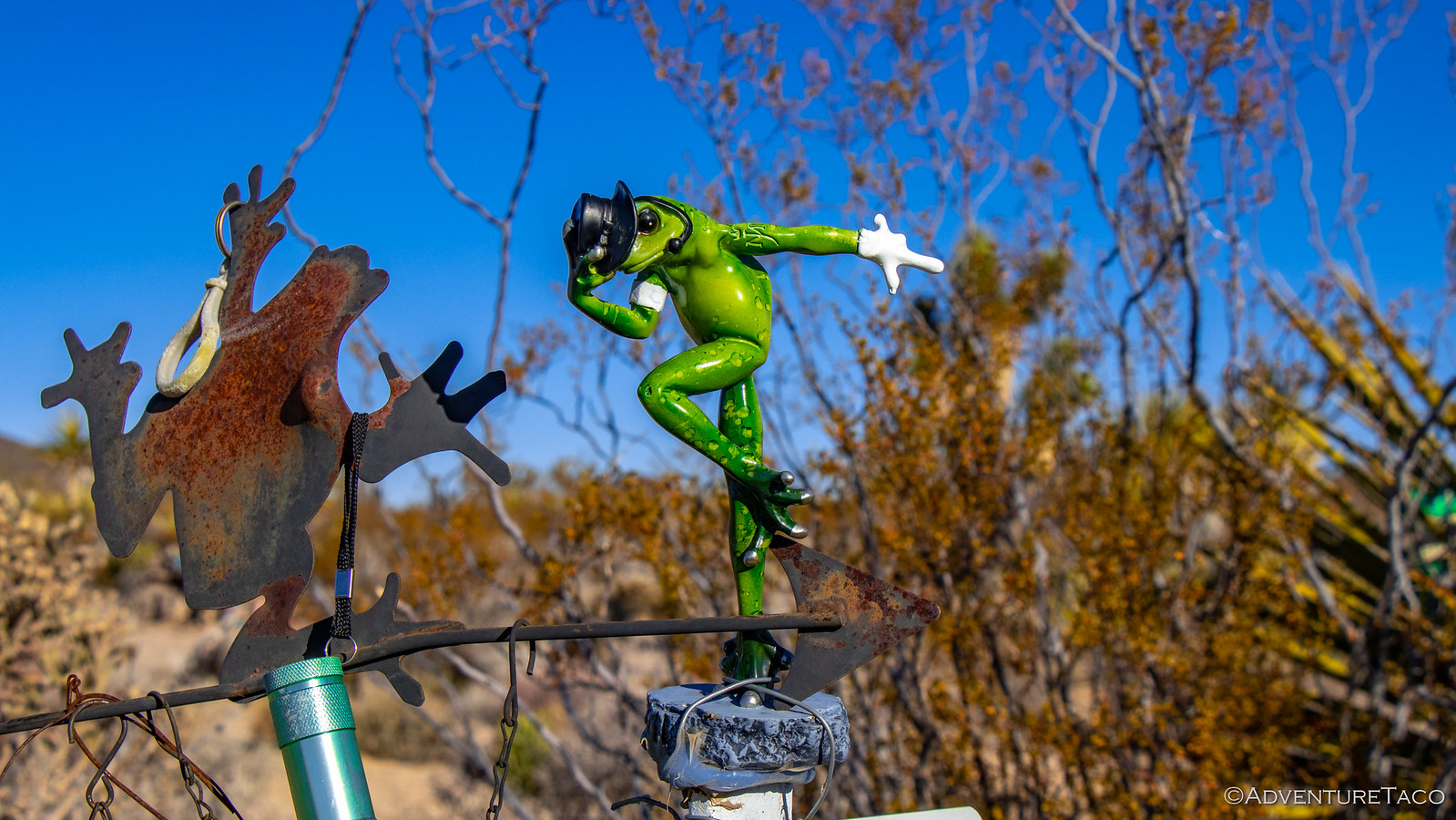
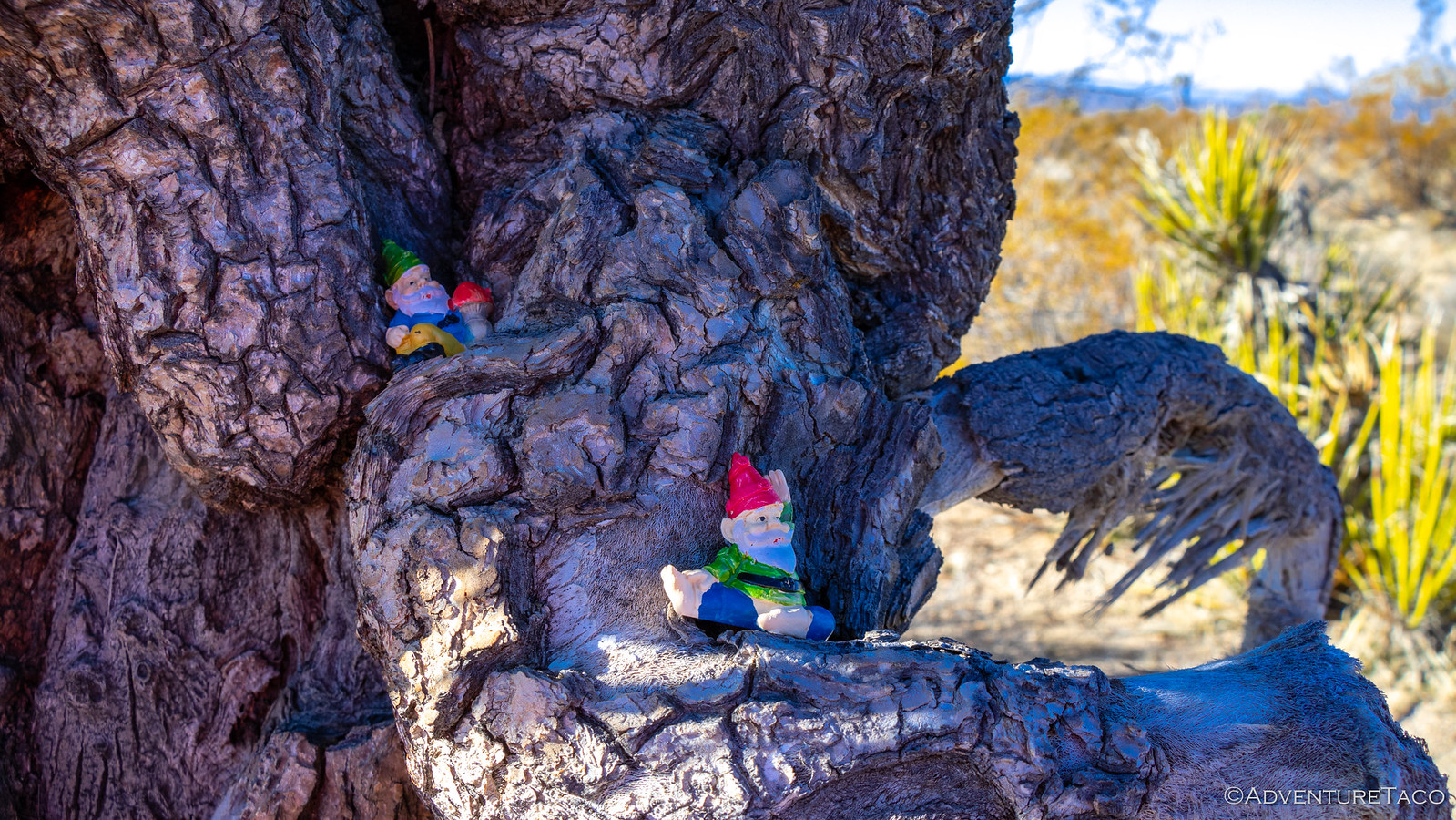

As it turns out, these collections are being removed by the National Park Service (NPS) in February 2020, and a sign at the location states as much. I'd heard about this from various internet rumblings prior to our visit, and initially felt like it was a bit of a bummer. In my mind the collections weren't really doing any harm, though of course I understood that they aren't natural and so don't technically belong. I also thought that it'd probably only be a matter of time until people started other, new collections!
I've since discussed with more reliable sources, and it sounds like there are some good reasons for the removal - and that even in the removal, all is not lost. In fact, the NPS is going to transfer the figurine collections to the Mojave Desert Heritage and Cultural Association Museum in Geoffs, where they will create a replica of this section of road, complete with the frogs, trucks, and gnomes! So, that's pretty cool.
From the mailbox, we could clearly see that another place on our agenda was snow-free, and so without further ado we continued down the Old Mojave Road until we hit the pavement that is Kelbaker Road. From there, it was just a quick jaunt north to our turn off on the Aiken Mine Road towards the Cinder Cones.
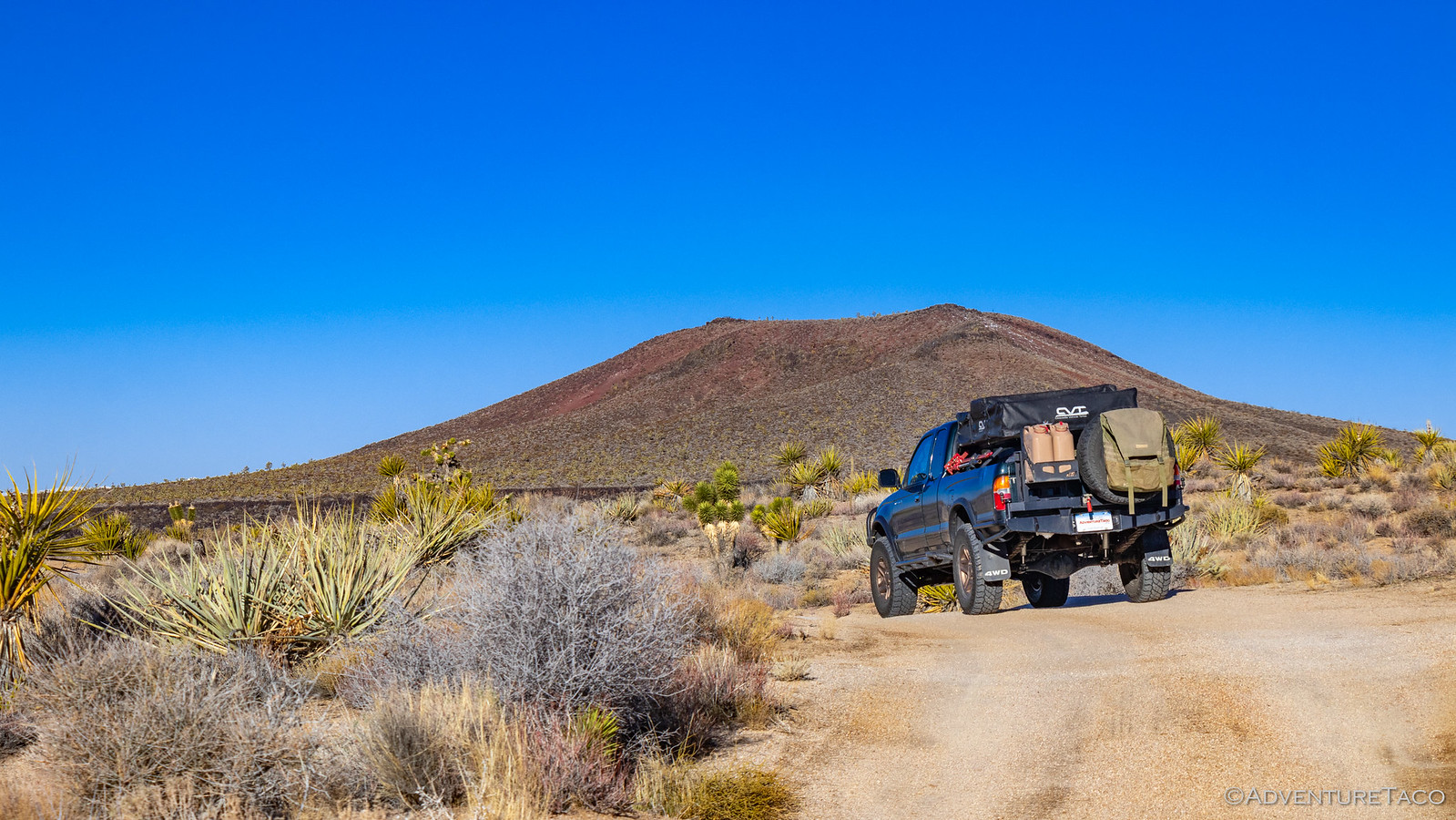
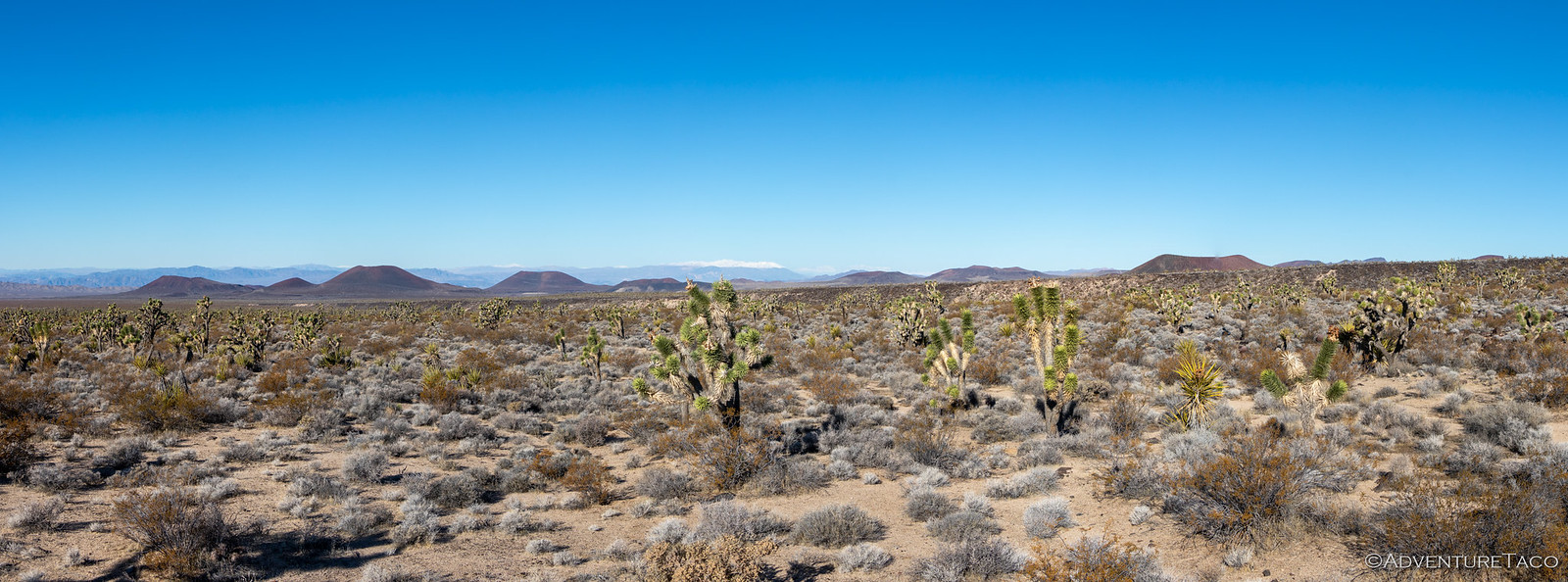
We had three stops planned here, but our first stop along this route was not for a cinder cone at all - rather, it was for a lava tube that's been made accessible for exploration with the installation of a metal ladder that ushers curious hikers down into the depths of the earth.

The lava tube itself is formed when molten lava flows down a slope and its exterior cools enough to solidify. Inside this crust, the lava is still molten and flows through its own self-made pipe. In situations where the lava all drains out of the tube - and the tube isn't filled by a future flow - a hollow lava tube remains for future explorers to discover. In the case of this tube, two skylights (cave-ins) exist in addition to the main access - also a cave-in - making for some dramatic photos when the lighting is right.

The tube itself isn't long - perhaps only a couple hundred feet - so we were soon off to our next volcanic destination - the Aiken Cinder Mine. One of several cinder mines in the 60-square mile region, it's one of the best preserved, having been abandoned in 1990 when it was no longer financially solvent. Prior to that, it'd been in operation for nearly 40 years, hauling out on the order of 1.28 million tons - the volume of a tall building - of cinder, used for construction in Las Vegas and southern California. Much of the mines machinery still stands dormant now 30 years later, as do 8 million tons of additional cinder that have been stockpiled around the property, waiting for the day that the price of the material might rise high enough to make its sale profitable. (from Hiking the Mojave Desert: The Natural and Cultural Heritage of Mojave National Preserve)

The loading chutes at the Aiken Mine. Here, trucks would be filled with cinder blasted from the cone.

Machinery of the Aiken Mine.

Remains of an old generator used to run the Aiken Mine's machinery. At nearly 6' tall, this yellow engine is a beast!
Don't miss the rest of the story, and all the remaining photos that don't fit here (due to max post size). Hopefully that can change in the future, but until then...
.
Part of the Mojave Redemption (Dec 2019) trip.
The night was chilly, but by using some Little Hotties inside our socks while we slept, we were able to stay nice and toasty in the tent. Still in the shade since we'd parked reasonably close to the hillside to shelter us from the wind, we walked out into the desert to enjoy our breakfast and soak in the long rays of the sun as it peaked over the southeastern horizon. By the time we were done, the sun was just starting to hit the tent, and as @mrs.turbodb got the kitchen put away, I stowed the tent for our days activities.
Retracing a few of our steps from our first Mojave Road trip, one of the things I wanted to see was something we'd completely missed in the dense fog the last time we were here - the collection of frogs (and other figures) near the Mojave Mailbox. Heading west from our camp spot, the first thing we came on was the turn-off to Marl Springs. I had thought we'd found the springs last time, but it turns out I'd simply found some other ruin along the Mojave Road, so it was nice to discover the mouth to an old mine shaft, the spring itself, and an old arrastre this time around.


The spring, at Marl Spring.

An old arrastre, where donkeys would drag stones in circles to crush gold ore.
From Marl Springs, it isn't much further to the Mojave Mailbox, and our only stop along the way was along the top of a low ridge where we'd transitioned from sun to pea-soup fog the previous year.

And with that, we reached the mailbox - looking as snazzy as ever out in the middle of the desert. As always, we took a look through the various trinkets and left a note for future travelers.


But that's not why we were here - we were here to see the collections of figures that have taken up residence behind the mailbox over the last several decades. There are several groups, the most famous of which are a group of frogs - but we explored them all, the trucks and gnomes also bringing smiles to our face





As it turns out, these collections are being removed by the National Park Service (NPS) in February 2020, and a sign at the location states as much. I'd heard about this from various internet rumblings prior to our visit, and initially felt like it was a bit of a bummer. In my mind the collections weren't really doing any harm, though of course I understood that they aren't natural and so don't technically belong. I also thought that it'd probably only be a matter of time until people started other, new collections!
I've since discussed with more reliable sources, and it sounds like there are some good reasons for the removal - and that even in the removal, all is not lost. In fact, the NPS is going to transfer the figurine collections to the Mojave Desert Heritage and Cultural Association Museum in Geoffs, where they will create a replica of this section of road, complete with the frogs, trucks, and gnomes! So, that's pretty cool.
From the mailbox, we could clearly see that another place on our agenda was snow-free, and so without further ado we continued down the Old Mojave Road until we hit the pavement that is Kelbaker Road. From there, it was just a quick jaunt north to our turn off on the Aiken Mine Road towards the Cinder Cones.


We had three stops planned here, but our first stop along this route was not for a cinder cone at all - rather, it was for a lava tube that's been made accessible for exploration with the installation of a metal ladder that ushers curious hikers down into the depths of the earth.

The lava tube itself is formed when molten lava flows down a slope and its exterior cools enough to solidify. Inside this crust, the lava is still molten and flows through its own self-made pipe. In situations where the lava all drains out of the tube - and the tube isn't filled by a future flow - a hollow lava tube remains for future explorers to discover. In the case of this tube, two skylights (cave-ins) exist in addition to the main access - also a cave-in - making for some dramatic photos when the lighting is right.

The tube itself isn't long - perhaps only a couple hundred feet - so we were soon off to our next volcanic destination - the Aiken Cinder Mine. One of several cinder mines in the 60-square mile region, it's one of the best preserved, having been abandoned in 1990 when it was no longer financially solvent. Prior to that, it'd been in operation for nearly 40 years, hauling out on the order of 1.28 million tons - the volume of a tall building - of cinder, used for construction in Las Vegas and southern California. Much of the mines machinery still stands dormant now 30 years later, as do 8 million tons of additional cinder that have been stockpiled around the property, waiting for the day that the price of the material might rise high enough to make its sale profitable. (from Hiking the Mojave Desert: The Natural and Cultural Heritage of Mojave National Preserve)

The loading chutes at the Aiken Mine. Here, trucks would be filled with cinder blasted from the cone.

Machinery of the Aiken Mine.

Remains of an old generator used to run the Aiken Mine's machinery. At nearly 6' tall, this yellow engine is a beast!
Don't miss the rest of the story, and all the remaining photos that don't fit here (due to max post size). Hopefully that can change in the future, but until then...
Keep reading the rest here
Mojave Redemption #3 - Cinder Cones and Sand Dunes
Mojave Redemption #3 - Cinder Cones and Sand Dunes
.
Similar threads
- Replies
- 67
- Views
- 5K
- Replies
- 6
- Views
- 743
- Replies
- 1
- Views
- 601
- Replies
- 2
- Views
- 975

